

Writing Prompts & Inspiration
Blogs about writing, mindfulness, and self-care.

Welcome to the Write Your Journey blog!
When I quit my university job to write full time, I planned to become a travel writer. Life’s circumstances forced me to focus on a very different kind of journey: the inner journey.
On my blog I write about anything to do with writing, wholehearted living, mindfulness, meditation and self-care. I also post the occasional travel article and anything else I think you might find inspirational.
Here are a few of my most popular blog categories to help you easily find the advice and inspiration that you are looking for.
Most Popular A collection of articles my readers enjoyed the most

10 essential life lessons this decade has taught me
The end of the year is always a good time for a little introspection and internal decluttering. This year I started with a decluttering frenzy of the little bolthole at the back of my Airbnb/home where I keep my personal belongings in cyclone proof boxes. As I held a...

Why luck had nothing to do with my self-directed life
You are so lucky. I hear it all the time. I bet you are thinking it now, looking at my photos. But let me tell you, luck had very little to do with the self-directed life I have created for myself. Yes, I live in an idyllic place, surrounded by rice fields, within...

Do you feel the urge to write? Why you can’t afford to wait.
Do you feel the urge to write? If you're reading this, you probably do. Here's a very simple piece of advice for those who do feel that urge to write: sit down and start writing already. Don’t wait for the time to be right, because it will never be right. I say this...

5 secret benefits of ageing we don’t talk about often enough
5 secret benefits of ageing I don't feel a day over 40, but I am inching closer to 60. Am I panicked? Nope. To be honest, I am quite looking forward to it. Maybe I am just lucky, but I don't worry about ageing. Truly. I never have. But I know plenty of people who do....
Latest Blogs Our most recent articles

Blissful Bali Writing Retreat – A Photo-essay
Run down of our inaugural Bali Writing Retreat June was indeed a blissful month that kicked off with my first collaborative writing retreat with dear friend and fellow writing and yoga teacher Edwina Shaw. Working with others can be tricky, but I had faith from the...

Always wanted to write a book?
If you've always wanted to write a book, make sure you read this first: It never ceases to surprise me how many people tell me that they’ve always wanted to write a book. Of course, it makes my heart sing, but be warned, between writing a book and thinking about it,...

The Healing Power of Writing: Finding Calm and Resilience in Difficult Times
When I was told that the man I loved, the man I had only just married, was going to die from cancer, I instinctively bought a journal. I needed to document my complicated feelings. Writing things down helped me hold on to the pieces of myself as I was falling...
Writing Advice My top advice for creating a regular writing practice that might just change your life

How to Start Writing Your Life Story
Everybody has a story that matters. Writing your life story creates a legacy for your loved ones and for future generations. It is also a way of examining your life a little deeper. Writing your story will help you recognise that you have lived a meaningful life and...

How to Write a Book Proposal for a Memoir
What I learned from writing the book proposal for my memoir I got so many questions about the book proposal I recently in 2021 as part of a retreat I took last year with London-based agent Jacq Burns, that I felt compelled to share with you what I learned from the...

How to Write When You Don’t Have Time | Tips for Writing When Life is Busy
"A word after a word after a word is power." -Margaret Atwood In March 2020 when a global pandemic was declared (remember that moment?!), I accidentally got stranded in Australia with only a carry-on. Suddenly I found myself in a remote place, living alone, during a...
Writing Prompts Creative writing prompts to kick-start your practice

5 writing prompts to declutter your head for more focus, productivity and happiness
Three years ago I radically decluttered my house, packed a backpack and moved to Vietnam. Living clutter-free is as liberating as Marie Kondo promises it to be. Now Airbnb guests enjoy my clutter-free and permanently tidy home, while I rent a sparsely furnished house...

5 easy ways to generate your own creative writing prompts
There's no such thing as a writer's block. If you're having trouble writing, well, pick up the pen and write. No matter what, keep that hand moving. Writing is really a physical activity.Natalie Goldberg You've always wanted to write, but you don't know how to start?...

7 fun ways to get your writing mojo back when the spark has gone
Feeling stuck and uninspired? Getting your writing mojo back is as simple as treating your writing practice like a lover. Seriously, to me writing feels very much like being in a relationship. You’ve got to nurture the flame to keep the spark alive. There is the...
Retreats Photo essays of past retreats & tips on the how and why of writing retreats

A solo writing retreat: why every writer needs one and how to do it
What is a solo writing retreat? A solo writing retreat is a set period of time when you make writing your exclusive focus. It requires that you take a vacation from your regular life—your day job, your family, your social media accounts—so that you can dedicate...

What to Do in Mission Beach | Our Retreat Guide!
This blog post is all about what to do in Mission Beach. Before I dig in, here’s a little backstory about my relationship with this beautiful part of Far North Queensland. In 2020, the Coronavirus Pandemic forced me to abandon my adopted home of Vietnam and rediscover...
Mindful Living Thoughts and inspiration on living more mindfully

No mud no lotus: simple mindfulness wisdom when things are tough
“If a lotus is to grow, it needs to be rooted in the mud. Compassion is born from understanding suffering.”“No mud, no lotus.” Thich Nhat Hanh. When things are tough and you can’t see the light, the simple mindfulness wisdom of a zen mantra can be the torch that...

Setting new goals: why you need to focus on the seeds you plant today
“Do not measure success by today's harvest. Measure success by the seeds you plant today.”Robert Louis Stevenson After the punishing heat of summer, autumn has finally arrived here in Hoi An with perfect timing. It comes just after the mid-autumn festival, Tet...

Sound Bowl Balancing explained: why it’s good for your Soul
Have you noticed the hype around Himalayan singing bowls lately? From New York to Bali, sound healing is touted as the latest cool thing to do alongside yoga and mindfulness meditation. Feeling a bit skeptical about it all? Don't worry, so did I just a few...
Lifestyle Posts Stories from my life, exploring the world and my inner self

What Iran has taught me about Mindfulness
This article was originally written for the travel writing competition "Fearless Footsteps" by Intrepid Times, about overcoming fear, real or imagined, when traveling. Overcoming Fear in Iran One Breath at a Time I am holding onto the metal side panel of the...

Vietnamese New Year: Photoessay & Writing Prompt
This photo essay for Vietnamese New Year was first published in February 2019. It was my first Tet, or lunar New Year, in Vietnam this year and I am still glowing from so much happiness and from the chance to start the new year twice. Tet is short for ‘Tet Nguyen...

My life isn’t as glamorous as you think: location independence is hard work
My life isn't as glamorous as you think: location independence is hard work That's what I wanted to say to a friend the other day when she called me ‘the busiest non-working person’ she knew. Non-working? Come again? I was flabbergasted. Incensed even. How dare she?!...

Subscribe to my newsletter!
Receive monthly writing prompts, inspiration, news about retreats & exclusive subscriber content.
How to write a blog post based on a personal story
By Brittany Taylor
How to write a blog post based on a personal story or experience
A step-by-step guide.
by Brittany Taylor
Last updated July 29, 2019
Most experiences we live through aren’t Aesop’s Fables, with one tidy moral separating one chapter from the next. Most experiences can be looked at through multiple lenses. These lenses dictate the topics we consider and the lessons we learn from what we go through on a daily basis.
When you audition experiences to use in your content marketing, you want to begin by identifying the different lenses through which you could view the moment. These lenses will help you clarify a lesson that you can draw from the experience.
Once you pick one, you can then shape the experience—and the lesson—into a story, and then into a blog post, that your audience will find relevant to your brand and your marketing message .
Subscribe to inbox inspo!
Brainstorming prompts in your inbox every Monday
How to turn a story into a piece of relevant content.
Not ready to venture out on your own? No worries—I’m a hand-holder. Together, we’re going to walk through how to write a blog post based on a personal experience.
The game plan
I’m going to walk you through how to write a blog post that’s based on a personal experience you’ve had at some point during your life.
We’ll journey from experience to lens to story to lesson to final product. We’ll start with one of my own experiences and break it down right here into three different directions the blog post could take, depending on how we interpret the experience and craft it into a story .
Here’s the personal experience we're going to use
Days after July 4 th , at 4:30 in the morning, my house was struck by lightning. I hadn’t fallen to sleep. My Goldendoodle, Georgie, bunks in my bed, and unfortunately for my beauty rest, he’s not big on storms—and this one was a biggie. We could hear the thunder come closer. It got louder, more insistent, until suddenly, the whole house shook. The fire alarms went off. Smoke filled the hall. And we got the hell out of there.
We’re all fine, and the house is fine. We moved back in about 10 weeks later, after wrangling a coterie of contractors to fix things up. And while this might sound like “the story,” we’ve barely even cracked the surface of possibilities.
Let’s take a look at the lenses through which we can view this experience, and the blog posts that might result from each particular lens.
Story example #1: Focusing on the fear response
Humans aren’t that far removed from the four-legged cuddle monsters we curl up with during thunder storms, and all of us are driven by instinct.
Fear is perhaps the strongest instinct that compels our behavior, signaling our fight-or-flight response. But not every prickle on the back of our necks—nor every fire alarm-like beep—is a reason to bolt. Good luck trying to explain that to Georgie, though.
Georgie has never liked alarms. The lightning strike hasn’t helped things. In fact, it reinforced his belief that beeps of all kinds are evil and ought to be done away with. And if that’s not a possibility, well, we ought to at least vacate the premises, stat. I can be watching gymnastics or Top Chef or Jeopardy. It doesn’t matter what the beep is or how little it resembles a fire alarm—he’s ready to go, and insistent that I come with.
It’s been a few months since the halls filled with smoke and we did, indeed, flee while the fire alarms blared. The time hasn’t made Georgie any more reasonable to my explanations about the fight-or-flight response or how that beep was really just a ding on the television signaling gymnasts to get the fuck off the beam. He is implacable, and I do have to give it to him: He was right, that one time. But just because the fear instinct that told him to GTFO was right on the money once doesn’t mean it’s the appropriate default response.
If only he would listen.
I’ve written about fear before . This story inspires me to write about fear in a different way. Before, I wrote about the things we fear. This post would focus on a different aspect of it: how we respond to events that remind us of trauma. Georgie responds to every alarm like it’s an emergency. And I, having experienced a house fire before, tend to panic when I smell smoke.
But just as every alarm doesn’t impend doom, nor does every whiff of smoke portend disaster—and that’s a lesson we have to remind ourselves of routinely so that we can squelch these instinctual responses and react rationally to the situation at hand.
The blog post
Even with the experience condensed into this particular lesson about fear, I could take the blog post in a bunch of different directions. And, though I write about business and communication, we can bring the theme of fear into just about any field.
Let’s take a look at the different shapes this post could take in different fields:
- Photography: “Bad experience in front of the camera? Here’s exactly how to ensure your next shoot goes smoothly—and you love the end results”
- Fitness: “How not to let the fear of a repeat injury hold you back”
- Coaching: “21 mantras to get you through fear flashbacks”
Whichever path we choose, the blog post itself could follow this format: an introduction that explains the fear response, a segue into personal stories on your business blog? Get inspired by these 4 creative entrepreneurs who are killing it professionally" style="font-size: 1em; font-family: Poppins, sans-serif;" target="_blank">the personal story (and then the story itself), followed by the educational portion of the post (the photoshoot tips, the workout encouragement, the 21 mantras).
Story example #2: Thinking about practicality and preparation
There are lots of must-dos for natural disasters: You should have 3 gallons of water in your car per person when evacuating for a hurricane. You should have a house evacuation plan, complete with meet-up point, in case of a house fire. You should stand in an interior doorway during an earthquake and in an interior room with no windows during a tornado.
For the comparatively trivial, every-day problems, like a corrupted hard drive or a hacked website, we tend not to have contingency plans in place when disaster strikes. And by then, it’s too late.
As a little girl, I had a series of recurring disaster nightmares. There was a hurricane, a tornado, a tsunami, and a house fire, and for each, dream-me had the evac all planned out (it involved packing my favorite Barbie dolls and their clothes into a very small suitcase).
When lightning struck my house and smoke stung my throat, though, real-me froze. Real-me didn’t know what to do or what to grab first. Laptop? Birth certificate? Pants? Pants. Pants were a good first step. Then shoes. Then the dog.
As I watched firemen stomp through the halls, I created a list in my head, a tidy in-case-of-emergency packing list. If only I’d packed the bag sometime before the storm rolled in.
We don’t know what to prepare for until we go through it—or someone tells us. This is one of those posts.
In many situations, your response time matters. Often it can lessen the impact of whatever disaster you’re working through. When you don’t have to scramble or Google or ask your favorite Facebook group for advice and can instead pull the must-dos out of your own brain, you’re one step ahead.
The blog posts
See? There’s so much more to take from this experience than “lightning struck my house.”
With this story angle, I could take the blog post in any number of “prepare for disaster!”-type situations. For my own brand, that could look like: “The 13 disasters every boss experiences—and how to ensure they don’t happen to you” or “What to do first when disaster strikes your business and you aren’t prepared to deal.”
Here are a few different takes for other industries:
- Food: “The most common kitchen mistakes and how to recover without scrapping all your hard work”
- Law: “Are you a liable? How to cover all your bases”
- Real estate: “15 signs of a bad DIY job to look for during a walk-through”
Story example #3: Myth of “I’m the only one”
I’m not sure if it’s humans in general or bosses in general or just the sort of humans and bosses I tend to make friends with, but we seem to be a self-isolating, pity party-throwing bunch. Regardless of the circumstance, we immediately think we’re all alone with our burdens when that couldn’t be further from the truth.
Shivering Georgie and shivering me were surrounded by my parents, my brother, and two trucks filled with firemen. Still, I felt terribly alone, as though no one understood the shock and trauma I was going through. Hours later, curled up in the guest room at a neighbor’s house that was packed with people, I felt tiny and huge all at the same time, like I was a dot in a sea of dots, but someone had highlighted me and drawn a bubble inside which was scribbled, “this girl’s house was struck by lightning!”.
Then I got up and saw another neighbor; his house had been struck, too. Another neighbor’s cable line was fried. It wasn’t just me. It wasn’t just us. The lightning stories trickled in. They disapproved the myth that “lightning never strikes the same place twice”—and that lightning strikes are a rarity. In a week, we were swapping storm stories with people across the area. Turns out it was a charged night for everyone.
It never hurts to be told that you’re not struggling through life by yourself. Even when the prevailing wisdom or research suggest that, statistically, your experience isn’t shared by that many people, there’s always someone who’s been in your shoes. Remember, there are 7.6 billion people on Earth! Even the tiniest percentage of individuals can yield thousands or millions of others who are like you.
And if you can’t find your crowd? Well, there’s always someone who will sit and listen and give you comfort, and that shouldn’t go unappreciated, either.
Part of life is these shared human experiences. They may not necessarily be “my house was struck by lightning,” but my story offers a natural transition to other experiences that tend to make us feel that we’re a party of one. An extension of this particular lens is the blog post format of “I survived this thing that happened and you can, too.”
Here’s how that could look for your brand:
- Education: “How to boost the confidence of a kid who’s lagging behind in class”
- Technology: “Where to find like-minded people on Instagram”
- Human resources: “32 stories from other people who have been fired (and then hired)”
Hello! My name is Brittany Taylor, and I am a ghostwriter based in Charleston, S.C.
Related / Share
More content like this
social media
WEBSITE ESSENTIALS
How to easily start a blog and make money in 2024
- Rebecca Strehlow
- 28 min read
Get started by: Creating a website → | Getting a domain →

If you’re wondering how to create a blog , you’ve come to the right place. As a blogger myself, I can tell you it’s a rewarding way to hone your writing skills, explore new ideas and build an online presence that revolves around your passions and expertise. You’ll get the chance to inspire, educate, and entertain your readers—and as your blog grows, you can even start making money and turn it into a full-time job or use it to start a business .
In other words, blogging is the first step toward finally pursuing your dream job or favorite hobby, so you really can’t go wrong. While starting a blog might seem daunting, I’m going to walk you through every step to make it as smooth and successful as possible. The process is actually quite easy, and you’ll have your blog up and running, as well as your first blog post written, before you know it.
In this step-by-step guide, you’ll find all the guidance and tools you’ll need to start a blog and get writing blog posts. You’ll learn how to make your website , write your first blog post and draw in loyal readers. Sounds exciting? Let’s dive in.
How to start a blog
Choose a blogging platform. Use a platform that offers customizable templates.
Pick a hosting platform. Consider a platform with good bandwidth, uptime and customer support.
Find the right niche. Narrow down your theme and have a specific audience in mind.
Select a blog name and domain. Choose a descriptive name that piques readers’ interests.
Set up and design your blog. Include imagery and effects that reflect your theme.
Brainstorm blog topics. Write down all your ideas before narrowing down topic selections.
Write your first blog post. Engage your audience with a killer title and use headers to make the content skimmable.
Create an editorial calendar. Create a calendar to help you publish consistently and hold yourself accountable.
Promote your blog. Use marketing strategies to expand your reach.
Make money blogging. Take advantage of opportunities to monetize your blog.
In this complete how to blog A to Z tutorial, we’ll cover everything from choosing your blogging platform to making money from your written work. With a little bit of guidance, you can get your blog online in 30 minutes or less.
This is going to be the most comprehensive advice you’ll find on building a successful blog from scratch. If you want to start a blog fast, though, feel free to use the numbered steps above as a quick cheat sheet. You can go directly to the step you need the most help with, or grab a cup of coffee and read it all the way through.
What is a blog?
While a blog can encompass an entire website or simply be its own section of a website, this is a place to share content about a topic you’re passionate about. A blog will typically include both written and visual elements published in an easy-to-read, article format so visitors can swiftly browse and find what they’re looking for. And with over 31.7 million blogs in the US alone, you can literally find blogs about every subject out there, from home renovation to baking to local business marketing strategies . Once you’ve established a community of readers, the possibilities are truly endless.
There's no definitive "perfect" time to start a blog. If you feel that you have the time and resources to start, manage and promote a blog and are enthusiastic about sharing your ideas with the world, it might be the right time to take the plunge and start your blogging journey. The sooner you start, the sooner you can learn and grow as a blogger.
Ready to start your blog now? Sign up with Wix today.
01. Choose a blogging platform
The first step in starting a blog is to select a blogging platform or Content Management System (CMS) for publishing your content. A quick Google search will show you that there are several different sites available that suit bloggers from all industries. I recommend Wix because it’s a good all-around blogging platform that satisfies most needs.
Wix’s blogging platform is fairly straightforward to get the hang of, and it offers a variety of attractive design options and templates to work with. In addition, it comes with features to analyze your blog’s performance and monetize your content, which will come in handy as you setup your blog and build your readership.

How much does it cost to start a blog?
When researching how to create a blog, one of the biggest questions people have is how much does it cost to start a blog . On many platforms, starting a blog is completely free .
You can decide at any point whether you’d like to upgrade to a variety of different plans, depending on your budget and needs. Learn more about how much does it cost to build a website.
02. Pick a hosting platform
Once you select your preferred blogging platform, you’ll need to choose a hosting platform. A blog, like other types of websites , requires a host. This essentially stores websites on a server under a unique address so that visitors can easily reach them.

faqOn some blogging platforms, hosting is already included, so you won’t need to find a separate web host when setting up your blog. In that case, you can skip this step and move to Step 3 .
With other website builders, such as WordPress, you will need to find and pay for a separate web hosting platform. Some popular options include:
If you’re not sure which web hosting platform to choose, take into account these factors:
Uptime: The amount of time that the server hosting your website is up and running. A strong uptime rate (99.95% or above) is a good indication that the host’s servers perform well.
Bandwidth: The amount of data your website can transfer to visitors over a certain period of time. This factor is based on the size of your website pages as well as the amount of traffic you expect. This quick bandwidth calculator can help you determine your site’s bandwidth.
Customer support: Customer service you can contact in the event something goes wrong. Ideally, your hosting provider should offer an online help center, offer callbacks and respond to questions and concerns on social media.
Once you’ve chosen your blogging platform and hosting provider, you can start coming up with your blog idea.
Don’t worry about picking and registering your domain name just yet. We’ll walk through that process together in Step 4 .
03. Find the right profitable blog niche
Let’s move away from the technical and dive into the more theoretical. Take a step back and think about the main element that will form the foundation of your blog, from its URL and domain name to its content and design: your blog’s niche. What, exactly, do you want your blog to be about?
There is virtually no limit when it comes to your choice of subjects. The most crucial thing is that you select a specific topic area that will be the central focus of your entire blog and its content strategy.
Possible blog types range from fashion blogs to real estate blogs to book blogs or food blogs . Because there are lots of other blogs focusing on the same subjects, you’ll need a way to stand out while still writing about what you love.
Here are three simple steps for choosing the perfect blog niche —one that not only is in line with your passions, but one that you can also monetize and grow:
Narrow down your interests
Research your audience, check if it’s profitable.

When you start a blog, think long term. To motivate yourself to blog regularly, you’ll need to write about something you’re genuinely interested in. If you choose a topic solely on the basis of its being popular or profitable, your efforts will peter out pretty quickly, along with your entire blog content strategy.
If you aren’t sure right off the bat what you should be blogging about, that’s okay. Begin with a simple brainstorming session about subjects you like. What do you get excited talking about? What are you eager to learn more about?
Now, write down the first five to 10 interests that come to mind. For the sake of this example, let’s say:
Next, think about your more specific interests within these subject areas and add them to your list. Your additions might look something like this:
Backpacking in Southeast Asia
Vegan recipes
Raising twins
Indie rock music
Hiking in the Rockies
Don’t worry about these niches being perfect just yet. You’ll research them more thoroughly in the next steps. (However, if you're looking for inspiration, check out how these popular art blogs are using their platforms to connect with audiences who share a similar passion.)
The next step of starting and creating a blog is to learn which topics people are interested in reading about. If your blog gains traction, you can eventually start making money from it and become a full-time blogger.
You can determine the demand for any given niche with a bit of market research. Begin by taking a look at Google Trends , which shows you how many people are searching for a particular topic. The more searches a topic gets, the more public demand it has.
For instance, let’s type “vegan recipes” into Google Trends. In the image below, you’ll see that there’s a relatively stable level of interest in this topic, so it’s a good candidate for a blog niche.

“Paleo recipes,” on the other hand, has a much lower degree of interest. This doesn’t mean it’s a bad idea—some bloggers prefer to write for a more specific crowd if they have a unique specialty—but it does mean there are fewer people interested in that particular subject area.
If Google Trends reveals that interest in a subject area is either very low or declining, then that topic is unlikely to gain traction.
Whether you run a personal blog or a professional one, it’s a good idea to check whether your niche is profitable. Even if you’re starting out as a hobby blogger or want to create a fan website , you’ll want to think about future monetization options in the event that your blogging efforts evolve into a career.
There are multiple ways to earn money as a blogger, but one of the most common methods is affiliate marketing. As an affiliate, you’ll work together with a specific company, providing a link to their products within your blog, and earning a commission for any sale made through your site.
Considering whether you could blog as an affiliate is a good way to figure out if your niche is profitable. Think about the kinds of “best of” or “how to” posts you might write. For instance, “Best kitchen appliances for easy cooking” or “How to make carrot cake in 10 minutes.” In both instances, you could include an affiliate link to your favorite food processor or electric mixer and make money for each purchase made through your blog.
You don’t need to plan out your money-making strategy just yet, but thinking generally about profitable opportunities can help you choose a niche. For now, focus on starting your blog—we’ll talk more about making money blogging in Step 10 .
04. Select a blog name and domain
As you think about how to make a blog, the question of what to name it is probably lurking somewhere in the back of your mind.
There are three main routes you can go with your blog's name. These include:
Your first and last name
The name of your business (if you have one)
A creative new name
When choosing your blog’s name, you should also think about the personality you want it to reflect. Should it be formal and professional? Sweet and romantic? Edgy and offbeat? If you’re stuck on names for your blog , this blog name generator is a helpful source of inspiration.

Once you decide, you should also go ahead and choose your domain name for your blog. Also referred to as a URL, a domain is a site’s address on the web (this website’s domain name, for example, is www.wix.com). Typically, your domain name will be the same as, or at least influenced by, the name of your blog.
If you really want your blog to stand out, consider a .blog domain extension . It's a clear and unique way to help your blog and content pop.
05. Set up and design your blog
Choose a blog template, decide which pages to include, get indexed on search engines, create a blog logo.
At this point, you’ve chosen a blogging and hosting platform, domain name and blog niche. You’re now equipped with all the basics for setting up your blog. Here's how to optimize your blog design :
The first part of setup for a blog is selecting a template. Like your blog’s name, its look and feel will be an important part of its personality.
The most efficient way to get your blog up and running is to choose a pre-designed blog template . Afterwards, you can customize it based on your preferences.
Be sure to pick one that conveys your blog’s subject area. There are website templates for bloggers of any genre, whether you’re a food blogger, photography blogger or business blogger. As you browse, think about the mood you want your website to communicate, for example. whether it’s classic, modern, rugged or minimalist.
You should also take that into account as you further personalize the template with your preferred colors. Color psychology plays a huge role in forming your audience’s impression of your blog. As you choose a color palette, keep in mind the feelings and attitudes that different colors evoke. Blue, for instance, tends to evoke dependability and trust, while yellow evokes energy and joy.
If you’re unsure of which templates to choose, these blog examples serve as a helpful source of design inspiration.
Once you’ve chosen a template, think about which pages to include. Most blogs include more than just a section to display their posts. They might also include an online store, as in the image below, or a contact page.

Here's an overview of the different options when designing your blog:
01. Contact page: This is a place to put your email address so that fans and potential business partners can reach out to you. You can also include a contact form so that people can send a message directly through your site.

02. About page: This tells visitors who you are, what you do, and why you do it, providing some context behind your blog and humanizing your content.

03. Online store: You’ll also want to add a separate online store page if you’re thinking of selling items related to your blog. You can call this page “Products” or “Shop.”

If you want to beef up your blog with even more pages, a Tutorials page, Now Trending page or Author’s Pick page are all popular options.
Furthermore, some blogs opt to place their posts directly on the homepage, while others keep their homepages and blog pages separate. If you do this, make sure to include a navigation menu so that visitors can easily access your blog as well as any other pages.
There’s no right or wrong way to set up a blog, so play around with different options to see what best suits your style and personality. Keep in mind that you can always add or remove pages over time as your blog evolves.
Another part of starting a blog is making sure it’s visible on Google and other search engines. This is crucial if you want your content to pop up in search results, so you’ll want to take care of this step right away.
First, make sure your site is indexed on Google. Essentially, this means giving Google a heads up that your blog exists. You can do this by submitting your sitemap to Google Search Console .
Pro tip: Google Search Console is not only important for indexing your site, but it’s also a valuable platform that you’ll be using throughout your blogging journey. It tells you important data about your blog’s site visitors and clicks, which you can use to improve your content.

To find out whether your site is already included in Google’s search index, do a quick site search (a site search uses your homepage URL and takes the form of site:yourblogname.com ). If your blog pops up in the search results, then your site is already indexed.
Finally, polish off your site with an attractive blog logo . This is another way to add personality to your site, and it’s an essential step if you want to create a blog that evolves into a recognizable brand.
One option is to design your own or outsource the task, but you can also use an online logo maker . These tools give you plenty of room to customize your logo with your preferred colors, fonts and icons, and tend to be quicker and more affordable than hiring a professional designer.
Once you create your logo, place it in the upper left-hand corner of your website, and link it to your homepage. This will help brand your content while improving the navigation experience for readers.
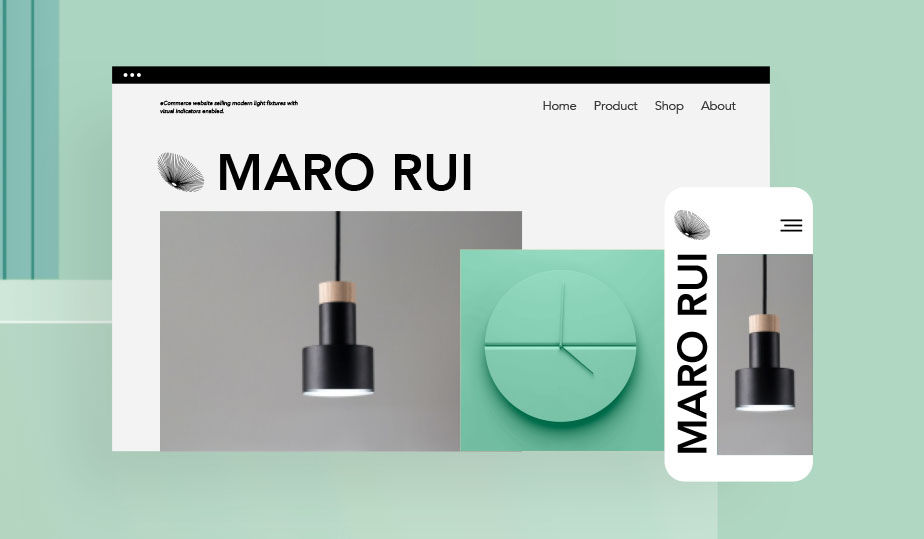
06. Brainstorm blog topics
On the technical side, your blog is now setup and ready to go. It’s time to start thinking about which topics you’ll get started with.
Begin by thinking about your experiences, successes, failures or discoveries related to your niche. What insights can you share? What ideas are you looking to explore in-depth?
As you think of topics, try to get into your readers’ heads. Here are some questions to guide you through the brainstorming process:
What characteristics does my target audience possess?
What subjects does my target audience get excited about?
What challenges does my target audience face?
You can also come up with ideas using the topic cluster model . Essentially, this is a tightly organized system that strings together related posts using a series of internal links. While this process is usually considered part of SEO, you can also think of it as a mind map for coming up with ideas.
By this model, think about a broad topic—say, recipes—and then divide that up into smaller subtopics, like dinner recipes or brunch recipes. Then, divide those up into even more specific topics, like 20-minute dinner recipes, mimosa recipes, and cake decoration ideas. Any of these topics could be its own blog post.

If you’re still stuck, this list of blog ideas can help jumpstart the brainstorming process. They include:
A 30 before 30 list (also 40 before 40, or 50 before 50)
Your sources of inspiration
Beginners’ guides
Time-saving hacks
A challenge you’ve faced
Use these ideas to guide you, but feel free to add your own creative twist based on your niche.
07. Write your first blog post
Start with keyword research, come up with a blog post title, outline your main points, write engaging content, insert images, optimize for seo, edit and publish.
Now that you’ve come up with ideas, you’re ready to dive into the writing. Let’s go over how to write a blog post from start to finish:
Finding the right keywords is crucial for getting people to read your posts. By targeting certain phrases with your article, you increase the chances of your blog appearing on search results pages for those queries.
Let’s say, for instance, that you want to share a carrot cake recipe in your blog. You’ll want to target keywords such as:
Carrot cake
Carrot cake recipe
Best carrot cake recipe
How to make carrot cake
Depending on your topic, some keywords may be more obvious than others. You can refine your keywords using free keyword research tools such as Google Keyword Planner or you can use more robust paid options like SEMrush or Ahrefs .

Next, you’ll need to strategically target your selected keywords throughout your article. This means two things: First, you’ll need to sprinkle those phrases throughout your post (but try to do so as organically as possible—no one likes unnatural keyword stuffing). Second, you should structure your article based on the format you see in the top 10 search results for those keywords (you can also reference these results when deciding how long should a blog post be ).
Let’s say, for example, that you want to write an article about your favorite carrot cake recipe. Start by checking your competitors—the top 10 search results on Google for the keyword “carrot cake recipe.”
When you type that phrase into the search engine, you’ll notice that the top results are written as numbered steps, rather than as a story. You can therefore assume that most readers prefer the list format for these types of posts. In order to provide valuable content to your readers—and to rank high on Google as a result—you’ll want your own post to assume a similar format.
Likewise, you’ll want to touch on all the main points covered by your competitors. This doesn’t mean you can’t be be creative. It’s just to say that in addition to sharing your own original insights, you should cover all the bases.
To continue with our example, let’s assume that when you look up “carrot cake recipe,” the top search results include a section about how to make cream cheese frosting. This is an indicator that many readers find this content helpful. In addition, it shows that Google has a preference for articles including that detail. You’d be wise, then, to touch on this idea in your own article.
Keyword research gives you an idea of the best format for your blog post, as well as which sections to include. This naturally segues into the outline stage of the writing process.
First, choose which type of blog post you’d like to write. Will it be a how-to guide? A product recommendation? An op-ed? Whichever blog post template you choose, you’ll want to have a clear idea in mind before structuring the outline.
Then, use headers and subheaders to break up your content into organized, bite-sized chunks. Beneath each heading, make bulleted notes of the main points you’ll include in each section. This will be the skeleton of your first blog post.
Feel free to use this downloadable blog post template to help with your outline. All you need to do is fill in the blanks:

The next part of starting a blog article is coming up with a strong title. You can come up with your blog titles at any stage of the planning process, but the best ideas often arise as you build your outline.
A blog title is a small but mighty piece of content. Often, it makes the difference between whether or not people click on your article.
To make your blog titles catchy and compelling, put yourself in your readers’ shoes. Think about what might interest and excite them, and try the following strategies:
Be clear and direct
Promise value
Appeal to your readers’ emotions
Pique their curiosity
Use humor, alliteration or wordplay
Here are a few fill-in-the-blank blog title ideas to help you:

Here’s more information on how to write a headline that stands out. If you’re curious about diving more into what makes a headline a success, Buzzsumo’s shared headlines study is also an insightful resource.
Now, it’s time to start typing away. Keep in mind that you’ll need an introduction, body text broken up by headers and sub-headers, and a conclusion (optional).
In the introduction, grab your audience’s attention with a captivating anecdote, a compelling quote or statistic, or an interesting fact. Then, share a brief summary of what the article is about, making sure to grab the interest of your readers.
Next, write the body text, using your outline as a guide. This is where you share your knowledge and expertise as a blogger. Be sure to avoid fluff; writing for the sake of writing is one of the biggest blogging mistakes . Instead, make sure each sentence is meaningful, and dive straight into sharing your original insights and actionable tips. You should also use a tone of voice that resonates with your audience, whether it’s funny and casual or serious and formal.
Finally, wrap up the post with a concluding section. While not every blog includes this final bit, it’s a nice way to tie your ideas together and share your closing thoughts.
Keep in mind that writing a blog post can take several hours, and it’s a process that shouldn’t be rushed. Set aside at least half a day to write your first draft.
There are quicker ways to research, plan and create blog content, if you choose to decide with AI content generation tools. There are several to choose from - including Open AI's Chat GPT, Google's BARD and others such as Jasper.ai. Just be sure to heavily edit any AI generated content, be on top of fact checking it's output and don't forget to bring your own voice and style to the content.
Write a blog post with AI
As AI content generators become more popular and as their output improves, considering whether to use AI to write blog posts is a valid question a lot of bloggers are asking themselves. AI content generation can speed up the blog writing process and help you create more, faster. However, in our experience, AI generated content still requires a large degree of human editing, fact checking and injecting of experience into it. So while it might help you create drafts faster, it's not going to be something you can publish fresh from an AI content generator.
However you can use AI for other parts of the blog writing process. You can use it to:
Create blog titles
Write meta titles and descriptions
Structure your blog articles
Help you proofread for grammar and spelling mistakes
As you start your blog, remember that your choice of images can strengthen readers’ overall impression of your article. Whether you add photos, screenshots or illustrations to your articles, they should be functional as well as beautiful. Make sure they convey your main points and highlight important examples in the post.
If you don’t have your own images, begin by browsing free stock photos on the web. Pexels and Unsplash are both popular sites for gathering visual material. While you might eventually want to use photos you take yourself, stock photos are a quick way to get your blog started.
Once you create your content, there are a couple things you’ll need to take care of before hitting Publish. These steps primarily revolve around strategy, from improving your blog SEO to generating conversions through your article. Here’s a quick post-writing checklist to guide you:
Double check your keywords: Quickly search your content (CTRL+F) to review your use of keywords. Did you include all the keywords you intended to? If not, check to see whether there are any other opportunities to incorporate the keywords throughout your article. (Keep in mind that keyword stuffing is considered a bad practice, and search engines can penalize you for it. Incorporate them naturally into the text, rather than forcing them in.)
Add internal links: One trick up every bloggers’ sleeve is to link between their blog posts (also known as the practice of internal linking). This helps improve your posts’ SEO, and it also encourages your readers to browse your other articles. Rather than linking randomly, you should link between primarily related blog posts; this is better for SEO, and it also makes the links more valuable to your readers. If you’re just starting a blog and don’t have much content yet, don’t forget to go back into your posts and add in the links later.
Incorporate CTAs: The next trick in the book is to include calls-to-action (CTAs) throughout the article. These little snippets of content often take the form of phrases such as Buy Now, Subscribe, or Read More. By placing call-to-action buttons in your article, you can direct readers to buy your products, subscribe to your newsletter, or click for further reading.
Use alt text: Because Google can’t read photos, bloggers often add a short description to each image (ideally using keywords) to help the search engine understand what is being displayed. This description, called alt text, helps your images show up in Google image searches.
Write your post’s metadata: Metadata is the term for the text used to display a web page in Google search results. This includes the meta title (also known as the title tag) and meta description. Sometimes, the meta title is the same as the title of your blog post, while other times, you’ll want to choose a slightly different title for displaying your post. There’s no right or wrong here, so long as your title is engaging and includes your most important keyword. The meta description, which is the short snippet of text beneath the meta title, should also include your main keywords and should preview the article’s main points.

Choose your URL: Every webpage has a dedicated URL, and your blog posts are no different. A strong URL helps your articles rank high on search engine results pages, and typically contains a keyword. Blog post URLs often take the form of www.yourdomainname.com/blog-post-keyword or www.yourdomainname.com/blog/blog-post-keyword .
You now have everything you need for your first blog post. Give it a couple reads, and share it with family members or friends to review. It’s always helpful to have a second, third, or fourth pair of eyes.
When you think your article is ready to go, upload it to your blog. Your blogging platform will also have a place for you to type in the metadata and URL. Once that’s done, hit Publish and let the celebrations begin.
08. Create an editorial calendar
Whew! You’ve just written your first blog post. Take a break, and when you’re ready, plan out the rest of the month’s posting schedule.
Creating an editorial calendar is an important part of starting a blog. It’s an effective way to ensure you publish content consistently, letting you hold yourself accountable as a writer and ensuring you don’t deviate from your blogging goals. Your readers want new content, and you need to deliver. Plus, search engines take into account how frequently you publish when determining your site’s overall ranking.
You probably already have a handful of topics from your brainstorming session in Step 6. If not, use the same process to come up with new ideas. Once you have at least 10 or so ideas, start building a content calendar.
Your calendar doesn’t need to cost a thing, and it certainly doesn’t require the use of unfamiliar tools or platforms. Open up Excel or Google Sheets, and start building a schedule from there. The columns you use are completely up to you, but you’ll probably want to create different sections for the publishing date, blog title, main keywords, article status and comments.

Pro tip: If you know you’re prone to procrastination (aren't we all?), open up a Google Calendar and fill in your deadlines there. You can even set aside blocks of time in your calendar for writing.
How often should you blog?
When learning how to start a blog, a big question people ask is how often they should be publishing new content. As a rule of thumb, the more often you blog, the more traffic you get. There’s no black-or-white answer for exactly how frequently that is, but studies have pointed us to a few important statistics :
11 or more posts per month yields a noticeable increase in traffic. Among small companies of 10 or fewer employees, those who published at least 11 blog posts a month had twice as much traffic as those who published two to five blogs a month.
Small companies also found that publishing at least 11 posts per month yields twice as many leads as those publishing six to 10 monthly articles. This is important if your goal is to obtain subscribers, sell products or work as an affiliate (more on that in Step 10).

How often you blog also depends on your goals . If your main goal is to generate brand awareness, start with one to two new posts per week. On the other hand, if you’re primarily aiming to increase blog traffic , you should ideally be writing three to four new posts per week.
Keep all this in mind as you create your editorial calendar, but make your goals small and achievable. If you set unrealistic deadlines that you can’t meet, you’ll get thrown off course and even discouraged.
You can always ramp up your efforts once you get used to publishing and make it a habit to stick to your schedule. In addition, remember that you can always bring in guest contributors to up the quantity of published content each week.
09. Promote your blog
Share on social media
Create a blog newsletter
Write for other sites
Reach out to an existing community
Participate in question and discussion sites
Invest in paid ads
Try new content formats
At this stage, you have everything you need to start a blog. These last couple of steps will focus on how to spread the word about your blog and grow it into a serious monetization tool.
In order to get readers, you’ll need to find creative ways to drive traffic to your site. While improving your SEO is an important step, the following methods can also help you promote your blog . Note that most of them are completely free, while a few (like advertising) are paid.
Share on social media: Social media is an excellent place to post your content and draw attention to your blog. Whether you promote your blog on Facebook , Instagram, Twitter or LinkedIn, it’s a great way to reach new readers. Learn more about blogging vs instagram in our guide.
Create a blog newsletter: Send out a weekly email newsletter to engage your readers and get them coming back to your blog for more. This will help you sustain a loyal fan base. To get subscribers to your blog email list in the first place, include a prominent Subscribe button in your website’s navigation bar, footer, and within your blog posts.

Write for other sites: Strengthen your reputation as a writer and expert in your niche by publishing content outside your own website. Consider opening a Medium account and making a name for yourself there, or post articles on LinkedIn . You should also keep an eye out for guest blogging opportunities, which are offered by publications such as Forbes and Entrepreneur .
Reach out to an existing community: Facebook groups, forums and LinkedIn groups are gathering places for people interested in a particular topic. If you find an online community that’s relevant to your blog niche, share your website with them and network among their group members.
Participate in question and discussion sites: Sites such as Quora and Reddit give you the opportunity to highlight your blog in discussion threads. Use one of your blog posts to answer a question or follow up on a comment, but be sure to come across as helpful and informative rather than promotional.
Invest in paid ads: In addition to sharing posts on social media, you can boost your posts with a paid promotion so that they reach more people. Likewise, you can pay for Google ads and reach new users through the search engine.
Try new content formats: Expand your reach even further by trying new content formats. These essentially repurpose the same information provided in your posts. For instance, you can turn your blog posts into videos and start a YouTube channel. You might even create a podcast or offer a webinar. The sky's the limit.
Learn more: Blogging vs Youtube
10. Make money blogging
Affiliate marketing
Advertise within your blog
Offer paid subscriptions
Write sponsored content
Sell e-books and merchandise
Provide consulting services
If you’re looking to start a blog with a large readership, chances are you’re also aiming to make money from your blog’s popularity. We touched on affiliate marketing earlier in the article, but let’s talk more about this and other money-making strategies that can help you generate passive income from your writing efforts.

There are more ways than one to make money blogging . Here’s a quick overview of each method:
Affiliate marketing: This is one of the most common ways to make money blogging, and it’s easy to get started. Intermediate affiliates can earn between $300 to $3,000 per day , and that number only goes up with experience. There are plenty of affiliate marketing programs out there, but Amazon Associates is a popular choice for beginners.
Advertising within your blog: Another option is to display ads within your blog, which means you’re essentially selling your blog real estate as ad space. This is a fairly reliable way to make money, as you’ll be earning revenue with each click. If you’re thinking of taking this route, Google AdSense is by far one of the most lucrative and popular programs.
Offering paid subscriptions: You know how the New York Times makes you pay to read their content? You can do the same thing with your blog. While some of your articles should be free, you can also create exclusive content that readers can buy access to through a subscription plan.
Write sponsored content: Reach out to companies—or, as you blog grows, make it easy for brands to contact you—regarding sponsorship opportunities. You’ll be writing articles that promote those companies’ products, and the business, in turn, will compensate you for the posts.
Sell e-books and merchandise: You can also sell digital or physical goods directly from your site. This might include branded merchandise, products related to your field, or e-books and other online resources. One way to do this is by adding a Pay button to your homepage that your readers can click to browse your merchandise.
Provide consulting services: This approach involves making use of your professional experience and harnessing the knowledge you’ve gained as a professional blogger. Based on your insights and expertise, think about the kinds of consulting services you might be able to offer to your clients. If you’re writing a nutrition blog, one such idea could be making customized diet plans or working as a nutrition coach for clients.
For further details, take a look at this article on how to monetize a blog or check out the Wix Learn online course on monetizing your blog.
5 reasons to start a blog and is it worth it
People start blogs for a variety of reasons, many of which mean blogging is still worth it, some of these reasons include:
01. Share your ideas with the world
Sometimes you just want to be heard and get your ideas out into the universe. This is where a blog can help—it’s a form of communication and space that’s entirely your own. You can use your creativity and passion to create a space customized exactly to your liking where you can share your ideas, expertise and experiences.
02. Promote a product or service
Blogging for business is a great way to engage potential customers and provide more information about a product or service. Additionally, blogging does wonders for a website's SEO.
03. Build your brand
A blog provides a platform to showcase your knowledge and skills, establishing yourself as an authority in your field and building credibility and trust with your audience. As Ophyr Hanan, Blog Growth and SEO Outreach Specialist at Wix, says, "By fostering relationships and collaborating on content, it can help build the foundation for thought leadership and authority building both for you and within your industry."
04. Earn income
Blogging can be profitable with time and continued effort. The best way to see the monetary fruits of your labor is by posting quality content regularly that draws in new readers and brings more traffic to your website. This will help your blog gain advertisers and can also boost your status as an online influencer, which can open up the door for affiliate marketing.
05. Build a community
Thanks to the internet, we no longer need to live in the same city, state or even country to feel connected to others. A blog, as part of a wider blogosphere community, creates a space to share your story, ideas and start conversations with people all over the world with mutual interests. A blog typically has a comments section where your readers can speak with you directly, allowing you to engage in conversation and build relationships.
Is it too late to start a blog?
Blogging is crucial to build your brand's voice and community, and allows you to expand your reach to a relevant audience who might otherwise not know you exist.
Judit Ruiz Ricart, Team Lead of Blog Growth at Wix
Blogs are still a popular and effective way to share your thoughts, ideas and expertise with the world. In fact, blogging is one of the most popular forms of content marketing. It can also be a great way to build a community and connect with other people who share your interests.
Remember that the internet is still growing, with more and more people using it every day. This means that there's a large and growing potential audience for your blog, too. While there are many blogs out there, there's always room for new voices and perspectives. If you have something unique to share, people will be interested in reading it. And the best part is that there are many tools and platforms that make it easy to create and manage a blog.
There are a number of reasons why blogging is still relevant, including:
Search engines love blogs
Blogs are a great way to improve your website's SEO and rank higher in search engine results pages (SERPs). This is because blogs provide fresh, high-quality content that is relevant to your target audience.
Blogs build authority
When you write informative and engaging blog posts, you establish yourself as an expert in your field. This can help you attract new customers and clients, and build trust with your existing audience.
Blogs build connections
Blogs provide a platform for you to share your thoughts and ideas and to connect with other people who share your interests. This can help you build a community around your brand. This is especially true of service industries, fitness blogs for example are a great way to build a loyal health focused audience and the same is true for almost every industry.
Blogs generate leads and sales
When you write blog posts that are relevant to your target audience, you can include calls to action that encourage them to learn more about your products or services, or to contact you for a consultation.
The blogging landscape has changed in recent years, the space is more competitive as more blogs exist and competition for audience numbers grows. Hand in hand with this social media and video have become more popular ways to consume content, especially amongst younger audiences. However amongst all of this blogs still play an important role in the content marketing mix.
Blogging resources - how to become a blogger
As you learn how to create a blog and become a blogger, browse these blogging resources to help guide you through the writing process, SEO and more:
Blog post checklist : Check off these steps to ensure you’ve covered all the bases with your first blog post.
Blogging for beginners : Read through these additional tips on how to start your blog from scratch.
Free online writing courses (Udemy) : Browse Udemy for professional writing courses that will help you develop your blogging skills.
Free SEO tutorial (Moz) : Learn the basics of SEO with this free six-part video course.
Blogging tools
Finally, online tools are a big part of launching a blog, since they make the process more streamlined and efficient. Here’s a quick list of some helpful blogging tools you can use to start a blog—don’t forget to bookmark them for future reference:
Google Keyword Planner : Get data about which keywords to use in your blog posts.
Google Analytics : Obtain insights into your blog’s data to strengthen its performance.
Google Search Console : Have a clear view of the number of website visitors and clicks your blog receives.
ShareThrough’s headline analyzer : Type in your headline and get feedback on its strengths and weaknesses.
Pexels : Find free stock photos for your blog articles.
Grammarly : Review your writing with an AI editing tool.
BuzzSumo : Keep track of trending content to create relevant, targeted posts.
Asana : Manage your writing schedule with an online task management tool.
How to start a blog infographic
That's all there is to it. Let's wrap up with a quick infographic:

At this point, you have all the tools and resources you need for starting a blog. You couldn't have found a more rewarding endeavor, and I couldn't be more honored to help you get your blog off the ground. Feel free to bookmark this guide as a reference as you begin this new journey, and happy blogging.
Start a blog FAQ
How can i start a blog for free.
First of all you'll need to choose a blogging platform with free user options. With Wix, for example, you can create a blog for free. You can also save money when starting a blog by writing all of your content yourself and by using as many free content planning and keyword research tools as possible. You can also use stock images included within the template or editor of your blogging platform for free in most cases.
How do I make a successful blog?
Is blogging still worth it in 2024, how to make a blogging website, how do bloggers get paid, can you start a blog as a side hustle, how to write a blog post with ai, do blogs make money, how do i start a blog with no money, related posts.
How to write catchy blog titles: 12 tips and examples
120 profitable blog niche ideas and how to pick the right one
How to make money blogging: the complete free guide
Was this article helpful?

My Blogging Journey: 18 Valuable Tips for New Bloggers
Are you thinking of starting a blog? Great, you’re in the right place. In this article, I’m going to share with you my blogging journey.
If you’re new to the blogging world, welcome. This article is perfectly geared toward blogging for new bloggers. It will hopefully give you an insight into what to expect in the first year of blogging.
There is so much information online about starting a new blog but what no one told me about were the unexpected things you learn along the way, which now looking back seem blindingly obvious.
I talk about 18 tips for new bloggers, things that I found out the hard way and wish someone had told me at the start of my blogging journey. Let’s go!

This post may contain affiliate links. To find out what this means and more information visit my disclosure page .
What I’ve Learnt So Far on My Blogging Journey
It doesn’t matter if you want to be a hobby blogger or a pro blogger, or the topic you want to write about. If you’re new to blogging, there will be something in this article to help you take those first steps.
18 Things No One Told Me Before Starting a Blog
In this section, I’ll share 18 valuable tips to start blogging – providing essential guidance for beginners entering the world of online content creation.
You’ll find my personal insights on how I started my blog, offering real-life experiences and learnings to inspire your own blogging journey.
1. Technical Jargon
There is a fair amount of technical jargon and geek stuff to get your head around.
I’m quite happy to admit I’m an absolute technophobe. Before I started blogging, if you asked me what a ‘cookie’ was, I would probably have given you a blank stare and just replied ‘I don’t know, but I know I love white chocolate ones’.
Things like SEO (Search Engine Optimisation), DA (Domain Authority) and a ton of other technical jargon will all impact your blog in some shape or form. To make it even harder, most of it comes in the form of an acronym. Even though I’ve been blogging for a while now, I’m still finding new terminology, I’ve only just touched the mere tip of these whopping icebergs.
I’m certainly more WTF rather than LMAO with all the technical jargon.

2. Blogging Isn’t Free
You probably WILL have to invest a little bit of money into your blog.
So, yes, there are free web-building sites out there, but if you starting your blogging journey with the intention one day to monetise your site, then it’s better to start straight away with a WordPress .org site. Basically, this will give you more control over your blog in the long run.
Your two initial expenses will be a reliable hosting provider such as Lyrical Host , as well as registering a domain name .
💰 Get 10% Off Your Lyrical Host Subscription 💰
Enter code MMID10OFF at Check Out
As you get more involved, you’ll probably want to invest in various themes, widgets, courses, and a designer or developer, but these aren’t essential at first.
Two invaluable tools that have been worth the investment since I started blogging are KeySearch which takes out a lot of the hard work of SEO research as it tells you which keywords are best to target your blog posts on
Hint; if you want to try and rank on page 1 search in Google, then you will NEED KeySearch .
It can take up to 6 months for a new blogger to rank (if at all!) Basically, SEO is a waiting game. However, using Keysearch properly will give you the best chance for Google to see you.
💰 Get 20% Off Your KeySearch Subscription 💰
Enter code KSDISC at Check Out

3. Patience is Key
It takes A LOT longer than I initially thought it would take to do ANYTHING!
We’re talking glacial speed here, by that I mean if you plan for a task to take 10 minutes, you can bet that it will take more than double, triple or quadruple that time.
I’ve lost count of the hours I’ve pumped into my blog. Especially if you are self-teaching yourself everything from scratch. It can be frustrating and time-consuming but also incredibly rewarding when you actually get it right.
4. Your Photography Skills Will Improve – Tenfold!
My photography style has changed, big time, and for the better. Looking back at any picture I took when I first started travelling back in 2013 just makes me cringe. What the heck was I thinking?
Thankfully you don’t need an expensive camera to start taking great photos, most likely your phone does a pretty good job, even better there are some great little compact cameras out there.
I’m actually obsessed with the Panasonic Lumix range, I’ve had a few of them over the years. Mostly I use my phone, purely out of convenience, but I still love my ancient little compact – a Panasonic Tz80 – yeah it’s not the most modern camera, but it’s for web, images are shown at 72dpi, it still does the job.
I’m also a massive fan of photo editing software; Lightroom and Photoshop, that come as part of the Adobe Creative Cloud Photography plan. if that’s too expensive then Luminar by Skylum is a cheaper alternative.
Canva is also a useful tool for making things like Pinterest pins quickly.
Since taking the plunge into travel blogging my photography style has changed so much. It’s daunting knowing where to start, but there are some great eBooks and eCourses as well as templates and presets out there.

5. Don’t Expect to Make Big Bucks Early On
It’s always the pipe dream to be able to make enough money from your blog to live off. Trust me, that’s my goal and sometimes it seems unobtainable.
If making money quickly is your sole goal for starting a blog, you’re in the wrong career. The blogging journey isn’t a get-rich-quick scheme.
That said, blogging can be lucrative if you put in the effort. First and foremost, you need to be passionate about what you are blogging about, as you will be putting in hours of unpaid work.
There are people out there who claim to make big money right away. It might well have been possible for the fortunate few, even so, like anything quick-fix, it’s not sustainable.
Like with everything in life, consistent hard work and dedication do pay off.

6. You Can Find Answers to Everything Online
Everything you have a question about can be found online.
I’ve lost count of how many YouTube videos, forums, Q&A threads, and Facebook chats, I’ve used to find out how to do stuff.
This blog is built using WordPress and is hosted by Lyrical, who has a pretty awesome support team and has sorted out a ton of techy problems for me.
WordPress also has some pretty comprehensive forums with a super active community to answer everything. There’s also the site WPBeginner , with its comprehensive guides.
Frankly, if it’s not on this website site then it’s probably not worth knowing about.

7. Find Communities in Facebook Groups
I love a good meme or video of cats doing silly things, Facebook is ace at this. However, delve a little deeper and with a little bit of research, you’ll find a whole tribe of like-minded individuals from all over the globe there.
For the new blogger (or at any stage in your blogging journey) Facebook Group pages are a gold mine of information, a little group of like-minded people just like you.
Facebook Groups have been invaluable for finding answers to problems, getting handy hints and advice, inspiration and encouragement when it all goes tits up.
Try it, go do a search on Facebook now to see how many amazing groups there are.
8. Find Your Niche
So my blog is about travel, that’s a given. But ‘Travel’ it’s a massive genre, so on my blog, I’ve honed it down to what excites me the most when I’m away travelling, which is wildlife, temples and adventure sports.
Other niches could be luxury, family, cruises, beaches, fashion, foodie, city breaks, country-specific, hiking, camping, and road-tripping – there are so many possibilities.
The same goes for any genre of blogging. So if you are starting a blog on Food/ Fitness/ DIY /*insert another genre here*, try to focus on something more specific.

9. Social Media Can Be Likened to Spinning Plates
Before I delved into the deep dark world of blogging, I didn’t even have a Twitter or Instagram account and the only thing I used Facebook for was to share silly cat memes.
Each social media platform has its own set of guidelines as to how to optimise it for getting you the most number of click-throughs to your site. Keeping on top of them all can be a real balancing act.
In the early stages of your Blogging journey, it’s difficult to balance them all. So just choose one or maybe two to focus on at the start. In fact, more recently, I’ve abandoned most of them – the effort put into maintaining them never correlates to traffic to my site, which for me, is more important.
Alternatively, you could check out one of the many social media management tools to take some of the workload off of balancing multiple social media accounts.

10. Domain Authority (DA) Takes a Long Time to Build
‘Domain Authority (DA) is a search engine ranking score developed by Moz that predicts how well a website will rank on search engine result pages’ , (add a link to Moz site)
When you first hit ‘launch’, every blog is given a DA of 1. There is a whole range of factors that make this number grow (100 is the maximum DA a website can get).
You’ll find some people get really hung up on their DA score, whereas a better indication of how successful your blog is, is the number of visitors and views.
Just remember that your DA doesn’t define you or your blog, just use it as an indicator. There are lots of things outside of your control, including the dreaded algorithm updates, that will affect it.
As long as you keep posting good quality content, using keyword research and pushing your blog out on social media platforms, your blog will continue to grow along with your DA.
11. Traffic Doesn’t Just Magically Appear
..and it’s SOOOO frustrating.
Especially after you’ve used Keysearch to find a great keyword then slaved over a great article, put in a ton of stunning photos, optimised the article to give it the best SEO chance and hit publish. Except for your friends and family, the numbers still aren’t rolling in. Why is no one else finding it?
Consistent traffic to your blog through search engines takes a long time to build. SEO (Search Engine Optimisation) is a long-term game plan.
Each post should be optimised for search engines, but it takes time to rank. You can use social media to give your new blog a much-needed injection of traffic, but consistent high traffic is a long-term goal, not overnight!
To build traffic in the early days you need to be doing a decent mixture of self-promoting, sharing on social media, networking, link swapping and even being in the right place at the right time.
12. The Blogging World Does Have Some Very Artificial People
Don’t get me wrong, there are a ton of amazingly awesome bloggers out there too and thankfully these outnumber the fakes. Just be aware that the blogging world, just like any other profession, has its fair share of people willing to walk over others.
Some fellow bloggers will be nice upfront, will act as if they have your best intentions at heart, and want you to support their product/social media/campaign and yet after being used as a stepping stone don’t do the same in return. Others will come across as friendly until they realise you are actually of no use to them. And others simply claim to be people they just aren’t.
You’ll learn to suss these ‘types’ out fairly early on. Ignore them and move on to the hundreds of awesomely supportive people who will be supportive of you, wherever you are in your blogging journey.
13. Attend Blogging and Networking Events
One way of meeting other awesome bloggers is to attend a blogger event. There are tons of incredibly inspirational people out there and it’s nice to be able to chat with people who just ‘get-it’.
I’ve attended a few blogger events and after each one, I’m left buzzing with ideas and have a newfound motivation to implement them all as well as a ton of people I’ve connected with.
One of my favourite events is WTM (World Travel Market) . It’s a massive multiple-day exhibition-style event and an absolute eye-opener into the Travel Industry. It’s not specifically aimed at bloggers; however, a lot of content creators do attend.
Two things this event is great for; inspiration and networking.

14. You Will Never Be 100% Happy With Your Site
I’m a Virgo through and through, an absolute perfectionist, well, that’s my excuse anyway. It’s totally normal and just part of the blogging journey process to never be 100% happy.
There will ALWAYS be something you want to improve, tweak, add or alter on your blog. And quite rightly so, this is your passion, your metaphorical baby. So it’s natural to want it to be perfect.
I’ve seen so many typos and mistakes (like links not working, or pages that don’t load) even from the pro bloggers, so cut yourself some slack. Rome wasn’t built in a day.
15. You Will Spend a Lot of Time Procrastinating
To-do lists will be your favourite thing.
I’m a serial list writer and champion procrastinator – like honestly, list writing is one of my favourite things to do. I have little to-do lists everywhere. I even have a list of lists to tackle. Basically, when you start the blogging journey, you’ll have a constant string of things that need attention. You’ll feel like your work is never done.
I’ve spent so much time pondering and thinking about how to do stuff when in reality I just need to suck it up, knuckle down and get stuff done. I try to catch myself procrastinating and set myself mini-goals and time constraints as well as prioritising what’s actually worthwhile doing or not.

16. Don’t Compare Your Blogging Journey to Anyone Else’s
This is one that I constantly have to keep telling myself. It’s human nature to compare, but my blogging journey isn’t the same as anyone else’s. So why would I be at the same stage as them?
It’s good to be aware of what other people are doing and how they do it. It’s also good to look at what tactics work well for them as well as what things they don’t so well. Repeat after me, ‘I’m in competition with no one but myself’.
17. Don’t Underestimate the Little Blog Wins
Blogging is hard work and incredibly competitive so don’t underestimate and brush off even the tiniest bit of success. Make a fuss or even just a little happy dance over the smallest of blog wins.
Not all ‘wins’ have to be in the form of money. I get super excited when I get a lovely and genuine comment from an absolute stranger who’s stumbled on and read my post or if a social media post goes viral.

18. There Is Enough Room for Everyone
As I said in the previous point, blogging is incredibly competitive. I don’t even feel like a small fish in a big pond, it’s more like tiny plankton in a very big ocean.
It does feel like all the big guns are getting all the best gigs and that seeing that type of success for myself is light-years away. However, everyone starts somewhere and there are loads of opportunities to get your foot in the door.
I’ve had some great success working with smaller companies in my home town, which is a great way of getting your foot in the door.
In turn, this will allow you to build a relationship between you and the company. If all you’re after is freebies, then you’re blogging for the wrong reasons and setting yourself up to fail. It’s a two-way thing, think of it as a partnership more than anything else.

My Favourite Tools and Blogging Resources
I’ve just bombarded you with a ton of information in this article, no doubt you’re feeling brain-overloaded right now.
So to summarise, here is a list of my favourite tools and blogging resources that I’ve used from the start of my blogging journey and still using now.
- My website is built on WordPress with Lyrical as a host . The great thing about using WordPress with Lyrical is that they do all the technical stuff such as installing WordPress for you along with a ton of other stuff to make your blogging journey as simple as possible.
- For SEO optimisation , I swear by KeySearch – check out their free trial and see how it revolutionises your keyword game, let me know what you think.
- Because I’m lazy I use social media schedulers. I switch these up depending on the platform, and I’ve experimented with so many to find the one that works best for me.
- To buy your domain name , NameCheap has the best prices.
- For graphics-based stuff, I’m use a mix of Canva, Photoshop and Lightroom and Luminar (whch is pretty much a cheaper Lightroom alternative) . However, I get it – these are expensive and can be challenging to master. If the Adobe suite is too complicated, then I highly recommend Canva.
Tips for New Bloggers
For aspiring bloggers, starting a new blog can be both exciting and challenging. In this section, I’ll provide blogging tips for new bloggers to kickstart your blog journey successfully.
- Find Your Niche : Identify a specific topic or area of interest that you are passionate about and knowledgeable about.
- Create High-Quality Content: Focus on producing well-researched, informative, and engaging content. Quality content will keep your readers coming back for more and help you build a loyal audience.
- Be Consistent: Set a regular posting schedule and stick to it. Whether it’s daily, weekly, or bi-weekly, consistency will help you establish a reliable presence in the blogging world. Google loves fresh content.
- Utilize Social Media: Leverage the power of social media to promote your blog and connect with your audience.
- Engage with Your Audience: Interact with your readers by responding to comments, emails, and social media messages.
Blogging for New Bloggers – FAQs
Congratulations on picking up some new blogger tips and tricks! I’m excited to share even more tips to start blogging and answers to commonly asked questions that can truly help you on this fantastic blogging adventure.
Is It Easy to Start a Blog?
Starting a blog can be relatively easy, especially with the numerous user-friendly platforms available today. However, building a successful blog with a dedicated audience requires time, effort, and consistent content creation. The first things I did to start my blog were defining what I wanted to start a blog on, and then choosing a domain name .
How to Start Your Own Blog?
So, how to start as a blogger? First, pick a niche you love and feel passionate about. Then, choose a user-friendly platform like WordPress or Blogger, and secure a catchy domain name with reliable web hosting. Customize your blog’s look to reflect your style, and start sharing valuable content to engage with readers and grow your audience.
What Should My Blog Be About?
The things to blog about should be something you are genuinely interested in and passionate about. Consider your hobbies, expertise, or unique experiences. Choose a niche that excites you, and focus on creating valuable content for your target audience.
Can I Start a Blog for Free?
Yes, you can start a blog for free using platforms like Blogger, WordPress.com, or Wix . These platforms offer basic features and hosting at no cost, making it a great option if you’re new to blogging to get started without any initial investment.
What Are the Top Three Things a New Blogger Should Invest In?
As a new blogger, it’s important to invest in a reliable web hosting service to make sure your website runs smoothly and efficiently. Don’t forget about the importance of a fast-loading theme, which can be free, to give your readers a great experience. And if you want to boost your blog’s visibility and reach, using a keyword research tool is a smart move.
Thinking About Starting a Blog?
If you’re thinking about starting a blog, my opinion is just go for it!
You could read dozens of articles about blogging for new bloggers, but the real learning happens when you start doing it. Your first blog probably will be awful – like the first time you do anything – just get started and worry about honing your skills later.
By following these tips for new bloggers and of course, some dedication, you can create an exciting and fulfilling blog journey.
Happy blogging!
Looking for more blogging resources? read more inspirational articles here…
Is Travel Blogging Dead? If You Think ‘Yes’, Then Think Again
- Best Digital Nomad Packing List
- What it Takes to Create a Professional Blog
- How To Work And Travel At The Same Time
Save it for later
If you found my Blogging journey guide useful, save this post for future reference. Know someone else who will find this helpful, then why not share it with them?
New to blogging or looking for tips to start blogging? then head to the Contact page and drop me a message.

Hey, I'm Becki......and I'm a self-confessed travel addict and experience connoisseur!
In other words, I’m a bucket-list traveller, on a mission to experience the best things our fabulous little planet has to offer with the least environmental impact.
When I'm not climbing mountains, scuba diving, spotting wildlife or exploring ruins, you'll probably find me sipping coffee, or with a glass of wine in hand planning my next adventure.
Similar Posts

Best Digital Nomad Packing List (13 Essentials for 2023)
FacebookTweetPin Are you planning to live the dream of being a digital nomad in 2023? Congratulations, you’re about to…

How To Work And Travel At The Same Time – 5 Essential Things To Know
FacebookTweetPin Some people think that to travel, you have to have a lot of money. In reality, you don’t….

How to Make a Breathtaking Travel Video
FacebookTweetPin If you love to travel (who doesn’t, right?) then most likely you’ll take hundreds of photos and video…

What it Takes to Create a Professional Blog and To Add New Ventures
FacebookTweetPin Blogging is one of the most popular activities on the internet. Everyone has something to say, and blogging…

Backpacking the World: 13 Best Destinations for Backpacking
FacebookTweetPin Planning on backpacking the world but not sure where to start? You’re in the right place. Despite rising…

FacebookTweetPin So many times I’ve heard or read the question ‘is travel blogging dead’? In short, no. Travel blogging…
- The Minimalists
- What’s Minimalism?
- 30-Day Minimalism Game
- Our 21-Day Journey
- Popular Essays
How to Start a Blog
- Media Praise
- Hire to Speak
- Simplify Everything
- How to Write Better
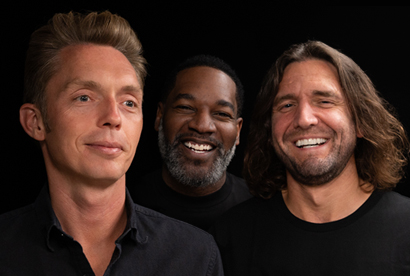
How to Start a Successful Blog in 2024
Learn how to start a blog in less than an hour. Become a blogger today by following the steps we used when starting our blog, which now has reached more than 20 million people and has been seen in the New York Times , TIME magazine, and on the TODAY show.

You can start a blog in just 5 simple steps.
- Choose your blog name and hosting.
- Build your blog with WordPress.
- Pick your design to make it your own.
- Add SEO and track stats.
- Write compelling content.
Do you want to start a blog fast?
This is a long essay and you may want to start your blog without all the detail.
This is the first how to quickly start a blog guidepost.
To start a blog fast simply:
- Look for these boxes.
- Follow the brief steps.
- Click the link to jump to the next box.
Click here to go to the first step.

How We Started This Blog
Want to create something meaningful? Why not start a blog? Why not become a blogger? Creating this blog is one of the best decisions Ryan and I ever made. After all, our blog is how we earn a living . We make money blogging, but more important it’s how we add value to other people’s lives.
So you’re thinking about starting a blog, but you don’t have any idea where to start, right? Guess what—neither did we! Before we became “The Minimalists,” we wanted to start a blog to communicate our thoughts and express our feelings, but we were overwhelmed with options.
Clueless, confused, and confounded with choices, we had no idea how to start a blog or how to be a blogger. When should we start? How do we register a domain name? What is hosting? Which blogging platform should we use? How do we choose a blog theme? What should we write about? Heck, we could hardly spell HTML, let alone build a blog!
But good news: it turns out that starting a blog is much easier than you think. We’ve learned a ton of lessons during our ascent to millions of readers, and now you can learn from our pain and suffering to avoid much of the tedium involved in setting up a blog.
How to Become a Blogger: Video Tutorial
If you prefer to watch our process for setting up a blog, we’ve created a step-by-step start a blog video, How to Become a Successful Blogger Today , which shows the entire starting-a-blog undertaking. Otherwise, read on.
How to Start a Successful Blog in 5 Steps
- Choose your blog name and get your blog hosting.
- Start your blog by adding WordPress.
- Pick a simple theme to make your blog your own.
- Add two key blogging plugins to find your readers and track stats.
- Write compelling content to create a blog that your readers love.
While there are other blogging platforms out there like Blogger, Squarespace, and Wix, nearly every serious blogger uses a self-hosted WordPress site because of its creative freedom and flexibility.
It’s not only because it’s the easiest blog to set up. The Minimalists uses WordPress because it gives us greater control over the look and feel of our blog—more creative control than any other platform. Oh, and WordPress itself is free !

These are the exact steps we took when we created this website. If you follow these five steps, you will learn how to set up a blog in less than one hour.
Step 1 Choose your blog name and get your blog hosting
The first thing we did when starting our blog was go to Bluehost and register our domain, which is free with hosting. We’ll explain hosting in a moment, but let’s talk about your domain name first.
Blogging Quick Start – Step 1
In this first step you will choose your blog name (domain name) and buy your blog hosting.
- Go to Bluehost and click the Get Started Now button.
- Select the Basic plan .
- Pick your domain name and enter it into the New Domain box.
- Create your Bluehost account.
Click here to jump to the next step.
Choose your domain name
Your domain name is an important part of your blog because it creates a first impression—it is the name of your blog. Also known as your URL, your domain is also your address on the web. For example, our domain name is www.theminimalists.com.
So, what do you want to call your blog? Maybe it’s YourName.com. Maybe it’s YourBusinessName.com. Or maybe it’s a creative brand name you thought up. If you’re having a hard time thinking of a good domain name, try Wordoid , a wonderful naming tool that will give you plenty of great options. Just make sure you don’t buy the domain from them since Bluehost will give you a free domain. (If you’ve already purchased a domain elsewhere, that’s okay, too, because Bluehost will make it easy to transfer your existing domain during the setup process.)
Set up blog hosting
Once you’ve decided on a domain name, you’ll need to set up hosting for your blog. While WordPress itself is free (see Step 2 below), you need a reliable place to host your WordPress blog (your blog needs to be on a server somewhere on the Internet).
For hosting, we recommend Bluehost for several reasons:
- We Use Bluehost. We personally use Bluehost to host The Minimalists . If you recommend a company, you better be willing to use their product yourself. We also use them to host several other websites of ours.
- Great Pricing. TheMinimalists.com is a Bluehost affiliate partner, which means that in addition to using their service, we also receive a commission for referring new customers. To be fair, though, we would still use Bluehost even if we weren’t an affiliate—we’ve used them for a long time. Ergo, we don’t recommend Bluehost just because we’re an affiliate (every hosting company offers a similar affiliate program); we recommend Bluehost because they are the best, most reliable option. Plus, because we’re a partner, Bluehost offers a more than 50% discount for The Minimalists readers: only $2.75 a month for the first year.
- Free Domain. When you sign up for hosting, Bluehost will give you a free domain name, which allows you to avoid the upfront and recurring fees associated with purchasing a domain on your own. If you’ve already purchased your own domain name, don’t worry; you can still use your domain with Bluehost (it’s just one extra step).
- Money-Back Guarantee. Bluehost offers a 30-day money-back guarantee, so there’s no risk if you change your mind.
- Reliability. Bluehost’s facilities are world class. They have their own custom-built 20,000-square-foot datacenter with enough backup generators to power a city.
- Friends & Family. Many of our friends and family also use Bluehost to host their blogs.
Now that you’re ready to get started, go to Bluehost and click the Get Started Now button.
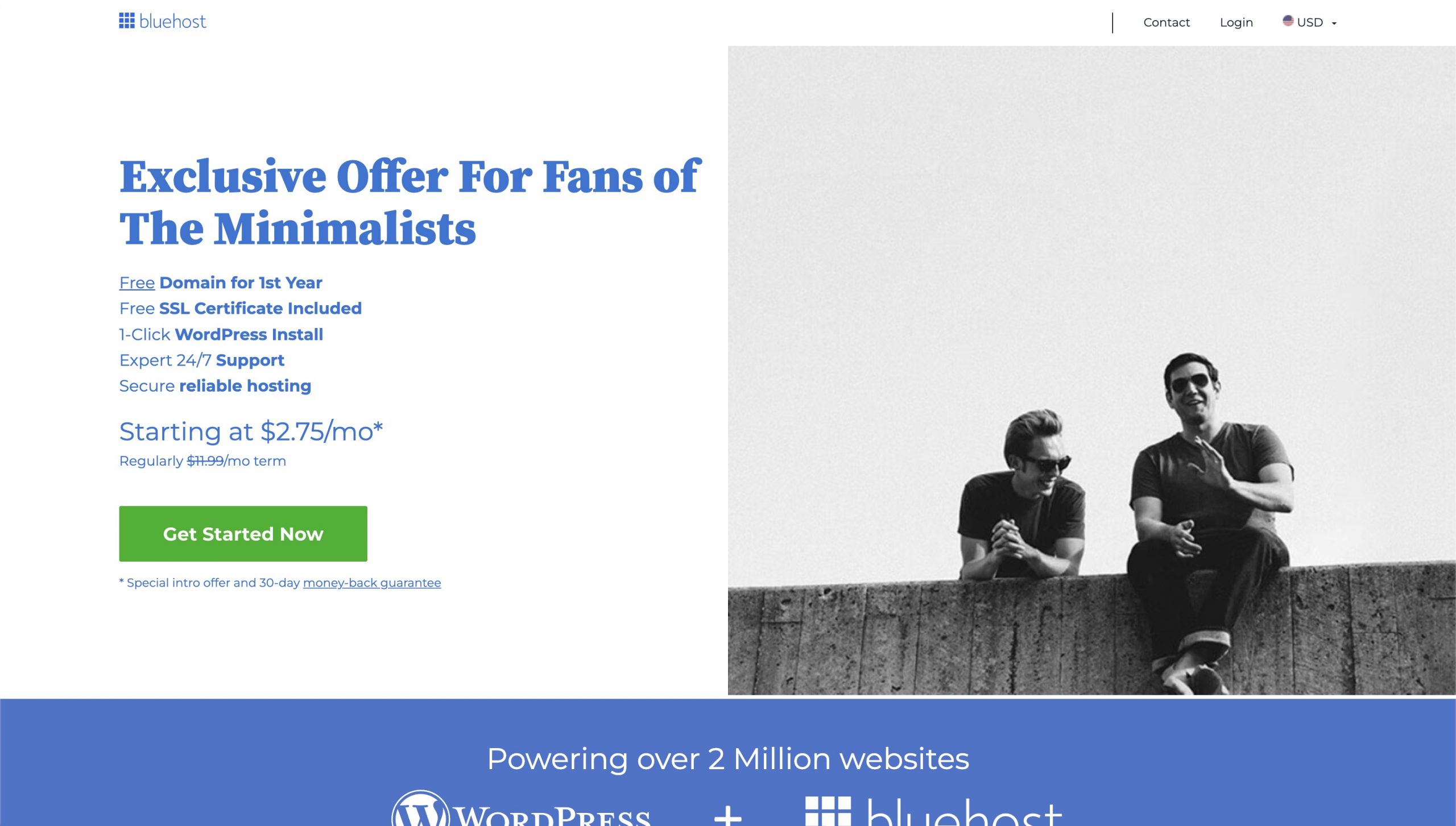
Next choose your hosting plan.
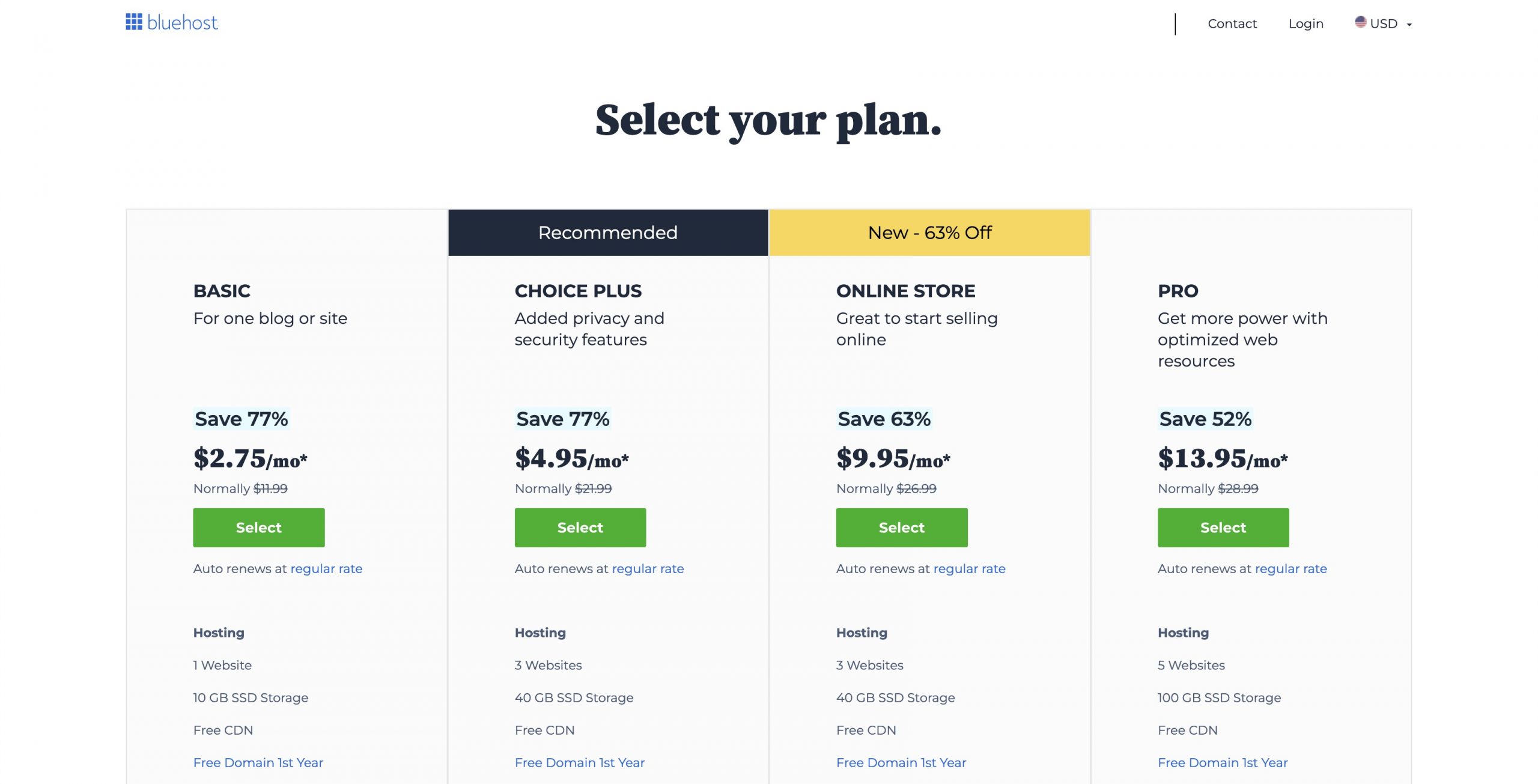
You’ll see that prices range from $3 to $6 per month, depending on whether you want a basic, single blog hosting plan or a more robust plan that allows you to create multiple blogs.
Once you select your plan you’ll choose or enter your domain name.
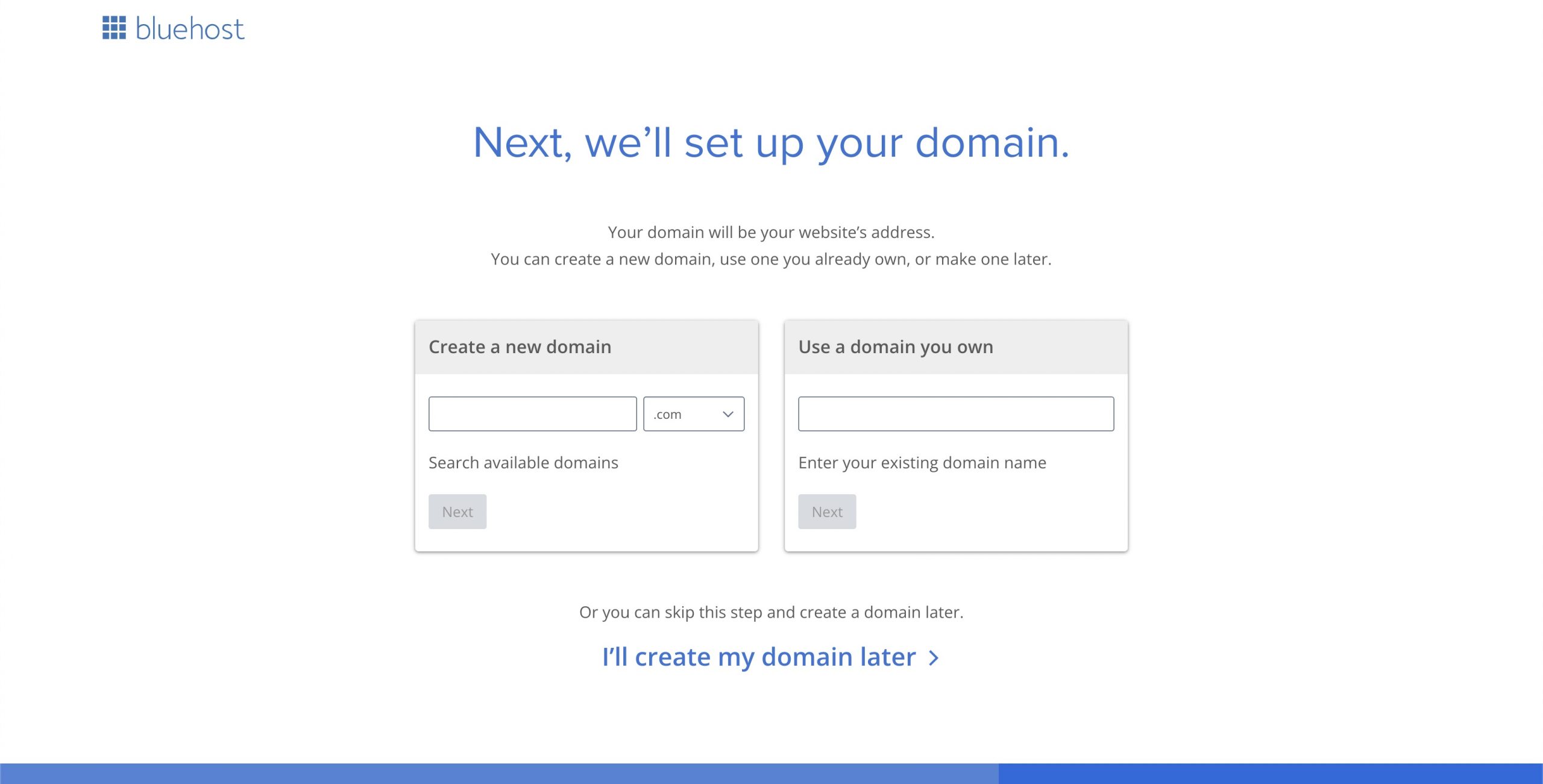
If you don’t own a domain name simply enter your desired blog name into the New Domain box.
If you’ve already own a domain name simply enter that into the I have a domain name box.
Click Next .
Finally create your blogging account.
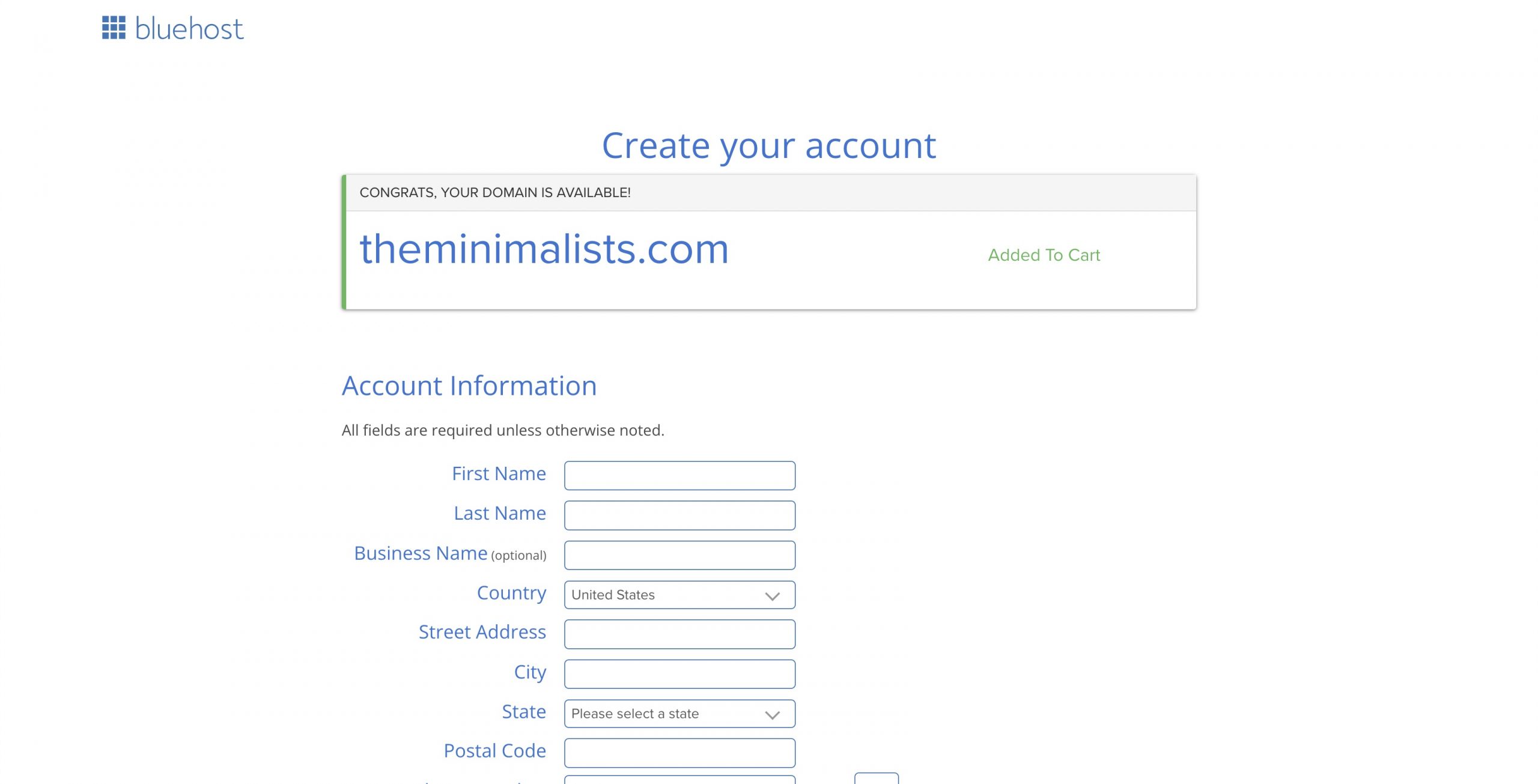
And click Create your password to complete your blog hosting setup.
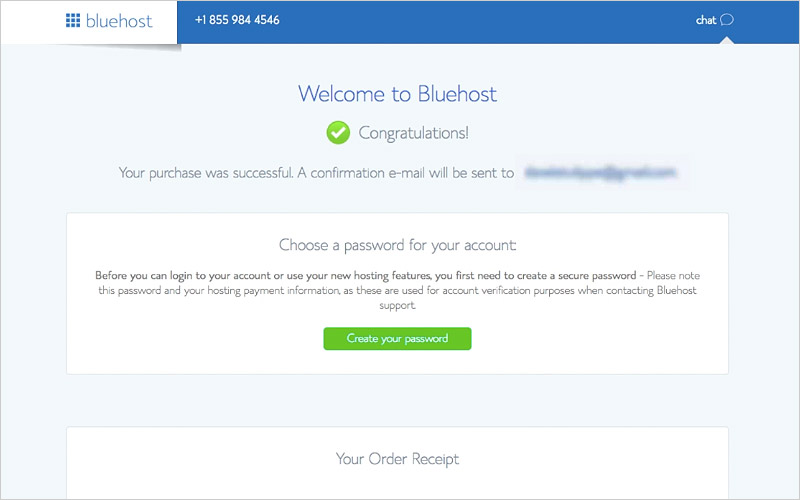
Just like that you’ve nearly become a blogger!
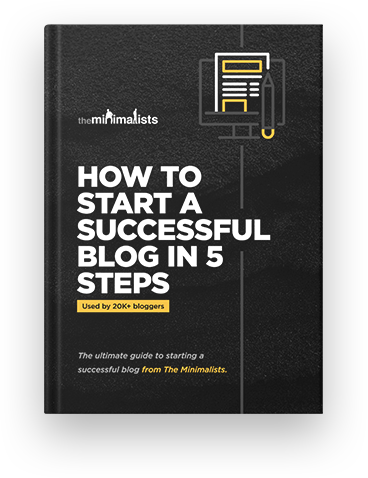
How to Start a Blog Ebook
Pressed for time? Learn how we started our successful blog using this free ebook.
Step 2 Start your blog by adding WordPress
Next you will install WordPress, which is free. Don’t let the word “install” intimidate you, though. It’s much easier than it sounds and Bluehost does all the work for you.
Blogging Quick Start – Step 2
Next you’ll install WordPress.
- Click the Log In button.
- Click Skip This Step on the Pick a theme screen.
- WordPress is now installed, click Start Building to go to your dashboard.
To begin simply click Log In .
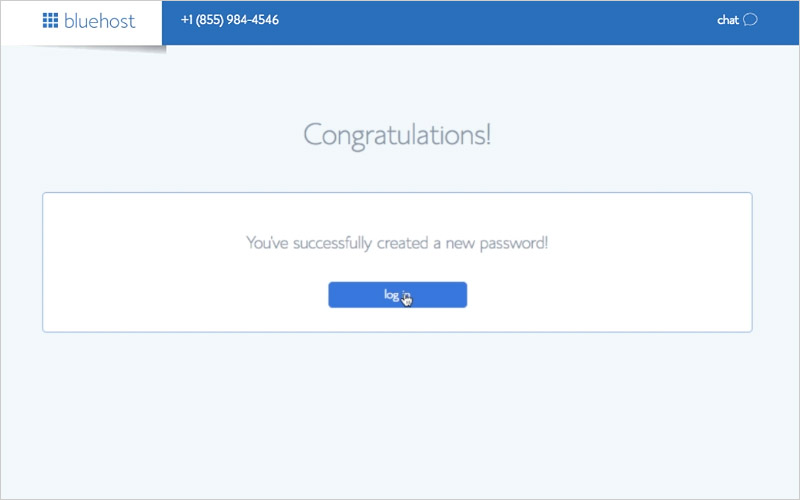
Bluehost provides several blog design options, but simply scroll to the bottom and click Skip This Step (you’ll see why in a moment).
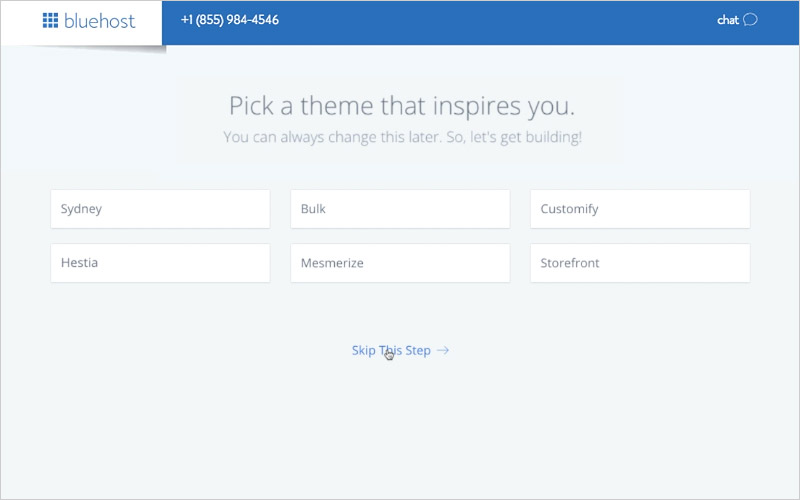
WordPress is now installed. Simply click Start Building to go to your new blogging dashboard and continue to Step 3.
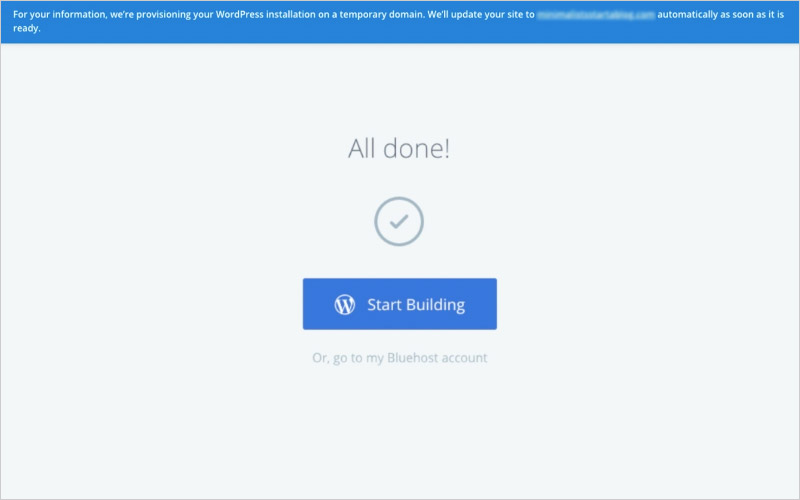
Step 3 Pick a simple theme to make your blog your own
A theme allows you to pick a design for your blog without the need for coding expertise or design knowledge. In other words, a good theme helps you to design your blog exactly how you want it to look. If you’re not a coder (I’m certainly not a coder), then a theme makes the design work a million times easier.
Blogging Quick Start – Step 3
Next you’ll choose and install your blog’s WordPress theme.
- Go to BYLT .
- Purchase the theme that fits your style (we use the tru Theme).
- Download and save your theme’s .zip file to your Desktop.
- Return to your WordPress dashboard and go to Appearance > Themes .
- Click Upload and then Upload Theme .
- Click Choose File , select your theme .zip file, and click Install Now .
- Click Activate .
Our blog design is from BYLT, a platform created by our good friends at SPYR. They have several beautiful, simple WordPress themes to choose from, and, in fact, you can purchase the same theme we use if you like.
Simply go to BYLT and find the minimalist WordPress theme that best fits your desired aesthetic. Their themes are feature-rich; plus, once you buy your theme, you will have the same team supporting your work that we trust to support ours.
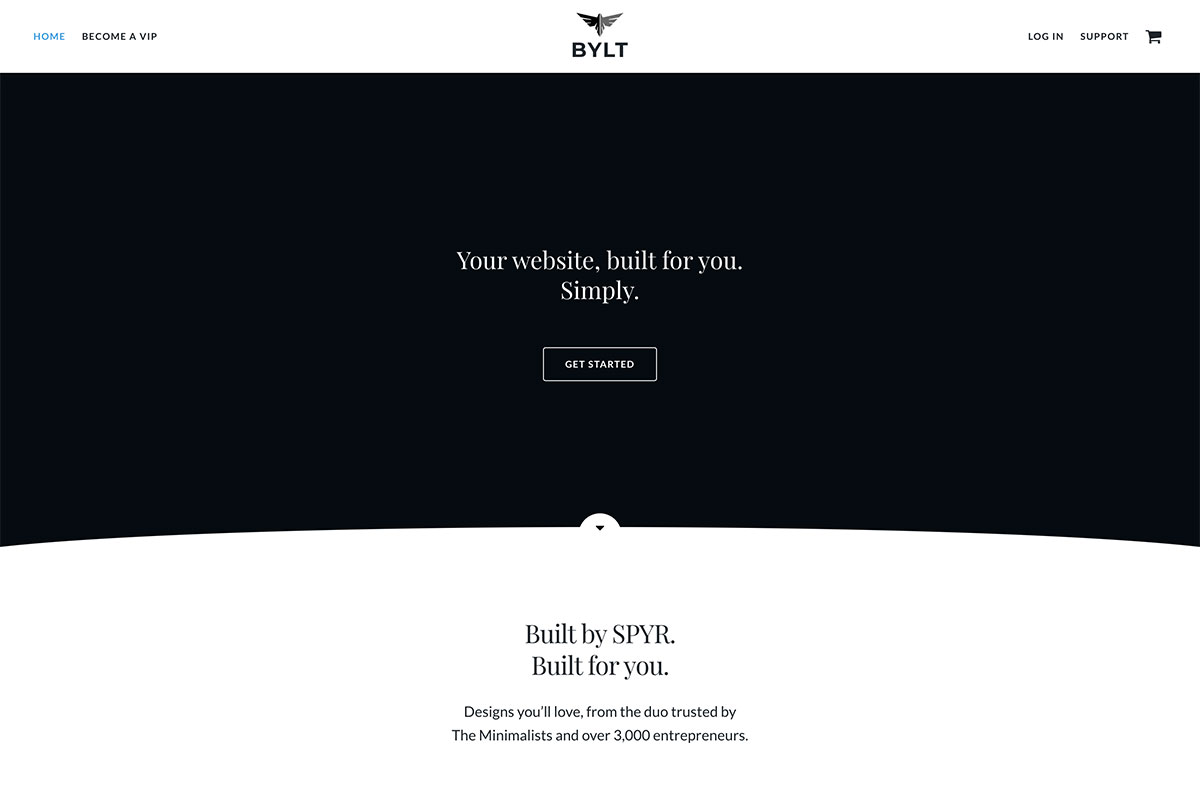
Once you purchase your theme you’ll be able to download your WordPress theme (a .zip file) from your BYLT Dashboard . Save this file to your Desktop because you’ll need to upload it to WordPress in just a moment.
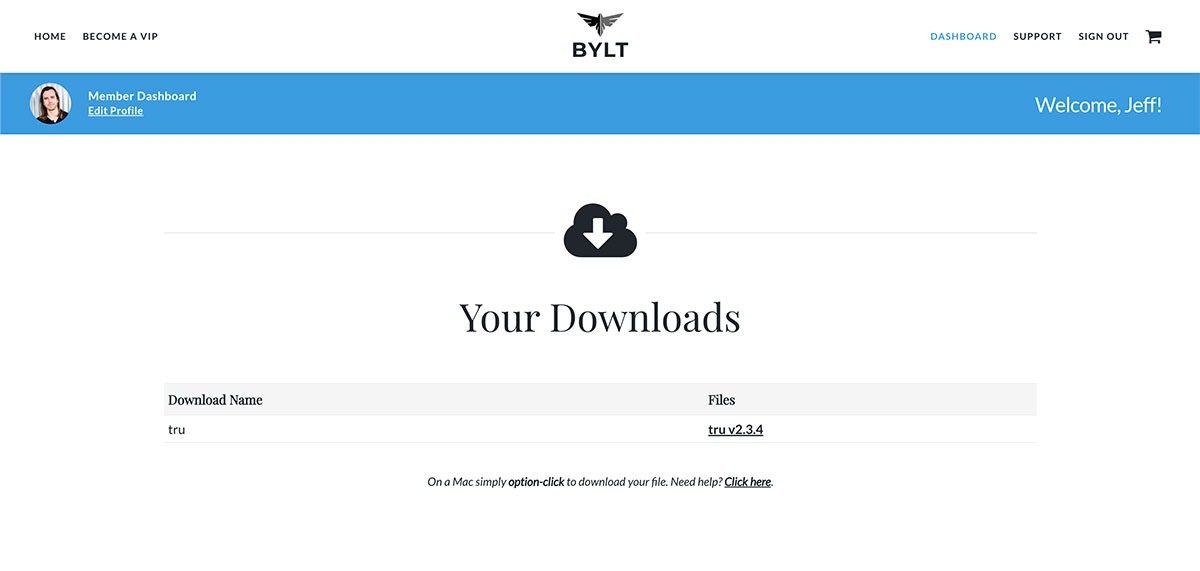
Remember how easy it was to install WordPress? Well installing your blog theme is just as simple.
First return to your WordPress Dashboard.
You should already be logged in, but whenever you are signed out go to my.bluehost.com , enter your new domain name (or username), your password, and click Submit .
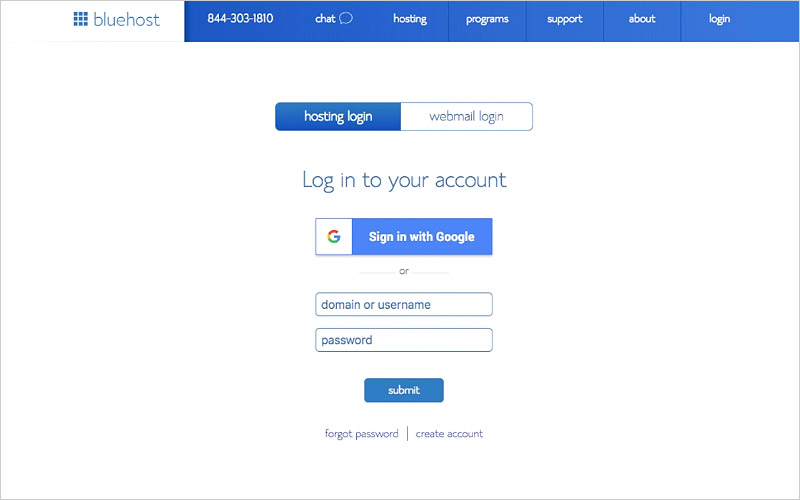
From here, go to My Sites and click on Log in to WordPress .
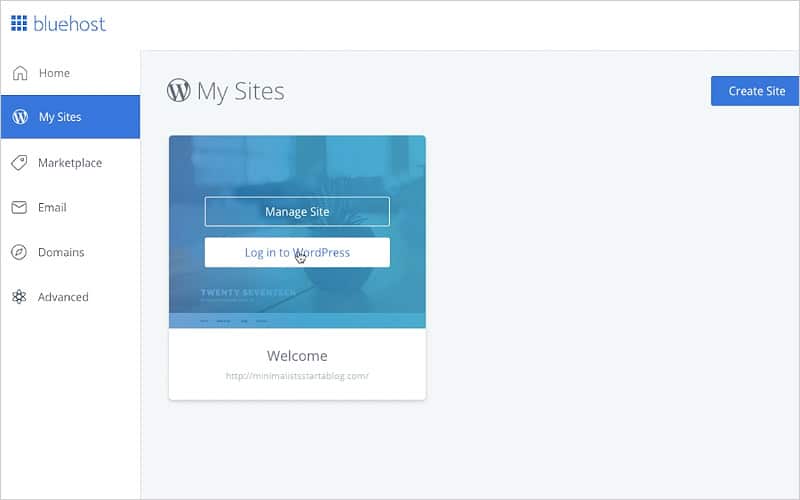
Next, in your WordPress dashboard, go to Appearance > Themes .
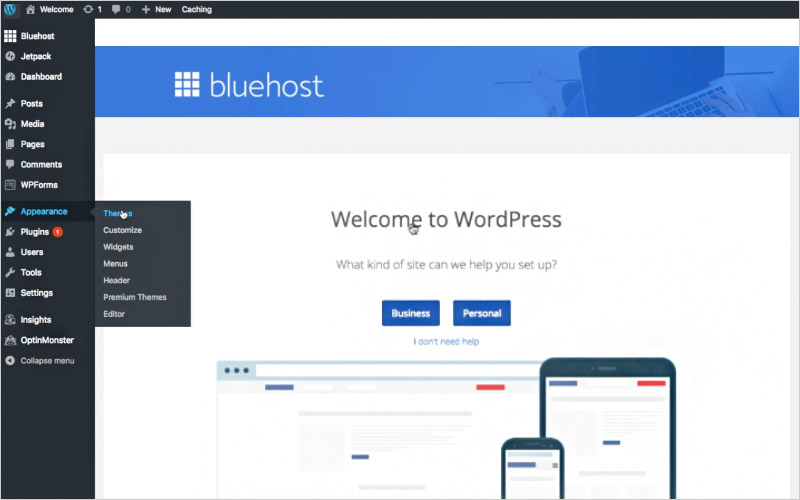
Next, click the Upload button.
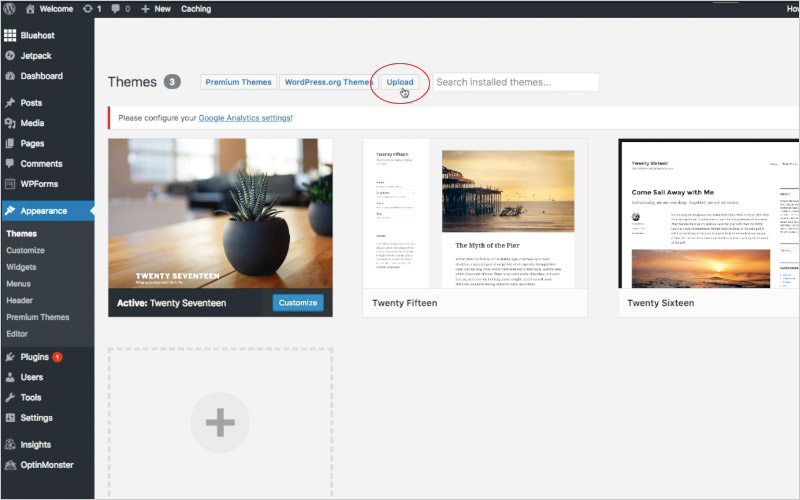
Then, click the Upload Theme button followed by the Choose File button.
Find the .zip file you downloaded from your BYLT Dashboard (this is your theme file) and click Install Now to install your new simple blog design.
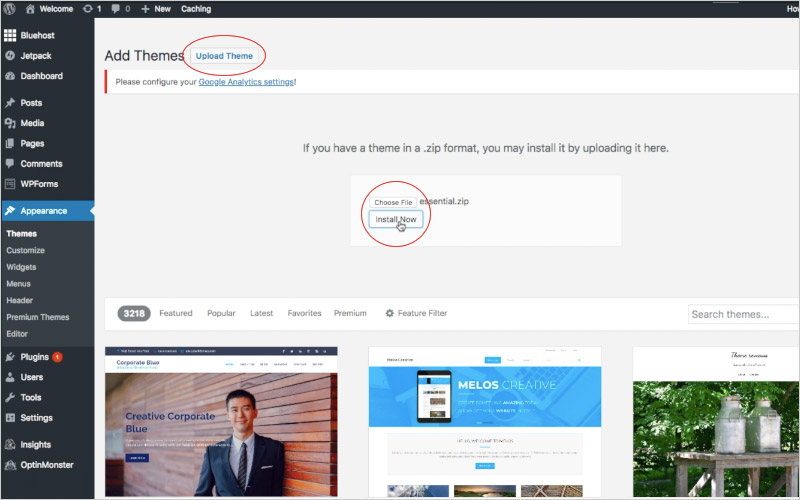
Finally, click Activate and your blog theme is installed.
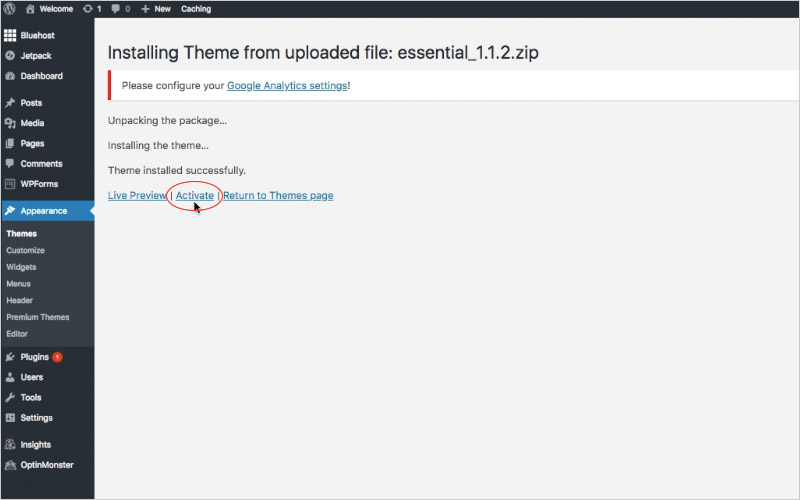
Step 4 Add two key blogging plugins to find your readers and track stats
Plugins are third-party appendages that add additional functionality to your blog.
Blogging Quick Start – Step 4
In the final setup step you’ll install two plugins that will improve your blog’s features.
- In your WordPress Dashboard go to Plugins > Add New .
- Search for Yoast SEO . Click Install Now followed by Activate .
- Click the Add New button to add one more plugin.
- Search for MonsterInsights and click Install Now followed by Activate .
- Click the Launch the Wizard! button to configure MonsterInsights.
It’s best to keep your number of blog plugins to a minimum and install only the best ones, because too many plugins—as well as unreliable plugins—can slow down your site. We use very few plugins at The Minimalists .
In this section you’ll install and activate the following free plugins:
- Yoast SEO is the defacto standard SEO plugin for WordPress. For details and everything you’d ever want to know about WordPress SEO read Yoast’s Definitive SEO Guide .
- Google Analytics for WordPress by MonsterInsights allows you to track your blog’s traffic easily and with lots of interesting data: overall traffic, traffic sources, views per author & category, automatic tracking of outbound clicks and pageviews.
In your WordPress dashboard go to Plugins > Add New .
Search for Yoast SEO .
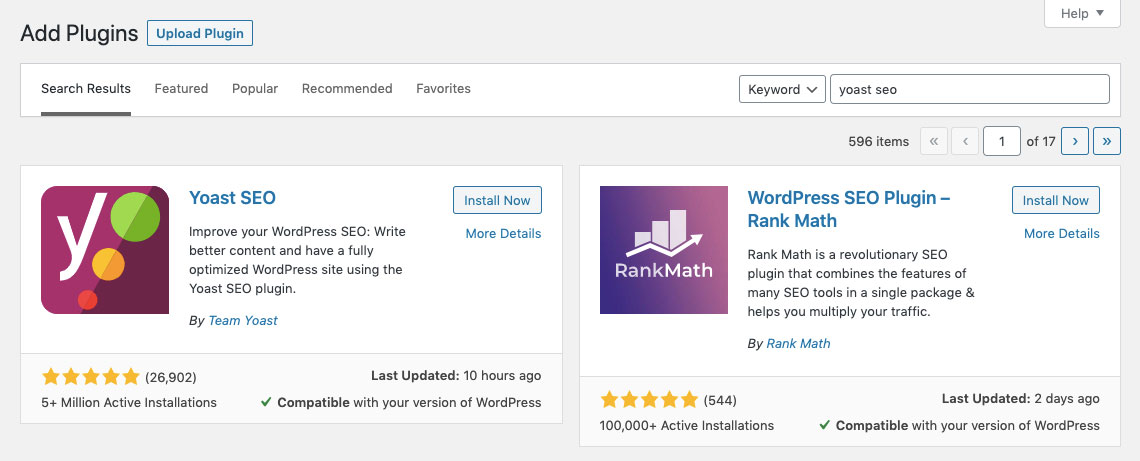
Then click Install Now followed by Activate and your blog will immediately have improved SEO.
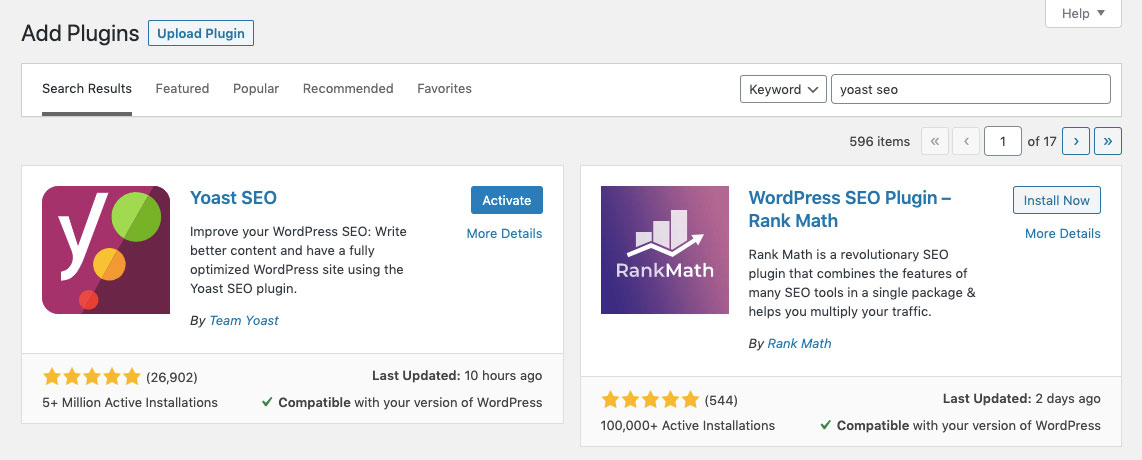
Next search for MonsterInsights .
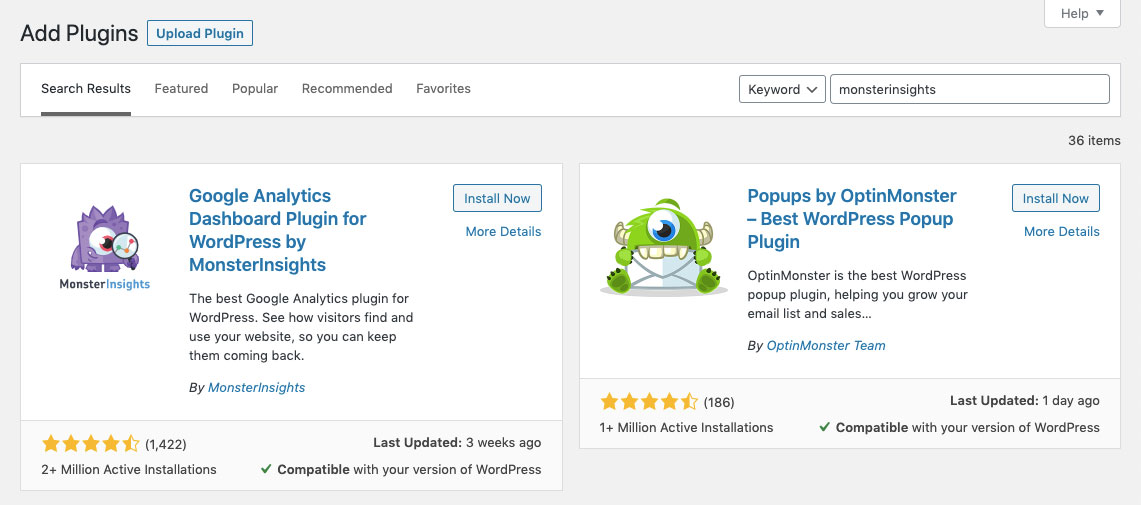
Then click Install Now followed by Activate .
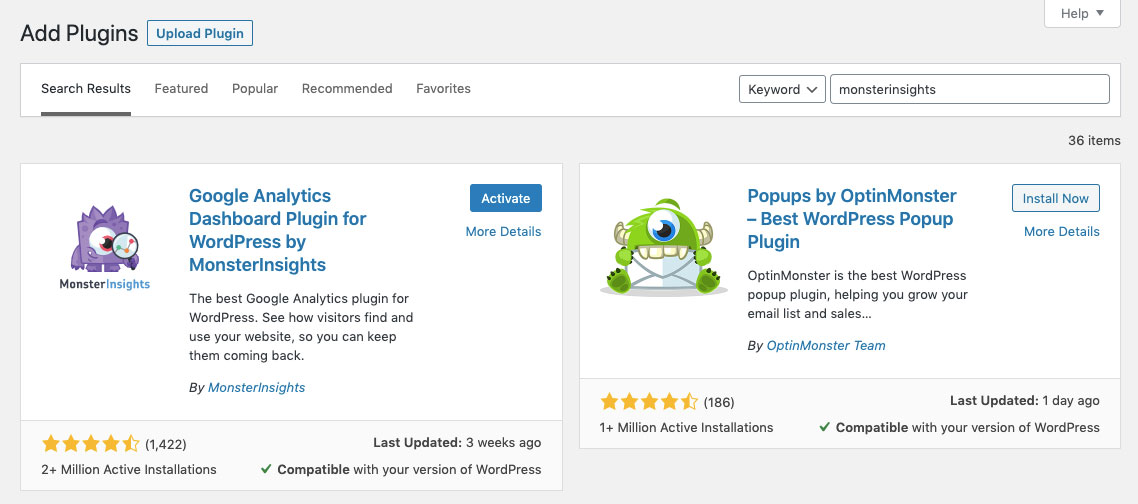
Next click Launch the Wizard! and follow the steps to complete the MonsterInsights setup.
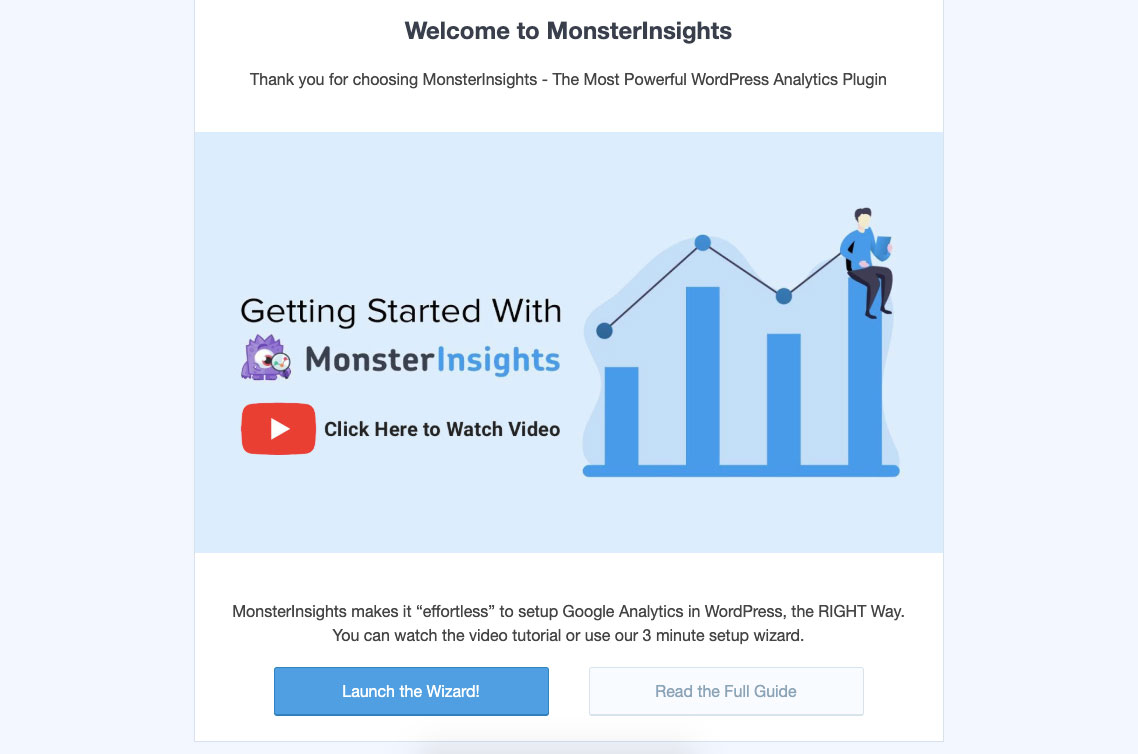
Finally, so people can receive our blog posts via email, we have an email newsletter. For a feature-rich email-subscription service we recommend ConvertKit (affiliate link). (By the way, if you don’t already, subscribe to The Minimalists’ blog via email .)
Step 5 Write compelling content to create a blog that your readers love
Congratulations! You started a blog, and now it’s time to start blogging. This is where the fun begins.
Now that you have your own blog, you get to make it yours ; you get to turn your vision into a reality.
- Content . Start writing and publishing the content for your basic pages: create an About Page, Contact Page, Start Here Page, and any other page you want in the header of your new blog.
- Photo . Add a photo of yourself (pro tip: you can start with a well-lit selfie, but when you get a chance, get some professional photos taken; they’re well worth the cost because people identify with other people more than they identify with logos).
- Logo . Create a basic logo using a program like InDesign, Photoshop, or a text editor (note: even though we have no design skills, we were able to use Apple’s Pages application to create our simple logo after downloading some free vector art and choosing the typeface that best suited our aesthetic). Or you can find someone on a site like Fiverr or hire a designer like SPYR to create a professional logo.
- Images . Spice up your blog posts with high-quality stock photos and images: Unsplash (free), Library of Congress (free), iStock (fee-based), Shutterstock (fee-based).
- Comments . Determine whether or not you want comments on your blog; they are often a useful way to receive feedback and directly engage with your readers.
- Social . Establish a social media presence on X (Twitter) , Facebook , or Instagram (or all three).
- Publish . Start writing new blog posts. Publish at least once a week, especially when first starting a blog, so you can build an audience. Below you’ll also find 20 blogging tips to improve your writing in the How to Blog section, as well as 15 reasons you should start a blog and 3 reasons not to start a blog.
We hope you have loads of fun expressing yourself on your new blog. We’re certain it will be a huge growth experience for you during the coming months. You have now officially become a blogger. Wherever you’re going, make sure you enjoy the journey ahead.
How to Blog: 20 Blogging Tips to Improve Your Writing
We receive many emails asking how to blog, about blog topics, and about creating meaningful content. The bulk of this essay explained how to start a blog, but that’s just the initial step. Now it’s time to start writing and publishing your content.
Here, to answer the frequently asked “How can a beginner start blogging?,” are 20 tips for beginners on how to blog .
- Find Your Niche . You needn’t have a niche, but it helps. When learning how to be a blogger, it’s important to ask yourself what you’re passionate about. Running? Cooking? Being a parent? Have you found your passion? If so, whatever it is, write about that. If not, then you must first find your passion . Note: We generally recommend that people don’t start a blog about minimalism or keto or any other heavily saturated topic. But what we really mean when we say this is: don’t create a blog about something unless you have a unique perspective. If you’ve embraced simple living and have a unique perspective, then by all means have at it.
- Define Your Ideal Readers . Once you’ve found your niche, you need to know who will be reading your blog. For example, we blog about living a meaningful life with less. Thus, our ideal readers are people who are interested in exploring minimalism so they can clear the path toward more meaningful lives. If you want to write about your newborn baby growing up, that’s wonderful: your ideal readers are probably your friends and family. If you want to write about restoring classic cars, that’s cool, too. Tailor your writing to your readers (whether it’s your family or local community or whoever else will read your blog).
- Add Value . Your blog must add value to its readers’ lives. You want to help people solve problems. This is the only way you will get great quality readers to your site (and keep them coming back). Adding value is the only way to get someone’s long-term buy-in. We both learned this after a decade of leading and managing people in the corporate world. With everything you write, it’s worth asking: Is this adding value?
- Be Original . Yes, there are other blogs out there about the same thing you want to write about. Question: So why is your blog different? Answer: Because of you . You are what makes your blog different. It’s about your perspective, your creativity, the value you add.
- Be Interesting . Write interesting blog posts. Especially if you want people to share it with others.
- Be Yourself . Part of being interesting is telling your story. Every person is unique, and your story is an important one. The important part of storytelling, however, is removing the superfluous details that make the story uninteresting. A great storyteller removes 99% of what really happens—the absorptive details—and leaves the interesting 1% for the reader.
- Be Honest . Your blog needs to be authentic—it needs to feel real—if you want people to read it. You can be your blog, or your blog can be you. That is, do you really embody the stuff you write about? If not, people will see through it.”Be the change you want to see in the world,” is the famous Gandhi quote. Perhaps bloggers should build the blog they want to write for the world.
- Transparency . Being transparent is different from being honest. You needn’t share every detail about your life just for the sake of being honest. Always be honest, and be transparent when it adds value to what you’re writing. (Because everything we write must serve the greater good, you won’t ever see pictures of us using the restroom—that’s simply not relevant.)
- Time . Once you’ve learned how to start a blog, you’ll learn that blogging takes a lot of time, especially if you’re as neurotic as we are. That said, once you have your design set up, don’t tweak it too much. Instead, spend the time on your writing.
- Vision . The reason our site design looks good is because we have a great host , we have a great theme , and, most important, we had a vision of how we wanted our blog to look. Once we had the vision, we worked hard to make that vision a reality. (Note: neither of us had any design experience before starting a blog.) It’s hard to create a beautiful blog if you don’t know what you want it to look like.
- Find Your Voice . Over time, good writers discover their voice and their writing tends to develop a certain flow, one that is appealing to their readers. Finding your voice makes your writing feel more alive, more real, more urgent. For additional reading, check out our blog post about Finding Your Voice .
- We Instead of You . Use the first-person plural when possible. Statements of we and our are more powerful than you and your , especially when talking about negative behaviors or tendencies. The first person comes off as far less accusatory. Think of it this way: we’re writing peer-to-peer—we are not gods.
- When to Post . Question: When is the best day and time to publish a blog post? Answer: It doesn’t really matter. We don’t adhere to a particular time-of-day schedule, but we do publish at least once a week because consistency is important. You needn’t get bogged down in the details, though.
- Social Media . Yes, we recommend using X (Twitter) , Facebook , and Instagram to help connect with your audience and other bloggers, but don’t get too caught up in it. Focus on the writing first, social media thereafter.
- Ignore Negative Criticism and Stupidity . Sure, we get a lot of negative comments and stupid questions from ignorant people who aren’t really our readers (“You’re not real minimalists!”). We call these people seagulls : They fly in, crap on your site, and fly away. But we pay them no mind, because we didn’t start our blog for them. Delete their comment and move on.
- Research . Spend time researching what you’re writing about. The reason we are able to use so many helpful, relevant links in our essays is because we put in the time to research our topics.
- Keep It Simple . This is where minimalism can be applied to starting any blog, irrespective of its genre. No need to place superfluous advertisements or widgets all over your site. Stick to the basics and remove anything you don’t need—remove anything that doesn’t add value.
- Picture . Put a picture of yourself on your blog. People like to see the face of the person who’s writing the blog. If two goofy guys from Dayton, Ohio aren’t too afraid to put their pictures on their site, then you have nothing to worry about.
- Comments . If you’re going to have comments on your site, then read The Five Words That Kill Your Blog by Scott Stratten.
- Live Your Life . You’re starting a blog about your life (or about certain aspects of your life, at least), so you still need to live your life. There are things that we always put before blogging: exercise, health, relationships, experiences, personal growth, contribution. Simply put, live a life worth writing about.
15 Reasons You Should Start a Blog
We were inspired to research and write this blog post after reading Joshua Becker’s 15 Reasons I Think You Should Blog , in which he discusses 15 great reasons why you should start a blog.
Why is the keyword here. Crucially, Becker writes about the purpose of blogging, not just how to start a blog. That’s what many of these other “blogs about blogging” seem to miss: they miss the purpose— the why behind starting a blog.
Here is a summary of our three favorite reasons from Becker’s list:
- You’ll become a better writer . “At its core, writing is communication. It is about recording thoughts on paper and compelling others to agree with them,” writes Becker. “To that end, writing (just like every other form of communication that has ever existed) improves with practice. Blogging will not force you to become a better writer, it’ll just happen as you do it. And becoming a better writer holds important benefits for the rest of your life—whether you are creating a book, a presentation, a resume, or an anniversary card for your spouse.” Spot on! Writing blog posts is not only a great way to improve your blog writing, it’s a wonderful chance to improve everything you write—from business emails and text messages to that novel you’ve been dreaming of penning.
- You’ll meet new people . “Whether it be through comments, emails, or social media, you may be surprised at how quickly you meet people online,” writes Becker. That’s true! The Minimalists’ blog is responsible for many of the most important relationships I’ve developed over the past decade—long-term business and personal relationships birthed from this very blog
- You’ll become more confident . “Blogging will help you discover more confidence in your life,” writes Becker. “You will quickly realize that you do live an important life with a unique view and have something to offer others.” So true! Writing helps us better understand the lives we live and the consequences of our actions.
3 Reasons You Should Not Start a Blog
So now you have 15 reasons why you should start a blog, and we’ve shown you how to start a blog, step-by-step, based on our personal experience.
But after giving you those detailed instructions, which could save you hundreds of hours of wasted time, we also want to give you some good reasons why you should not start a blog. (Keep in mind that these reasons are just our opinions, and we do not pretend to offer them up as a collection of empirical blogging maxims.)
- Money . You should not start a blog to make money. We need to get that out of the way first. If your primary objective is to replace your full-time income from blogging, forget about it. It doesn’t work that way. Do you think that Jimi Hendrix picked up his first guitar so he could “supplement his income”? No, he didn’t. Rather, he did it for the love of it, for the joy and fulfillment he received, and the income came thereafter—much later actually.
- Notoriety . Don’t plan on getting “Internet famous” right away. Not every site grows as fast as ours did, but that’s okay. The truth is that we kind of got lucky. We found a great domain name, we cobbled together a logo and site design that people liked, we write fairly well, and our content connected with people in a unique way. We didn’t start this site to become “famous,” though. That’d be ridiculous. We started this site to become bloggers and share a message. Our popularity came as a surprise to us, and it was a result of a little luck and a lot of hard, passionate work.
- Traffic . Not all traffic is good traffic , so don’t worry about getting thousands of readers right away. Spend your time producing meaningful creations and eventually the audience will show up if you are helping people solve problems. In other words, focus on adding value, not increasing traffic.
The funny thing is that all these things can happen. You could make a full-time income from building a blog. We do it and so do many others. And you could become an Internet famous blogger like Leo Babauta .
But if these are the sole reasons you start blogging, you’ll be miserable because it will seem like a job. And if it feels like a job, you won’t be passionate about it, so you’ll either hate it or fall flat on your face (or both).
Instead, become a blogger and write because you’re passionate about it…
4 Blogging Resources
If you want to learn more about blogging, publishing, writing, and SEO, then check out these additional resources:
- What Kind of Media Counts? (Seth Godin)
- How to Publish an Indie Book (Asymmetrical Press)
- How to Write Better: Online Class (Joshua Fields Millburn)
- Some Funny Thoughts on SEO (Exile Lifestyle)
How to Start a Blog Infographic

FAQs When Starting a Blog
How do bloggers get paid do bloggers make a lot of money are blogs still profitable in 2024, how many hours do bloggers work, is blogging hard to do what do bloggers actually do, what does blog stand for what does blog mean, which blogging platform should i use squarespace vs wordpress: what is the best site to write a blog, how do i become a blogger, what’s the difference between a blog and a website, are blogs dead, does anyone read blogs anymore is blogging a waste of time, are blogs still relevant in 2024 is it worth starting a blog in 2024 is it too late to start blogging, should i start a blog or should i start a podcast, do i need a business to start a blog, is blogging a realistic career do careers in blogging have a future is blogging a good career, what has replaced blogging, which blog content is best what should i blog about, what does a good blog look like what is a blog used for what makes a good blog, what makes a blog successful, what kind of blog is most popular which type of blogs are most searched what are popular topics to blog about, how do you start a blog with no money how do you start a blog for free, how often should i blog, what should my first blog post be about, how do you introduce yourself in a blog, why do blogs fail, does bluehost charge monthly or all at once, what is the difference between a blog and a vlog, what does the b in blog mean, do blogs or vlogs make more money, can you make money from a blog alone, what does a blog look like, do you need a license to run a blog do i need an llc to make a blog, do i need to copyright my blog, how do i protect my photos on my blog, how do i register my blog name, do i need to trademark my blog name, is it ok to use stock photos on my blog, can i use google images on my blog, should i use my full name on my blog, should a blog have a home page should my blog be on my homepage what should i put on the front page of my blog, can everyone see my blog, what is an attention grabbing sentence what is a hook sentence for a blog what is a good hook example.
- Do you have a question that we didn’t answer?
- Creations . By building an audience who finds value in our message, we’ve been able to offer our three books and our documentary, Minimalism , to an audience who is willing to support our creative work. Consequently, all three books have been bestsellers and are now translated into more than a dozen languages; and thanks to Netflix, our documentary is available in 190 countries. (For more information about our book-publishing process, read this blog post series: How to Publish an Indie Book .)
- Audience Contributions . Since we refuse to clutter our blog or popular podcast with ads, we depend on audience support to fund production of our podcast. With more than 5,000 supporters on Patreon and many others via PayPal, The Minimalists Podcast is fully funded with audience support, which means we’re able to pay for our podcast producer, filmmaker, and studio space without advertisements on our platforms.
- Speaking . As we built our audience, many organizations, universities, and conferences began contacting us about speaking at their events. At first, we starting speaking for free just to build a name for ourselves. Then, we started charging a few hundred dollars per event. Now, we’re able to charge significantly more money because the demand for our talks is high. So far, The Minimalists have spoken at Harvard, Apple, Google, Allstate, SAP, SXSW, TEDx, and many other organizations. We speak about a wide array of topics, from simple living and “simple work,” to health, relationships, writing, publishing, social media, personal growth, and contribution—and it all started because we started this blog. (Anyone who is interested in hiring us to speak can visit our speaking page for details.)
- Tours . Over the past eight years, The Minimalists, have embarked on eight speaking tours , including 2017’s 50-city “Less Is Now” theater tour, which attracted an average of more than 1,000 people a night, with considerably larger audiences in bigger cities. Our 2014 “Everything That Remains” bookstore tour spanned 119 cities in eight countries and attracted 75,000 attendees.
- Writing Classes . I get countless questions about writing, so I’ve been able to transfer that skillset to help hundreds of students improve their writing over the years. I teach a four-week online writing class designed to improve the writing of people at any skill level—beginner, intermediate, or professional.
- Amazon Links . If The Minimalists recommend a product like this photo scanner , and then a reader purchases that product, we receive a small commission for that sale at no additional cost to our audience. We’re careful about what we recommend, however, because, as minimalists, we want you to consume less and to consume intentionally.
- Affiliate Sales . When we recommend services such as Bluehost and ConvertKit , we receive a referral fee. Once again, though, that’s obviously not why we recommend these services. Virtually every hosting company has an affiliate program, so we think it’s best to recommend the companies we trust.
Through these various means, Ryan and I are able to earn a full-time income through blogging. But it’s worth noting that making money from your blog is not the best place to start.
While there’s nothing wrong with making money—which you can do through affiliate links , advertisements , and your own products and services—the best reason to start blogging is because you have something to express.
If you make money along the way, that’s great. In fact, if you help people solve their problems, you’re all but guaranteed to make money from your blog—eventually. Let’s just remember there are at least four resources that are more important than money: skills, time, energy, and attention.
That said, let’s not kid ourselves by acting as if making money is irrelevant—it’s not. Making money from our blog is simply not the primary driver for our creativity or why we became bloggers. Although people often think of money as the ultimate resource, it is the least important of the five mentioned above.
Money won’t necessarily improve your life, but it will amplify your existing behaviors. If you have bad habits, then more money will make your life considerably worse. And if you’re already a generous person, then more money can help you be more loving, caring, and considerate.
Personally, I write one or two blog posts per week, usually in the evenings, or on weekends, so it doesn’t get in the way of my other activities. That’s the nice thing about blogging: you get to write whenever you want-no one tells you what to do, when to do it, or how much must be done. Within five months of learning how to blog, you’ll find your own rhythm that works for you.
Writing a blog does not require a degree or special training. In fact, all you need is a desire to communicate with an audience. If you have that, then starting a blog is ideal for you.
According to Wikipedia , a blog is a discussion or informational website published on the World Wide Web consisting of “discrete, often informal diary-style text entries (posts).” The term “weblog” was coined by Jorn Barger on December 17, 1997. The short form, “blog,” was coined by Peter Merholz, who jokingly broke the word weblog into the phrase we blog in the sidebar of his blog in 1999.
Today, blogs have many shapes and sizes. Many are public journals people use to express their feelings. Others, like this blog, exist to help people think critically and solve problems.
There are blogs that cover nearly every topic, ideology, and interest—from sports and politics to religion and travel and everything in between. Even the world’s largest news organizations—ABC, CBS, NBC, FOX, CNN, and MSNBC—all have their own blogs.
Here are five reasons WordPress is better than Squarespace:
- Design (Themes) . Squarespace provides some beautiful templates, but they’re limited by the number of designs that are available. Since WordPress is a free, open-source blogging platform, there’s an ecosystem of tens of thousands of themes ready to satisfy every want and need. While this variety is a benefit, we know full well that too many options can lead to a paradox of choice. This is why we recommend starting with the premium themes designed and supported by our friends at SPYR. We’ve worked with SPYR since the early days of The Minimalists and continue to recommend their products and services. (This is not an affiliate link—SPYR just does great work.)
- Features (Plugins) . While Squarespace has a rich feature set, no blogging platform can compare with the immense scale of features that WordPress offers. WordPress has a library of over 54,000 free plugins that can handle any task. While we suggest that you keep the number of plugins on your blog to a minimum, the level of customization provided by WordPress is unmatched. Plugins aside, one key feature that’s built in to WordPress, but not Squarespace, is version control. Version control tracks your changes and allows you to compare revisions and revert back to a version of your Page or Post from any point in time. I use this feature all the time because I know that if I’m unhappy with anything I’ve changed, I can quickly revert back to the previous version. This feature provides a failsafe that allows bloggers to compose, draft, edit, and publish their posts within WordPress itself, making it a complete blogging solution.
- You Own Your Content . Owning your content means that you have full control over what you express on your blog—and complete access to take that content and use it anywhere that you wish. To enable the latter, WordPress provides tools to export your data for use on any hosting provider that you choose to use. With Squarespace you can never truly download a complete copy of your server files or database, but with WordPress you can create an exact replica of your blog, at any point in time. This is most valuable for maintaining backups or in case you choose to restart a blog with a new hosting company . With WordPress you have 100% ownership of your content, files, data, and design—and everything can be backed up.
- SEO . Out of the box, both WordPress and Squarespace are search engine friendly. But with a single plugin WordPress elevates your SEO (Search Engine Optimization). A plugin we recommend for every blogger is Yoast SEO . This free WordPress plugin allows deep customization of your on-page SEO, but, more impressive, it provides automated content analysis. This helps guide you to improve and optimize your content for better readability and improved reach in search engines. While SEO isn’t everything, we all start our blogs in hopes that people will read what we’ve written. Following proper SEO practices can be a differentiating factor in reaching new people.
- Growth . WordPress is extremely robust and customizable. It allows you to build a blog exactly as you’d like. But what happens as your new blog grows? If you outgrow the off-the-shelf option, maybe it’s time to work with a design partner to create a fully custom website that’s tailored to match your brand and image. Since WordPress provides you with complete ownership of the platform, it also provides a designer with the freedom to build and create your blog design without restriction. Nothing is off limits.
The answer is in the question: the only way to become a blogger is to start a blog. This might sound overly simplistic, but that’s because it’s not that complicated. If you follow these steps you’ll become a blogger and start blogging today.
There’s an old truism, “Writers don’t like writing; they like having written.” I think the opposite is true for bloggers: because of the instant gratification of the WordPress “Publish” button, I find that bloggers enjoy writing because they’re constantly sharing that writing with the world.
The barrier to entry is gone, so start blogging if you want to become a blogger. It really is that simple.
While the lines have blurred over the years, the simplest way to put it is that a blog is a type of website, one that catalogues, over time, the personal or professional thoughts and beliefs of a person or organization.
As your thoughts, beliefs, and ideas change, so will your blog. It’s nice to have a time capsule of our thoughts, as they’ve evolved over the past decade.
No, blogs are not “dead.” In fact, blogs are more alive than ever!
As a matter of fact, our blog has grown every year since 2010 and now boasts more than 3.78 million readers and an email list that continues to grow every month.
Millions of people read our blog every year-and our audience continues to grow because, thanks to our blog, new people find our work every day. But it’s not just The Minimalists who are successful. Blogs are popular all over the world, and they are the simplest way to publish content without middlemen or gatekeepers.
Blogging is the opposite of a waste of time. If you have a genuine desire to share your creativity with the world, then it’s one of the best “time investments” you can make. Our blog is simultaneously our practice space-where we share new ideas and writings with the world-as well as an announcement board that keeps our audience abreast of any new developments in the world of minimalism.
Starting a blog is arguably more important than ever. Whether you want to publish your writing, build an audience, open a business, or start a podcast , your blog is the home for your creative projects.
Once you’ve started a blog, you are no longer reliant on other people’s platforms. There’s nothing “wrong” with having an Instagram or TikTok account, but those platforms are ephemeral. If they fall out of relevance, then so do you (remember MySpace). That’s not the case with a blog, though. Because you own your blog, it stays with you no matter where the culture sways.
The best time to start a blog was a decade ago. The second best time is now . If you have an idea you want to share, get started!
You don’t have to pick one over the other. You can start a blog and start a podcast. That’s what we did. After starting our popular blog, which is now read by millions of people, we started a similar podcast, which, at the time of this writing, has more than 100 million downloads. Frankly, our podcast would not have witnessed the same success if we didn’t also have a blog. So if we had to pick one, we’d start a blog. But thankfully, you can choose both if you’re compelled by both creative outlets.
No, you don’t need a business license to start a blog. Even if you start earning money from your blog, you can claim that income on your personal taxes under your name and social security number. It was several years before Ryan and I turned The Minimalists into a limited liability company (LLC).
Blogging is still a career for many people, a great way to make supplemental income for even more people. But Ryan and I don’t look at blogging as a career. Rather, for us, it’s an opportunity to add value to people’s lives. Of course, if you add enough value, income tends to follow. Blogging has also enabled us to showcase our books, podcasts, films, social media, and other projects that add value to our audience.
While new forms of media continue to enter the picture-podcasts, newsletters, social media-nothing replaces having a home for your creative work. The Minimalists have a podcast, an email newsletter, and several social media accounts, but none of them could ever supplant our blog. Instead, we use our blog to point to these additional resources.
We often hear people say that you should blog about what you’re passionate about. That’s great advice if you know what that passion is. Maybe it’s technology, finance, baking, music, or rock climbing. If so, write about that!
If, however, you don’t know what you’re passionate about, don’t worry. Passion isn’t simply stumbled upon; it is cultivated.
Here are six questions to ask yourself to help you determine what you should blog about:
- What are your values? Whatever you write about, you want it to align with your values.
- What excites you? There will always be drudgery, but if you find something that excites you, you will be able to drudge through the drudgery.
- What makes you angry? If you aren’t excited by something, then anger is often a great motivator. If there’s something in the world you want to change, write about that. It will help inform and strengthen your values.
- How can you solve problems? You will feel fulfilled if you can provide solutions to people’s problems. Coincidently, if you write about solving your own problems, that will help other people solve those same problems, too.
- What if money wasn’t important? If money wasn’t a factor, what would you do with your life? Yes, you need to make money, but, just as important, you want to do something meaningful. Write about that.
- Who is the person you want to become? Your writing should help you become the person you aspire to be. Write as if you’re writing to make your future self proud.
A blog is used for two things: to express and to communicate . A good blog is able to marry communicative writing and expressive writing to create blog posts that are informative and entertaining.
When considering how you want to use your blog to communicate and express yourself, ask these questions:
- What message am I attempting to communicate?
- Does the writing express the emotions I want to the reader to feel? What are those emotions?
- Does this sentence serve a purpose?
- Can I cut this line and still preserve my message?
- How can I make this more concise?
- Do I need all these modifiers and qualifiers? (Hint: no!)
- If I killed the first two paragraphs, would this piece be better?
- How could I restructure this sentence/paragraph to make it more climactic?
You get to define what success looks like for your blog. Maybe your goal is to reach a thousand true fans, publish a blog post every day, or build a large audience so that you can sign a book-publishing contract with a major publisher. It is possible to accomplish any of these feats with your blog (I’ve done all three). Blogging has brought me more success than I ever expected: New York Times -bestselling books, millions of readers, international book tours, an Emmy-nominated Netflix film, speaking at Harvard, and much more. None of these achievements fit my original idea of success, but as I added value to an audience, I discovered what was possible.
While it is best to blog about subjects that interest you, these are some of the most searched blog topics:
- Relationships
- Career advice
- Local interests
- Food and beverage
In short, what do you find compelling? Blog about that! Your blog is more likely to become popular if you’re passionate about the topic.
The good news is that starting a blog is free with WordPress. All you need to pay for is hosting, as outlined in the step-by-step instructions above .
There are also other “free” amateur services like Tumblr or Blogger that allow you to start a blog on those company’s platforms. Just be careful, because you may not own your content if you’re posting it on someone else’s website. That’s one of the many reasons why we use WordPress.
When talking to my writing students, I recommend writing every day and publishing a blog post at least once a week. We usually publish two blog posts per week on this blog. Seth Godin blogs every single day.
Whatever you decide, we recommend you stay consistent. Setting a weekly schedule helps you create accountability partners (your readership) so you feel compelled to write even when you don’t want to write.
Avoid grandiosity. Avoid throat clearing. Your first blog post needn’t be a grandiose mission statement. And your first blog post doesn’t have to be a vapid, self-involved introduction to your blog.
Instead, find one thing that interests you today and write about that. Use the prompts in the “What should I blog about” section above.
For reference, you can read the first blog post on this blog, circa 2010: Be on the Mountain .
Don’t worry about introducing yourself in every blog post. Instead, create an “about” page that new readers can reference if they want to learn more about you, your life, and the projects you’re working on. See The Minimalists’ About page as an example. Our friend Derek Sivers also has a wonderful Now page that could work for you.
There are at least three reasons blogs fail:
- Some bloggers have poor expectations. If you start a blog today and expect a million readers overnight, you’re setting yourself up for failure. But if your motivation is sincere-if you want to add value to the world-then you’ll find your expectations shift.
- Some bloggers don’t add value. Instead of metrics like subscribers or follower counts, The Minimalists focus on adding value to our audience. If you help people solve problems, the success will spring from that-not the other way around.
- Some bloggers put money first. There’s nothing wrong with earning a living from your blog (we do), but it needn’t be the main objective. Good blogs make money; great blogs make a difference. Said another way: we allow money to have a seat in the car, but it’s never the driver.
Bluehost bills annually, so when you use our link to receive the discounted rate of $2.75 per month you will be billed for the entire first year.
That said, if for any reason you decide that it’s not right for you, Bluehost offers a 30-day money back guarantee.
A blog (short for “weblog”) is a written communication by an author or creator that is meant to communicate with an audience; a vlog (short for “video log”) is a video version of a blog.
Blogs and vlogs are both excellent ways to reach an audience. However, a blog has a lower barrier of entry (no cameras, lighting, or microphones required), which makes it easier to start blogging today.
The word “blog” is an abbreviation of the term “weblog.” So the B in blog doesn’t stand for anything specific; it is merely a shortened form of the original term.
I’ve made significantly more money from blogging. Yes, The Minimalists create both blog posts and vlogs, but the dynamic nature of our blog has allowed us to reach more people and retain an audience, which is significantly more difficult with vlogging alone because with vlogs you don’t have direct access to your audience like you do with your blog.
It’s worth noting that we also use this blog to share many of our YouTube, Instagram, and TikTok vlogs with our dedicated blog audience, which amplifies our creations much better than social media alone.
Yes, you can make money solely from your blog. There are at least seven ways The Minimalists make money with this blog .
A blog can be as simple or as complex as you’d like. Successful blogs mirror the personality of their authors. For example, this blog is aggressively simple because, well, we are “The Minimalists.” Other blogs deploy bright colors and elaborate designs that mimic the quirky character, style, and disposition of its author. Either way, a WordPress blog grants you and your blog the flexibility to be as ornate or austere as you desire.
You do not need a license to run a blog. However, when you begin earning money from your blog, it can make sense to set up a separate LLC (limited liability company) for your blog. Alternatively, if you don’t want to establish an LLC, you can also claim any earned revenue from your blog under your personal social security number (I did this for the first few years of this blog, before finally registering The Minimalists, LLC).
You do not need to copyright your blog because you already own the intellectual property of everything you create. Your blog and all of its contents, blog posts, photos, images, and written words are already considered “copyrighted” the moment they are published. As long as you can prove that you are the author of a piece of content, a copyright is granted by public law without the need to file additional paperwork.
Unlike other blog and social-media platforms, your WordPress blog allows you to download and save all of your blog contents so that you can protect your photos and written words. Personally, I keep a backup of all my photos and written content on a separate hard drive, as well as a cloud storage account (e.g., Google Photos or Dropbox) for double redundancy. This isn’t required, but it gives me a piece of mind that I can’t get from social media.
Registering your blog name is free and easy. In fact, registration is a built-in part of the simple setup process outlined in the instructions within this blog post.
When you use Bluehost to host your blog, you’ll receive a free domain registration, which allows you to choose any blog name you want. If you can’t think of a good blog name, Wordoid is a free tool that can help you pick an effective name for your blog.
According to the United States Patent and Trademark Office , you are not required to register your trademark, but where or whether you decide to register your trademark can determine the scope of your rights. Specifically, you can rely on common law rights or file for state, federal, or international trademark registration.
Because of the monetary and time costs associated with filing a trademark, The Minimalists did not trademark our blog name for the first several years. Once we began selling products using our blog name (“The Minimalists”), it made sense to trademark that name because, according to the USPTO, there are several benefits of trademark registration, including:
- Trademark is listed in USPTO’s database of registered and pending trademarks. This provides public notice to anyone searching for similar trademarks. They will see your trademark, the goods and services on your registration, the date you applied for trademark registration, and the date your trademark registered.
- Legal presumption that you own the trademark and have the right to use it. So, in federal court, your registration certificate proves ownership, eliminating the need for copious amounts of evidence.
- Can use your registration as a basis for filing for trademark protection in foreign countries.
- Right to bring a lawsuit concerning the trademark in federal court.
- May use the federal trademark registration symbol, ®, with your trademark to show that you are registered with us. This may help deter others from using your trademark or one too similar to yours
- Record your registration with U.S. Customs and Border Protection (CBP). They can stop the importation of goods with an infringing trademark.
Yes, it is perfectly reasonable to use stock photos on your blog, as long as they are obtained lawfully from a creative commons website such as Unsplash or Pond5 . Just make sure you credit the photographer.
It is not acceptable to simply use Google Images on your blog; those photos are copyrighted. If you’re not careful, reusing photos from Google Images can lead to a costly lawsuit.
It is a good idea to use your full name and photo on your blog. Why? Because people connect with human beings, not faceless avatars. That’s why I use my full name—Joshua Fields Millburn—on this blog.
Alternatively, if you’re worried about maintaining anonymity because of your job, family, or the divisive nature of your blog’s content, then a pseudonym can be an adequate substitute for your real name. Just understand that blogging pseudonymously can make it more difficult to build trust with an audience. It’s not impossible to connect with others using a fake name, but it is an uphill battle.
While WordPress allows you to establish a home page for your blog, most blogs don’t need a home page because a home page creates one extra step for new readers to read your newest blog content. That’s why we removed our home page on this blog—we want readers to get right to the good stuff without any friction. Then, if a reader wants to learn more about our blog, they can always visit our about page.
Once your blog is public, anyone can see it. This is a good thing. As a writer, you want the opportunity to connect with new readers, even when you’re sleeping. A public blog is the best way to connect with a fervent readership.
However, readers can’t see your unpublished content (drafts, deleted posts, etc.); only your published blog posts are available for everyone to see.
Any sentence that makes the reader want to read the next sentence is a great sentence. The best opening lines force readers to ask questions. For example, how does the following sentence make you feel?
The average American household contains more than 300,000 items.
That sentence might lead to several questions and doubts in the reader’s mind:
Wait, what?
No way, that can’t be true!
Tell me more!
As soon as a reader is hooked, the sentence has done its job. I call this writing technique Narrative Urgency .
More Blogging Questions
Do you have a question about becoming a blogger that isn’t answered above? Post (Tweet) to @theminimalists with your question and a link to this essay.
Ask Your Question
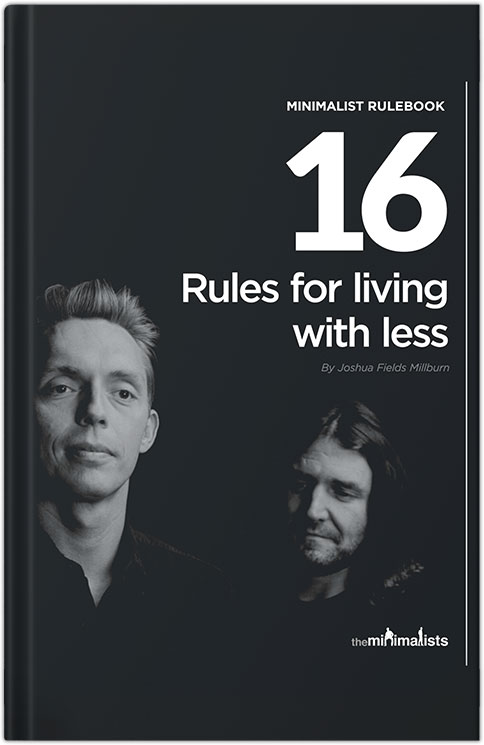
Minimalist Rulebook
Download our 16 rules for living with less in this beautifully designed ebook.
- How to Start a Blog and Make Money [Guide for Beginners]
Do you want to learn how to start a blog ?
Hi there, my name is Anya. I’ve been blogging for more than nine years and I’ve loved every moment of it. Blogging helped me land my first job and continues to be my lucrative side-gig. I often get asked, “How to start blogging?” or “How to become a blogger?” and I’m always excited to share my journey and tips.
In 2010 when I was learning how to create a blog, I spent a lot of time searching for helpful information online. I was only able to find it piece by piece on a variety of websites. To save you time, I’ve created this free step-by-step blog tutorial to teach beginners how to make a blog quickly and easily. It’s not as complicated as many people think!
FirstSiteGuide is a free resource that is 100% supported by readers.
Disclosure: If you purchase products through links on our site (i.e. Bluehost services), we may earn a commission. It comes at no extra cost to you, but it supports us in creating more useful content.
More than eight thousand people have started their blogs using this free guide.
This in-depth guide is 8400 words. I share everything new bloggers should know for starting a blog in 2024. You can take your time and read at your own pace!
⏳ Short on Time? → Click Here for a Quick Start with Bluehost
If you want to skip the intro and just learn how to build a WordPress blog with one-click install, use the link below:
Jump to Step #4: Start a blog by setting up WordPress software
P.S. If you have any questions about this guide or get stuck with the steps, I am more than happy to assist you. You can get in touch with me and ask for free advice.
Kind words from top bloggers and influencers:
“If you’re just starting a blog or want to level up your skills, make sure to check out @firstsiteguide.”

“Blogging guide for beginners via @firstsiteguide. Super helpful!”
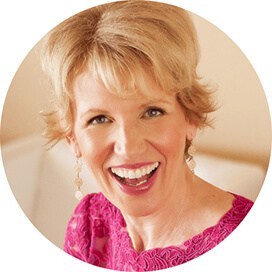
“New to #blogging or looking for additional blogging resources? Check out @FirstSiteGuide.”

How to Start a Blog in 9 Exact Steps
Here is the table of contents. This guide covers a lot of useful information, but don’t get overwhelmed, go through each step and you will succeed in blogging.
- Step #1: Pick a niche (topic) for your blog
Step #2: Choose a blogging platform
Step #3: choose a domain name and get blog hosting, step #4: start a blog by setting up wordpress, step #5: select a theme and design your blog, step #6: write and publish blog content, step #7: optimize your blog for search engines, step #8: promote, market, and grow your blog, step #9: make money blogging (optional).
Before you move into action, here are some valuable facts about why you should start a blog.
Think about why you are starting a blog
Do you want to communicate something, like a message or an idea? Do you want to build a community around a topic you enjoy?
A blog can help you to accomplish many things, such as: inform, educate, promote and even sell.
Here are some reasons why many people create a blog and enjoy blogging:
- To use it as an outlet for creative expression.
- To establish expertise and build an audience.
- To network with others and grow a business.
- To enhance writing and thinking skills.
- To become self-employed or make more money.
Blogging has a lot of benefits, and for some people, it can be a great way to earn extra income online.
A quick primer – Blogging for beginners
All in all, there are four important steps to understanding “how to make a blog” quickly. If you are familiar with these things, you can set up a blog in 15-20 minutes or even less:
- Pick a blogging niche (topic)
- Select the best blog platform
- Get a domain and web hosting
- Install WordPress software
Creating a blog is your first step in entering the blogging world. However, to be successful online you have to learn more . There are more than 100 free guides and resources on FirstSiteGuide to help you to succeed on the web!
Step #1: Pick a niche for your blog
Before you build a blog and make it as a blogger, you must select a blogging niche.
In simple terms, a blog niche is a specific topic you will write about most often, or even exclusively.
To pick the right niche for your new blog, begin by listing all the topics that excite you and make you want to talk about them. There are no restrictions – you can include any personal or professional interests in this list.
- Think of things that you enjoy doing in your spare time . For example, are you an amateur photographer or an avid programmer?
- Consider all of the things that you would like to learn . For example, do you aspire to take cooking classes and become a better cook?
- Lastly, contemplate all of your plans and projects . For example, do you plan to return to college to complete your education?
There are no restrictions – you can include any personal or professional interests on the list.
This simple exercise will help you select a niche you are the most interested in. That way you will follow your passion and enjoy your blogging journey.
At this stage, you’ll need to look at the currently available blogging platforms and determine the type of blog management software you will use.
When it comes to blogging sites, you have a few options. Below are usage statistics showing the distribution of blog technologies in the United States.
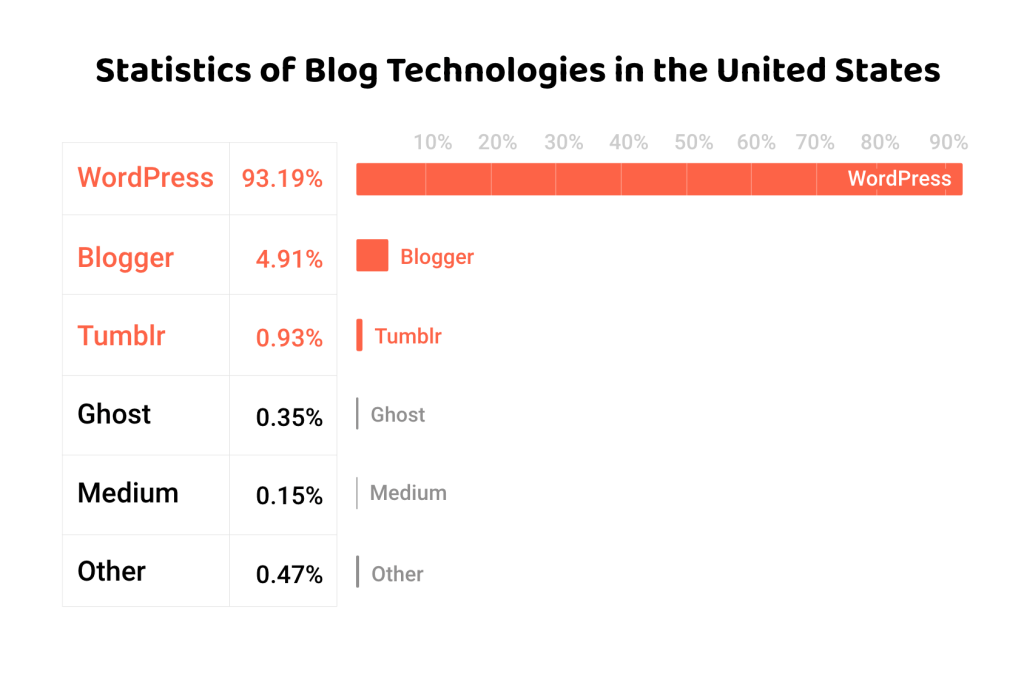
As you can see from the graph, WordPress software is by far the most popular technology for blogging, with over 90% market share in the U.S.
I recommend building your blog using the self-hosted WordPress blog setup that I share in this guide.
You will set up your blog using a custom domain name and web hosting (I’ll show you how in the next step).
That way, you will completely control your blog and its contents. It will cost just a few dollars per month for the webspace (hosting account) and around ten dollars per year for a domain. The actual blogging software is free and open source.
What about free blogging sites?
For many new bloggers, it’s tempting to start a blog using free-hosted platforms such as Blogger or Tumblr .
However, it’s important to understand that “free” always comes with limitations :
- First , your blog name will be set as a subdomain (examples: “ yourblog.blogspot.com ” or “ yourblog.tumblr.com “).
- Second , you’ll be subject to their rules and restrictions.
Free options come in handy for testing a blogging platform. But if you’re serious about starting a blog, you’ll have to start paying for full services and a custom domain name sooner or later.
To make your blog using WordPress.org, you need two important things: a domain name and a web hosting company.
Domain name
Your domain name will be the name by which you will be known online, no matter what niche you choose. It’s your blog’s unique address on the Internet.
Here’s what you should consider when choosing a blog name:
- It should be short and catchy, easy to pronounce and type.
- You can also use combinations of your first and last names (e.g. johnsmith.com or tim.blog).
The general rule is to get a “.com” domain, but some other extensions can also be used. For example, “.net” or “.blog.” Ultimately, it’s about being memorable, so if a different extension helps you stand out, then break the rules!
Have a name idea for your blog? Use this quick domain search tool powered by Bluehost – our recommended web hosting provider (I’ll explain why in a moment).
If you can’t find a domain name you like, don’t worry. Bluehost lets you choose a Free custom domain later before your blog goes live. That will give you time to do some thinking and research.
Web hosting
After choosing a domain name, selecting a reliable hosting service will be one of your most important decisions.
To a great extent, the functionality and performance of your blog will depend on your hosting provider. The host makes sure that your blog is available 24/7 to potential readers and it’s where your content is stored online.
If you are a new blogger, I suggest using Bluehost hosting.
Here is why you should be confident going with this company:
- Ease-of-use : With Bluehost, you will be able to set up your blog with a few clicks of a button.
- Good value : You get reliable service with excellent customer support at an affordable price.
- Room to grow : They offer a great set of features that you need to start, run, and grow your blog.
- Security : Free SSL certificate included and pre-installed to keep your blog visitors data safe.
- Verified provider : Bluehost is a recommended hosting provider on the official WordPress.org website.
- Used by many : I use their services, as do many blogger friends and family members.
- Survey winner : Based on our research, Bluehost is a top choice in the opinion of many blogging experts.

- Free domain name
- 63% off regular price
- 30-day money-back guarantee
- Set up a blog with a one-click
How much does it cost to start a blog?
Below are the costs of a 1-year Bluehost basic hosting plan and what extras you get with it. I was able to negotiate a special deal only for our visitors. Use this link to get an exclusive 67% discount .
Get a blog hosting account (+ free domain name)
This section provides detailed information to help you sign up for your web hosting account. I have included screenshots of the pages to take you through the process.
Step 1. Visit the Bluehost homepage
Go to the Bluehost.com website. Then, click the green “Get Started Now” button.
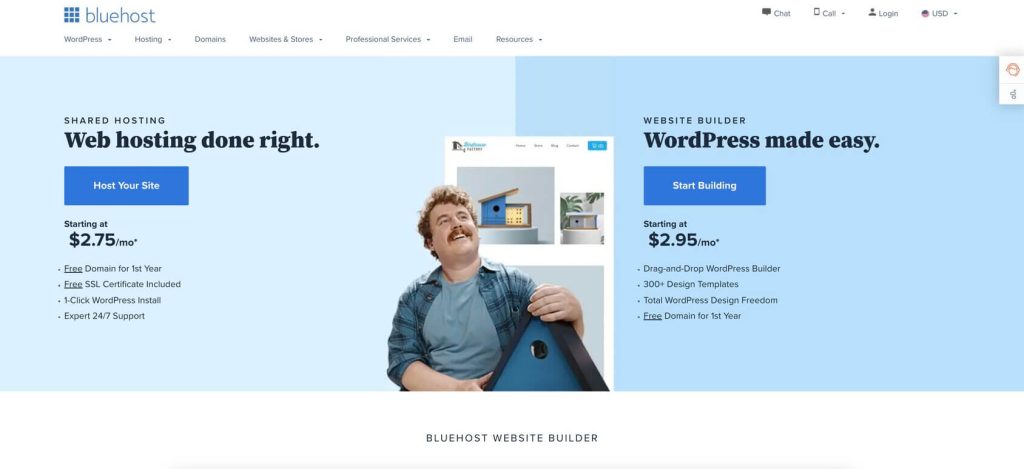
Step 2. Select your hosting plan
You will start by picking a hosting plan. If this is your very first blog, you can go with the Basic plan. Later, you can easily upgrade to a Plus or Choice Plus plan once your blog starts growing. Explore what each plan offers, e.g. Choice Plus plan comes with Domain Privacy and some extras.
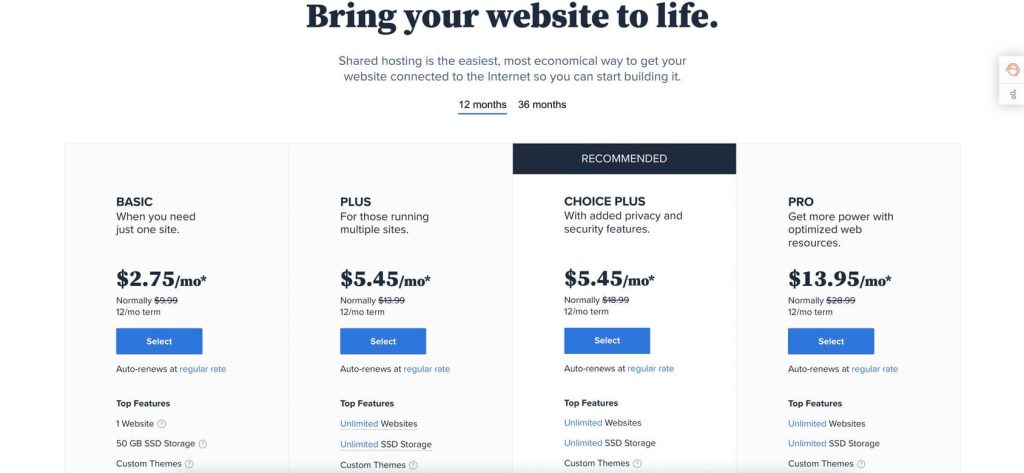
Step 3. Set up your domain name
Your domain will be your blog’s address, so you should take your time to come up with something unique and memorable. Just type your desired name into the “new domain” box and Bluehost will show you whether it’s available or not. If not, it will provide you with a list of similar names to choose from.
Don’t worry if you can’t find a good name right away. You can skip this step and pick a name once you start a blog.

If you have already purchased a domain name somewhere else, you can use that name. Just type it into the “Use a domain you own” box.
Step 4. Register with Bluehost
After you choose your domain, Bluehost will take you to the registration page where you can manually fill in your personal info, or you can Sign in with your Google account to make the process even easier!
Add your account information
Start by filling out your personal information.
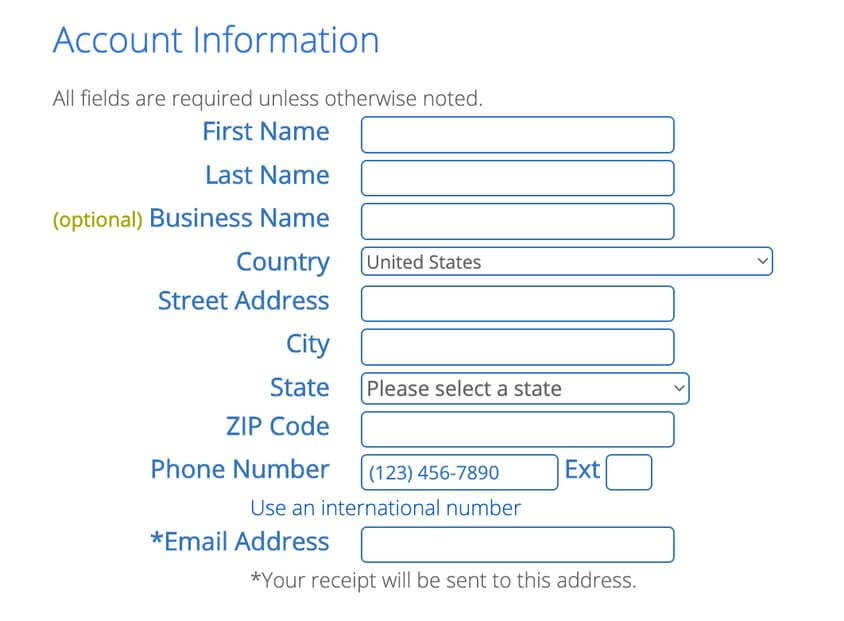
Select your hosting package
At this point, it’s time to select an account plan from the available options. Bluehost offers 12, 24, and 36-month packages.
With a 12-month package, you will pay a lower amount upfront, but with the other two packages, you will get a better deal if you are ready for a longer-term commitment.
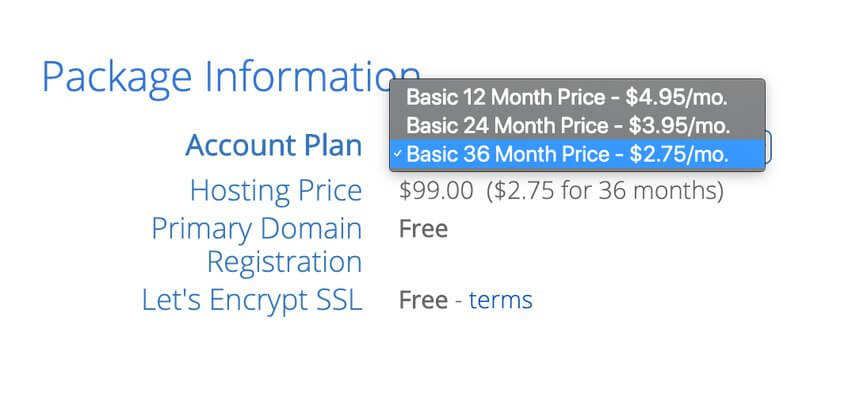
Package extras
Review your package extras carefully. Not every extra is essential, and by unchecking the boxes of extras that you don’t need, your total amount owing will decrease.
You can always add extras later if you find that you need them. I do suggest that you keep the Domain Privacy Protection box checked. This service will hide your personal contact information from the global database, which is publicly visible to anyone on the internet.
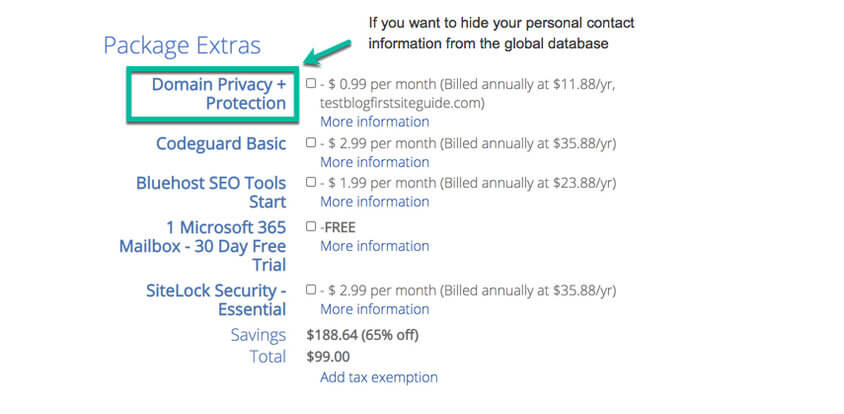
Payment information
Now, enter your payment information. Check the box that you have read and agree to the TOS (Terms of Service), and click on the green “Submit” button.
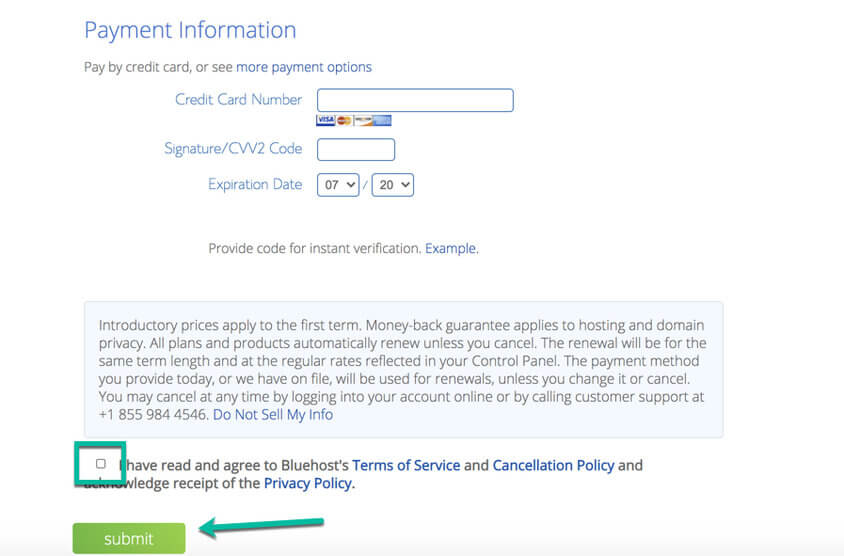
Bluehost will send you a confirmation email when your payment goes through. You will also receive an email to verify your email address to activate your domain.
Next, you will set up your Bluehost account. You are one step closer to starting a blog!
Step 5. Create your account
Let’s create your account with Bluehost.
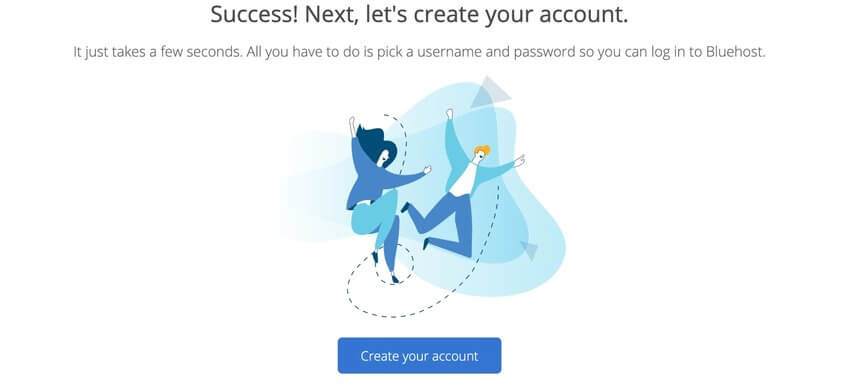
- Step 1. Click the “Create your account” button.
- Step 2. Enter your password and complete the account set up.
- Step 3. Your account is ready to go. Click the “Go to login” button.
- Step 4. Fill in the fields “Email or Domain Name” and “Password”.
You are all set. Next, you will start working on creating your blog.
Once you log in to your web hosting account, Bluehost will offer a 4-step process to help you create a blog. I suggest that you go with this procedure if this is your first time starting a blog.
You can also click the “Skip this step” button and work on blog construction on your own inside your Bluehost hosting account.
Four steps blog set up assistance process:
- Step 1 . You will start this process by answering 3 questions: What kind of site? What type is it? And who is it for? In my example, I selected: Blog, Personal, Myself. You can select the same choices or pick what fits your individual case.
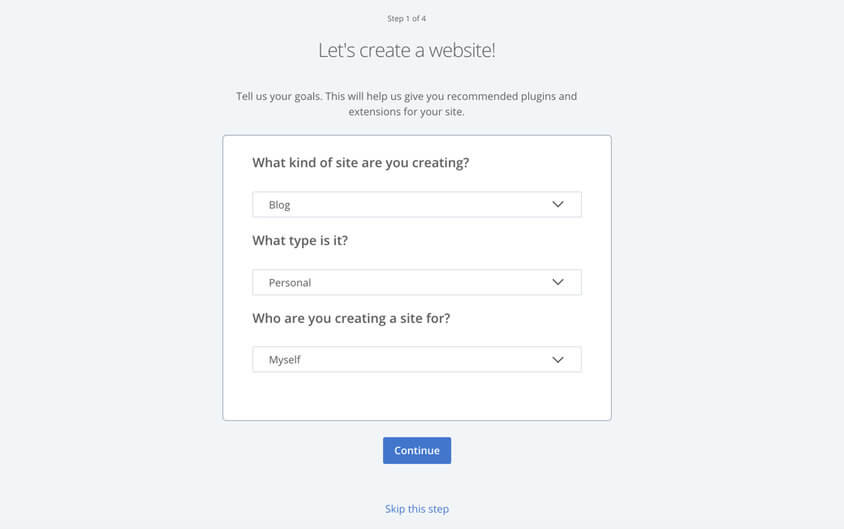
- Step 2 . With this step, you can choose what else to add to your site. Bluehost gives you a few options to choose from.
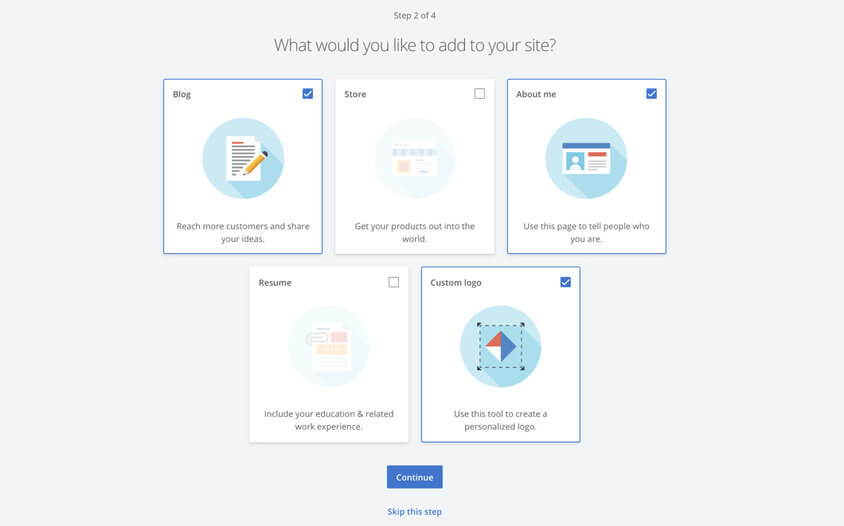
- Step 3 . In this step, you need to answer a few questions such as the name of your blog, tagline, and how comfortable you are with creating websites. Note: you can always change this later.
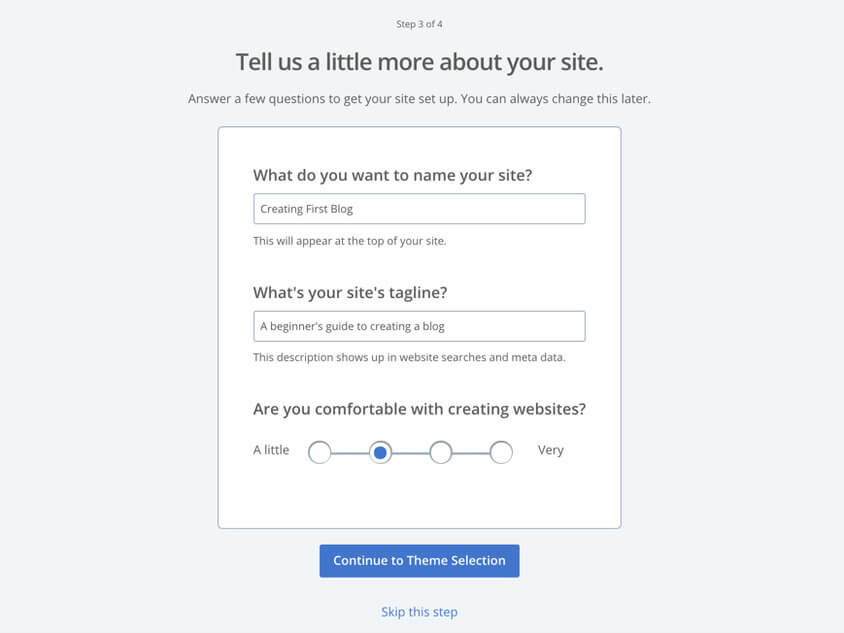
- Step 4 . Check out the suggested themes from Bluehost and see if you like any of them (if you don’t see a theme you like, skip this step). You can always change your theme and use a different one later. More information on this further on.
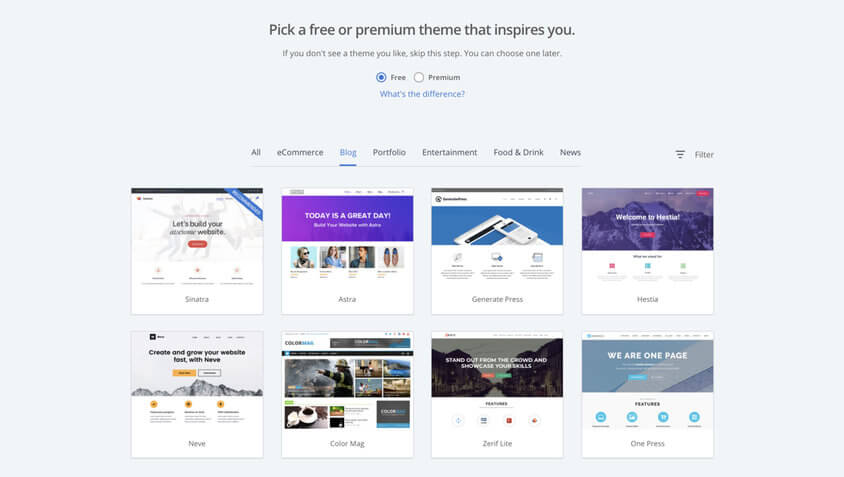
Once you finish setting up your blog with these 4 steps, you will be taken to your Bluehost account page. At this point, the WordPress software is installed and your blog structure is set up!
Launch your blog
Inside your Bluehost account, you can customize your WordPress blog site further based on Bluehost’s recommendations. These options are here for you to do some pre-launch customization to your blog.
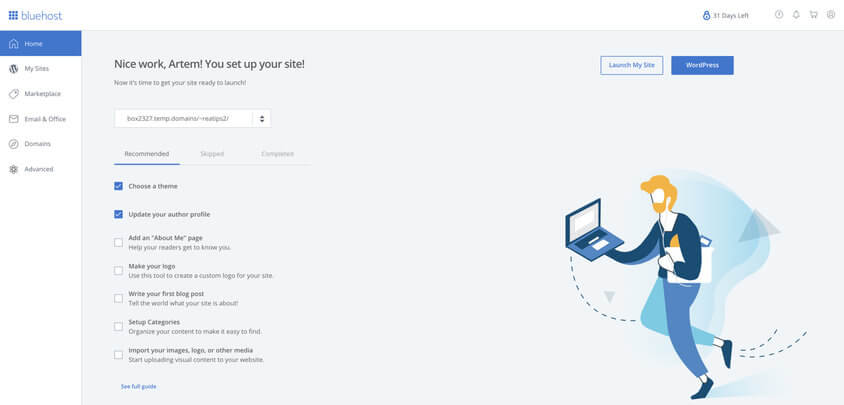
Your blog will go live after you click the “Launch My Site” button!
If you open your website in a web browser, don’t get frustrated if it doesn’t look quite right. This is just the first draft. Inside the WordPress dashboard, you will have to apply a few changes and add some content to make it look polished and complete. I will show you how to do this later!
You can access the WordPress blog dashboard from your Bluehost account by clicking the blue “WordPress” button in the top right corner of your screen.
Did you start a blog yet? → Click Here to Get Started
Next, as promised, I’ll show you how to find the right theme for you, and how to customize your blog.
Your blog first needs a face (design and layout).
Installing a new WordPress theme is exciting and fairly straightforward.
Inside the WordPress dashboard, under the “Appearance” tab, click “Themes”. You will be presented with some popular options. You can click on the WordPress.org Themes button and search for free themes. There are more than three thousand themes available on WordPress.org .
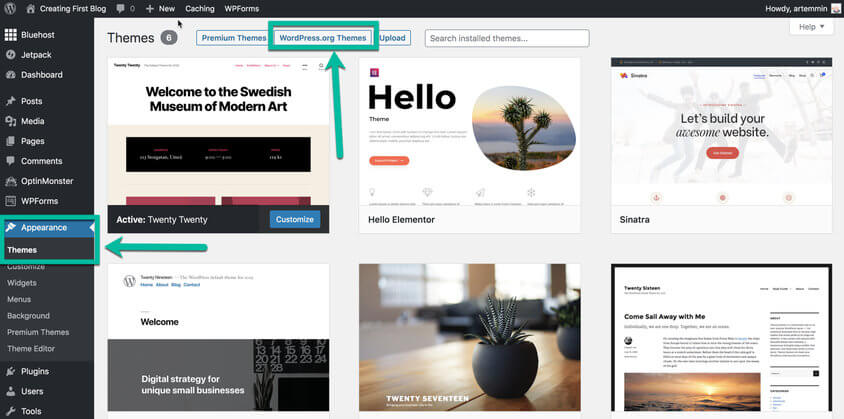
The look and feel of your new blog rely on the theme you choose. Your first-time readers will notice its overall appearance before they even look at the content. Select a theme that looks great, but also works for your specific needs.
Here’s a quick guide for choosing your theme by searching within the WordPress dashboard:
- Read the description – Most themes have a short description of features and functionality. Reading it can help you to figure out if the theme matches your needs.
- Preview the theme – Preview the theme (demo) to get an idea of the overall look, layout, and how customizable it is.
- Check the ratings – Star ratings will be visible in the preview and under theme details to give you a clear idea of how good the theme is.
If you can’t find a theme that you absolutely love, don’t worry. Settle on one that you like, and you can always change it in the future.
Once you install a theme, don’t be surprised if it still doesn’t look quite right. It is just a skeleton of a blog. You’ll have to fill it in with content (text, photos, videos, etc.) to make it appealing.
Should you choose a free or premium theme?
I think there are more than enough free WordPress themes to choose from for any blog topic.
If you don’t feel like searching through thousands of themes, you can easily start things off with either Twenty Twenty or Twenty Twelve themes. Both free themes are presented by WordPress.org and are popular with creators.
Remember, you can always pick a different theme later as you continue setting your blog. All the pages and unique content you create will be transferred automatically to a new theme layout.
If the current stash of free themes does not satisfy your desire, you can check the premium themes available. These themes are usually designed by third-party companies and sold on different WordPress theme sites. The price range for single-use licenses ranges from $30 to $500, depending on which premium theme you choose.
Blog theme customization
Remember, your WordPress dashboard is the back-end location where you will manage your new blog. It provides you with fast access to all of the tools you need to add content and fine-tune your blog functionality for the ultimate user experience. Your first step towards mastering WordPress is learning the dashboard.
WordPress has unlimited customization options so it’s impossible to cover everything in this “How to start a blog” guide. Instead, I’ll cover the first most important changes you should apply to your blog. For this example, I’ll be using the Twenty Twenty theme .
Make your blog’s logo
You can find the “Make your logo” tool in your Bluehost account. If you didn’t do it while launching your blog, now is the time to finish it.
Once you click the checkbox, you will be taken to an AI-powered logo maker. It’s an easy-to-use tool that you can use to create a beautiful logo for your blog in seconds. Start by entering a name and slogan (if you have one), the tool will automatically generate different types of logos.
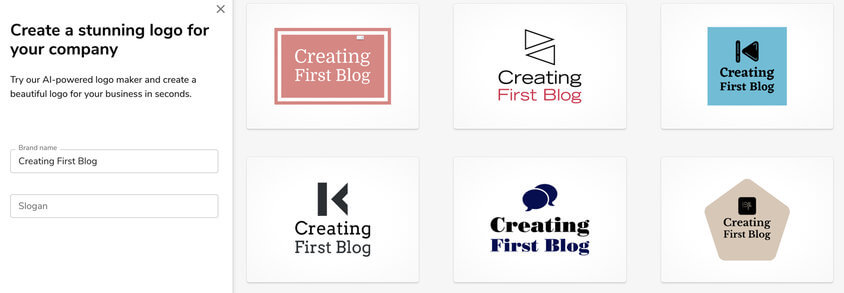
Select one logo you like the most, click on it, and further customize it according to your taste.
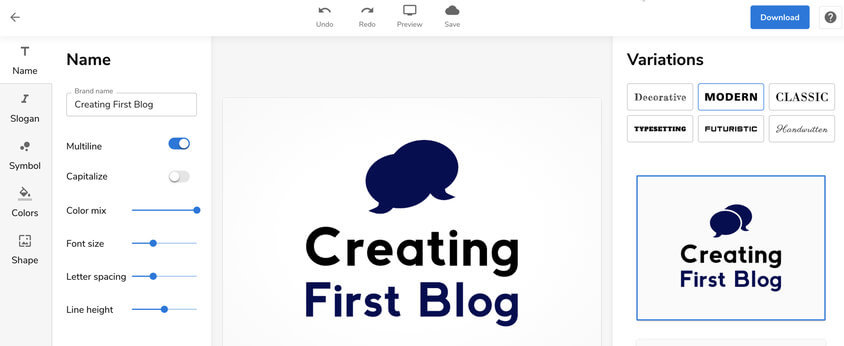
When you are done with your logo design, click the Download button and a new page will show up with your logo files ready to be saved to your computer.
Customize your blog
Now, let me show you where you can do general customizations of your blog. That includes: uploading the logo you just created (or will create in the future), editing the blog title and tagline, changing colors, uploading the background image, and making homepage settings changes.
As I’ve mentioned, I’ll be showing you how to apply these changes to the Twenty Twenty theme. If you picked a different theme the process could be slightly different. However, in most cases, all themes have similar customization options.
To start optimizing your blog, go to the WordPress admin dashboard. Locate the Appearance tab on the left-hand side and choose the Customize option.
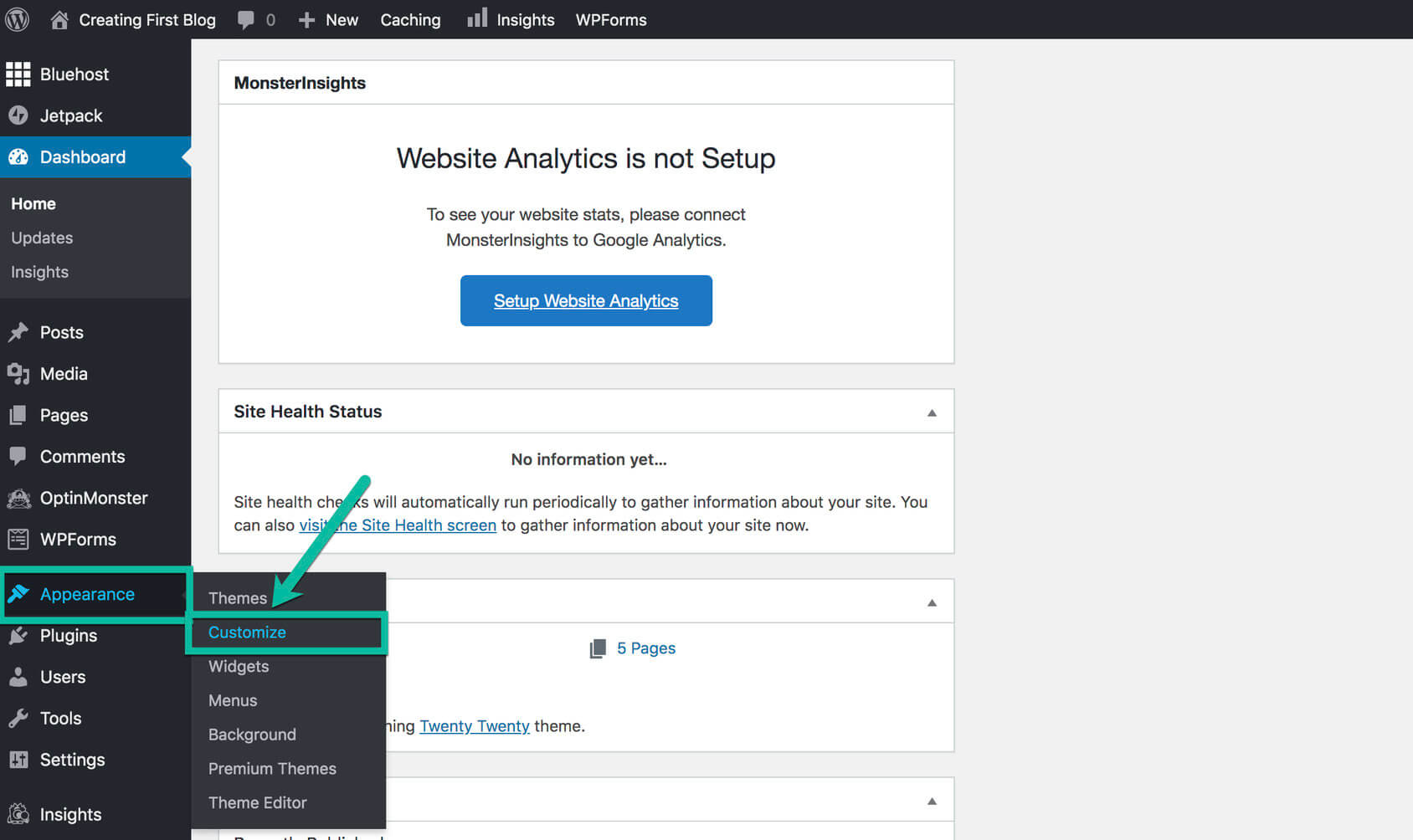
Each WordPress theme will customize a little differently. In my case, I’ll show you the customize options for the Twenty Twenty theme.
On the left-hand side, you will see the following Customizing menu options:
- Site identity – Upload your logo, change site title and tagline, and upload site icon.
- Colors – Change your blog’s background color, header, and footer colors, and customize the primary color.
- Theme options – Select if you want to show a search icon in your blog’s header and show an author bio for your posts.
- Cover template – Make additional changes to the page template such as the overlay background color, overlay text color, and overlay opacity.
- Background image – Upload any custom background image you want to start using on your blog.
- Menus – Customize your blog’s menu, social media menu links, and change the locations where they are displayed.
- Widgets – Customize your footer, add a description, and how to find you if you have a physical location.
- Homepage settings – Choose what’s displayed on the homepage of a blog. It can be the latest blog posts or a static page.
- Additional CSS – Add your own CSS code to customize the appearance and layout of your site (advanced option).
You can also check how your blog looks on different devices by using the menu at the bottom with three icons: desktop, tablet, and mobile devices.

Many themes (e.g. the Twenty Twenty theme) come with the new Gutenberg editor that revolutionizes the way users build pages and write posts inside WordPress.
Gutenberg is a visual editor that works on a blocks principle. So, when you decide to add a new paragraph, heading, image, video, or anything else, there are blocks you can quickly add to new pages or blog posts.
This way, creating blog content is much easier for beginners, whether you’re building a landing page or writing a new article. Blocks can be rearranged into a layout you like, and they’re here to make your life easier.
Add plugins to your blog
Plugins are bundled pieces of code that affect how your site looks and functions. They can add new functionality to your WordPress blog, extend your theme’s capabilities, and personalize a blog as a whole or in part.
While the majority of plugins are free, there are many that are offered for a fee, based on their unique functionality. At the moment, WordPress.org has more than 57,000 different plugins in the repository.
By default, when you set up your blog, Bluehost will automatically add some plugins they think are important for any website. You can review these plugins inside the WordPress dashboard and add new ones by clicking the Plugins tab on the left-hand side.
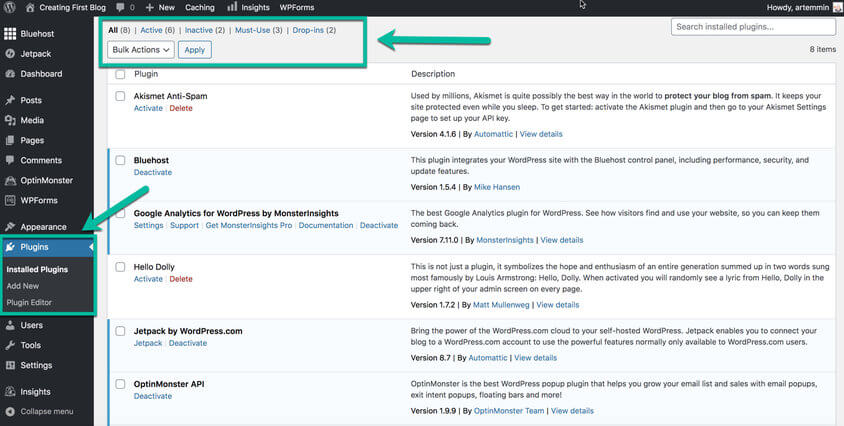
Here you can install new plugins, deactivate, delete, and update them.
Below, I’ll show you some suggested plugins that you should be using.
List of recommended plugins for bloggers
To save you time, I’ve selected some important plugins (free) for your immediate blogging platform needs:
- MonsterInsights – Google Analytics plugin for WordPress to monitor and analyze your website traffic.
- Yoast SEO – A comprehensive SEO plugin for your blog, to optimize your content for search engines.
- WP Super Cache – Helps with the load time of your WordPress blog and delivers content to your readers faster.
- Akismet – Protects your comments and contact form from spam and prevents your site from publishing malicious content.
- Contact Form 7 – A contact form with flexible email options. It supports CAPTCHA and Akismet spam filtering.
- Disqus – An alternative to the basic WordPress comment system with advanced administrative and comment capabilities.
- YARPP – Creates a related blog posts list at the end of each piece of content automatically to encourage people to continue browsing your site.
Congratulations, you just learned how to customize your blog and make web design changes!
The next step is to learn how to write content for your blog.
So far, you’ve established a domain name, chosen your blog hosting site, set up a blog theme, and you are ready to go. Your framework is complete.
Now comes the moment of truth and you can actually start blogging. You need to learn how to write your first blog post. On the web, any useful information or experience that you share with readers is called “content.” It must be something valuable that people will want to interact with and come back for more.
WordPress CMS is structured in a way that you can publish your content as Posts or Pages.
Before you begin publishing posts (day-to-day writing) on your blog make sure you fill in all the important static pages with content (such as About us, Contact, etc.). Let’s explore those types of pages.
Prepare and publish content on main pages
Depending on your individual needs you can decide what pages to publish. The following are the most common pages bloggers use:
- Homepage – This depends on what type of layout you choose. As I described above, when customizing your blog you can choose to display the homepage as a static page. In that case, you will have to prepare content for it.
- About us – The most traditional page on any blog is the “About us” page. This page tells new visitors what it is all about, who you are and why you run a blog about your niche topic.
- Contact – This page allows visitors to your blog to communicate with you. It can be a straightforward page with your email address plus your social network links, or you can use a simple contact form that visitors can use to communicate with you.
- Products, Services, Resources – Static landing pages with any additional information that you want to include on your blog.
The guidelines to publish a new WordPress page:
A blog page provides static content or information to the readers. Standard pages that bloggers use include: About, Contacts, Products, or Services. A page also can be a cornerstone (or evergreen) content with information that continues to be relevant to its readers. For example, this guide you are reading right now.
- To create a blog page, log in to your WordPress dashboard admin area using your login details (username and password).
- Hover your cursor over the “Pages” menu item on the navigation menu located on the left-hand side of the Dashboard. Click “ Add New ”.
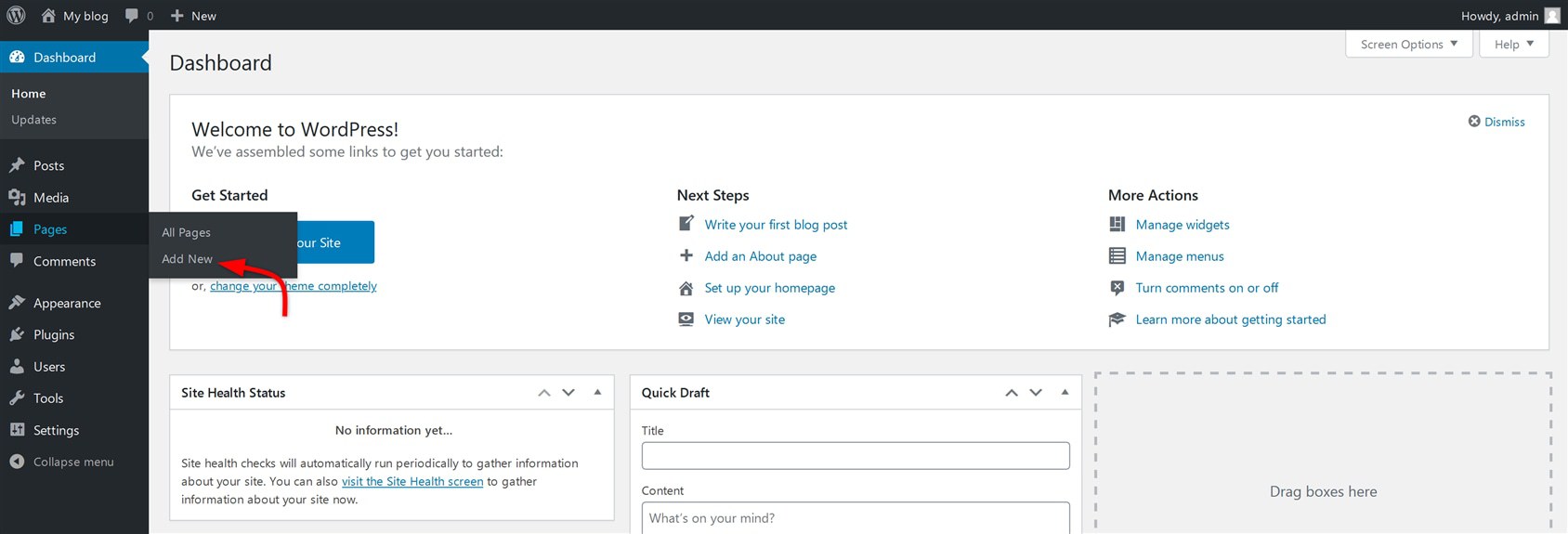
Write your first blog post
Creating blog posts inside WordPress is nearly the same as creating pages. However, for a blog post WordPress lets you select categories and tags while pages don’t.
Wondering how you can write quality blog posts? It’s simple.
Here is a simple 3-step approach to making great content of any type:
- Point – State your main blog topic idea that you are covering.
- Prove – Give an example of the idea you are covering.
- Perform – Give a simple way to execute the idea.
The guidelines to publish a new WordPress post:
In your first blog post , you can take a moment and introduce yourself. Tell your readers who you are, what motivated you to blog, and what you will write. The title of the post could be “Welcome to my blog”.
- Inside the WordPress dashboard on the left side, you will see Posts menu item.
- Hover your mouse cursor (or click) on the Post item. Then select “Add New”.

Next, I’ll talk about how to optimize your content for search engines.
Search engine optimization (SEO) is the process that website owners use to get more traffic to their web pages from search engines (such as Google).
According to recent studies, 53% of all traffic for websites comes from organic search (. pdf ). This number shows how important it is to make sure that you optimize your WordPress blog for search engines.
SEO involves many different tactics and techniques. As a blogger, you will have to get familiar with these. I won’t be talking about any advanced processes here. As a bare minimum, you will have to do the following for every blog post or page you publish on your blog: perform keyword optimization and add SEO meta tags on all pages.
Keyword optimization
This is the process of researching and selecting the right set of keywords that you think people will type in a search to find information like yours online.
Ideally, keyword optimization should be performed for any blog post or page. It’s important to select the main keywords (and related words) that you want to target for each page and make sure that you include these (and related words) within the content. This way it will be easier for search engines to understand what a specific web page is about when they crawl it and you have a better chance to rank higher in search results.
SEO meta tags
When you publish a new blog post or page, you will need to add SEO meta tags for each piece of content.
These are the SEO title and SEO description tags. These tags are not seen on the actual page, but Google will use metadata to better understand what the webpage is about.

If you want to start ranking your content in search engines, this is an important step to complete. SEO tags should be prepared and added when you create a new page or a post inside WordPress. You can add SEO meta tags via free plugins, such as Yoast SEO .
The title tag length should be between 50-60 characters (this is what Google typically displays) and the meta description tag can be between 50-160 characters .
By now, you’ve learned how to start a blog, how to create blog content, and how to get it discovered by search engines.
It is important to understand that you can write the most compelling copy in the world and design a blog interface that would sell people their own shoes. However, if no one sees it, all of your hard work is in vain. So, you need to know how to promote your blog.
Before you start promoting your blog, check if it’s ready:
- Make sure that your content is live and ready for promotion.
- Test your blog on different devices (desktop, tablet, mobile) and browsers (Chrome, Firefox, Safari, and Microsoft Edge) to check that pages open correctly.
- Check your contact info and test your contact form to see if it works well.
- Test your social sharing buttons so that people can easily share your content.
- Ensure that you interlink your content so that people can easily find other important information on your blog.
- Give your visitors one or more ways to connect with you and subscribe to your email list.
- Set up Google Analytics to track your blog’s performance and visitors.
Let’s look closely at the basic promotion and marketing activities that you can apply to grow your audience once you build a blog.

Let everyone know about your blog
Get started by informing your friends, family, and colleagues about your new endeavor. Basically, you should let anyone know who might be interested in reading your content.
You should also do the following:
- Include your blog name (URL) in your email signature.
- Include it in your social media accounts or any online communities you are involved in.
- Use every opportunity to get the word out about your new undertaking.
Be active within your niche
Get active on relevant blogs, forums, groups, and social pages.
Blogger communities are a good way to connect with other bloggers in your niche. You can engage, build friendships, and help each other in spreading content.
Here are some popular activities you can do:
- Blog commenting. Start posting comments on other relevant blogs. It’s a great way to build relationships with top bloggers within your niche.
- Social media marketing . You should make use of the social media avenues that best fit your own niche and style. Choose the one (or ones) that best fit your needs and start promoting your content to grow your audience. Some of the most popular social media networks that bloggers use on a daily basis are Facebook , Instagram , and Pinterest .
- Guest blogging . Take the relationship a step further and offer to write guest blog posts for another website. Just be sure that you guest post on reputable sites and that the content is directly related to your niche. Guest posting is an excellent way to build an online presence.
Promoting your content through other platforms
Before your blog becomes popular and starts to grow, you should look into leveraging other platforms on the web that already have some audience and readership. To give you a better idea, here are some of the techniques that you can use:
- Bookmarking sites . Submit your blog content to bookmarking sites that can offer your content to a lot of potential viewers who are searching for information within your niche. You should do this every time you publish a new blog post to spread the word. Here are some popular social bookmarking and content curation sites: Scoop.it , Reddit , Flipboard , etc.
- Content republishing . You can publish the same or slightly repurposed content on platforms such as LinkedIn and Medium. It’s best to publish content on your blog first, wait a few days while it gets indexed by search engines (Google), and then you can start posting it on other platforms. Also, make sure to link back to your original article as a source. You can learn about a republishing strategy here .
- Repurpose content . You can repurpose your content, create graphics, slideshow presentations, audio files, or even videos and publish it all on the platforms that support different content formats. Here is how you can make 64 pieces of content in a single day ( PDF ).
Getting organic traffic from search engines
By now, you already know that it’s important to optimize your content for search engines.
However, in order to increase your organic traffic, you will have to learn how to get your content to rank higher in search results.
There is no magic formula for higher rankings, but you should focus on the following factors:
- Create useful content for your readers, not search engines.
- Consistently create fresh and quality content.
- Make sure that the user experience is flawless.
- Ensure that your blog is secured (HTTPS), mobile-friendly , and loads quickly.
- Interlink your content and work on getting external links.
Advertising on the web (paid traffic)
Appropriate and well-informed use of paid media can help you to gain exposure and attention before your organic (naturally derived) traffic takes hold.
Paid traffic avenues include:
- Social media advertising on Facebook , Instagram , Twitter , etc.
- Search engine advertising via Google Ads or Bing Ads .
- Content discovery platforms such as Outbrain or Taboola .
Remember that you can always find other ways to promote your new blog.
Start building your email subscriber list
After starting a blog, you will begin attracting new readers and visitors. It’s a good idea to collect the email addresses of those who want to be notified when you publish new blog posts or share promotional offers. As people come to know and trust you, they will respond better to your promotional efforts.
Rely on the blogging fundamentals: a clear and well-functioning blog, focused and helpful information, engaging conversation, and practical advice. Your authority will come from helping and giving advice to your audience.
Monetization is the process of translating your blog activity into earnings.
You should keep in mind that blogging isn’t just about making money. It is about creating useful content and writing blog posts that will attract readers and make them come back for more.
When starting a blog think about adding content that will generate future income. Based on my own blogging experience, as well as from working with other bloggers, I’ve learned that specific kinds of content are more effective for generating money.
Here are types of content that you should consider writing and adding to your blog:
- Listicles or top list
- How-to guides
- Tutorials and manuals
- Product reviews
- Product comparisons
Now, let me show you some different ways how bloggers make money.
Blog monetization channels
Our case study of the blogging industry shows that 59.8% of bloggers make money through blogging.
But, how can YOU make money blogging? There are several options available, but below I’ll show you the best ways to earn income from a blog:
Running ads on your blog
There are seamless possibilities for you to run ads on your blog. Regardless of your niche, you can opt for ads that are specific to what you are writing about or ads that simply better serve your advertiser’s purposes.
Google Adsense , Mediavine , and Adthrive are some of the most popular choices for blog ads.
Enrolling in affiliate programs
Affiliate programs are ways of teaming up with retailers to promote their products and benefit from successfully carrying out sales through a commission.
Some things that you need to consider when enrolling in affiliate programs:
- The number of affiliate sales will strongly rely on the number of visitors you have.
- You need to be credible enough for your visitors to click on your links.
- You may want to consider placing a notice on your Terms of Use page that you do use affiliate links.
There are a few popular online platforms that offer affiliate programs if you want to get started, such as Amazon Associates , ShareASale , and ClickBank .
Selling your products and services
If you are creative and entrepreneurial, you could consider using your blog as a venue for selling your own products and services. This is an option especially as your blog grows in readership, authority, and popularity.
There are WordPress plugins, such as the WooCommerce plugin , that you can easily integrate into a blog and start using to sell products online.
Selling sponsored posts
Advertisers are always looking for exposure and are willing to pay you for placing a sponsored post on your blog.
Those posts usually promote advertiser products or services and are a good way to make money from your blog. In the future, if you’re able to build a popular blog and become an authority in your niche, the advertisers could approach you to publish their posts.
Above are the most popular choices to earn money. However, there are more ways to monetize your blog.

Consider the possibilities, and then choose the method or methods that best suit you and your audience.
As a minimum, you should – from the very start – begin compiling an email list of your readers through subscriptions. Then, when you are ready to recommend products, you will have ready access to those who want to hear what you have to say.
FAQs before starting a blog
Few more things before you get started with your journey. Below are some helpful facts and common questions that many people ask before they start blogging.
Simply put, Yes , blogging is still relevant in 2024 and beyond. Technologies change. Business processes evolve. But I believe that making a blog today is still as worth it as it was 10 years ago. Blogs are a fantastic way of introducing your ideas, products, brand, business, and content to the world. I’m not saying that blogging is easy. To be successful as a blogger you have to work hard and give your blog the attention it deserves, especially at the beginning. You’ll have to create quality content, interact in the comments section, promote your blog on social media sites – and then repeat. Will you be able to motivate yourself to do it right, day in and day out? Blogs are an excellent tool for community-building, but if you’re not willing to be the central voice, i.e. the focal person for it, you’ll have trouble maintaining it. Blogging is a public act that will put you in the spotlight. The more successful you become, the more attention you will receive for your words.
This is one of the most common questions people ask. Let me explain to you some ins and outs of free blogs. Several platforms allow making your blog for free. You can register a free account (free blog) on WordPress, Blogger , or Wix , but you should know a few things before you get started: * If you sign up for a free account, you will get to use the service on a subdomain of the platform. Your blog name will look like this: “blogname.wordpress.com” or “blogname.blogspot.com”. In the blogging community, this type of blog is a sign of an inexperienced beginner who likely won’t be taken seriously. * Your free blog will be subject to rules and restrictions set by the platform. Free platforms may limit or prohibit you from using ads, or they may even place their own ads on your blog. If you’re serious about blogging, you’ll want to move away from this option sooner rather than later. So, what is the best way to build a blog? To take any blog to the next level, you will have to start paying for it. That way you can get full control of your blog, access to more features, and a custom domain. To get started right, I strongly suggest setting up a self-hosted blog and installing WordPress software (free open-source) on any web hosting account. If free blog hosting is currently the only option for you, create an account on one of the free platforms mentioned above.
Starting a self-hosted blog is not as expensive as you might have initially thought. If you choose to host your blog with Bluehost that I recommend, you can have the environment ready for as low as $2.75 per month! While usually, a domain would cost you around $15, with Bluehost, you will get one for FREE! The basic package also includes a free SSL certificate (which protects data transfers on your site and makes it safe), 50GB of storage, and unlimited bandwidth which means you can have as many visitors as you are able to attract to your blog. And this is more than enough to start with.
For starters, don’t worry. If you decide to switch to a self-hosted WordPress, you can quickly and painlessly move your free blog to your new host. Most of the blogging sites allow you to export the content to another site. And WordPress features a ton of tools that will automatically import the info to the new blog. If you are running a Blogger (Blogspot) site, let me show you how to move it to WordPress , step-by-step.
Often, people think that they should start blogging about popular topics so they can make money. And while the truth is that you might be able to attract a larger audience if you write about smartphones instead of blogging about something specific like tuna fishing, that’s the wrong way to go. In this case, it would show that you are writing about something that you might not completely understand and love. The result would be an unsuccessful blog that not even you would enjoy. Instead, new bloggers should start a blog and write about something they love or follow. Even if it is a smaller audience, their passion and expertise will attract just the right people. If you choose to blog about something that you are passionate about, you will be able to connect with your audience, which will help you to grow and even earn money.
So, now you have picked a niche of interest, everything seems to be going great. What now? How do you start making money off of it? Do a market search The first thing to do is to check out the competition. Here is what you can do: * Perform a simple Google search for your niche main keyword and look who ranks in the first ten results. * Check out social media networks, or even paper magazines to figure out your competition and see whether you’ll have the audience you want. * Use free SEO tools to get insight into the volume of searches so you know what you’ll be dealing with. If search volumes are very high with a lot of competitive websites, you might want to narrow your niche down. Explore all of the possible keyword ideas that would be of interest to the audience, so that you can find that sweet spot between great demand and low competition. Check out how profitable your niche is If you are planning to make money off a blog, you need to find out whether the niche you’ve chosen is profitable. You can once again easily check this with a Google search. When you type in your keywords, do you see any ads that pop up as the first result? When brands or businesses are paying to advertise their products or services related to your niche, you’ll know you’ve picked a good topic, and you’ll be able to monetize your blog with ads. Another method for monetizing a blog might be through selling affiliate products. Amazon, for example, has a nice affiliate program that allows bloggers to get up to 10% commission when they send a buying customer to them. For example: if you are blogging in the yoga niche, you could link to Amazon affiliate products like yoga pants, mats, etc.
There are two main categories we can talk about when it comes to getting paid as a blogger. One is promoting third-party products, the other requires you to sell your own products or services. 1. You can get paid while promoting different products and services on your blog through affiliate programs or ad networks. * Affiliate programs – you can get paid a fixed amount or a percentage for sale that comes from your site (CPA model) or some programs offer a revenue share model where you could be constantly getting a percentage from the amount your referred customer spends. * Ad networks – with ads you get paid for pay-per-click (PPC) or pay-per-impression (PPI), also sometimes referred to as pay-per-mile (PPM). You get paid for the number of visits (impressions) on the page where your ads are displayed. 2. You can earn money and get paid through selling your own products or services on your blog. It’s a straightforward process but needs some involvement from your side. Here are some ideas to earn extra income as a blogger: * Selling courses, training, and coaching * Publishing sponsored posts and listings * Selling products or consulting services These are just some popular ways of earning money while blogging. Learn more about it through our beginner’s guide.
Can you make money and how much you can make depends on many factors. Are you just starting out or have you been blogging for some time and have a group of people who trust you? Is it your primary focus or do you manage your blog in your spare time? According to Glassdoor , bloggers in the United States on average earn $52,000 per year. Obviously, some earn a lot less, while there are influencers who have millions of people following them and can earn more than $100,000 per year. Some even say blogging for money gets them more than a million dollars per year. Do you want to know how to make a living blogging? Once you start your blog, you will have to work hard before getting that first paycheck. Also, passive income needs time to start increasing. Different advertisements and banners will make sense only after you have a well-established blog. While it is possible to get a few bucks per click on a Google ad, you will have to develop your site and build an audience before that becomes a reality. So, when starting out, you can expect only a fraction of a dollar for each click, but do not let that discourage you. Everything has a start, so does your income from a blog.
I always love to hear that someone is interested in learning WordPress or in general how to blog for free. That’s because I enjoy sharing the knowledge and experience I have been collecting for many years in this business. I have dedicated an entire section of our site to learn WordPress where you can level up your WordPress skills and understand the best practices. The section will guide you from the very beginnings of your WordPress site to advanced techniques that will teach you how to develop a unique site that both you and your visitors will love.
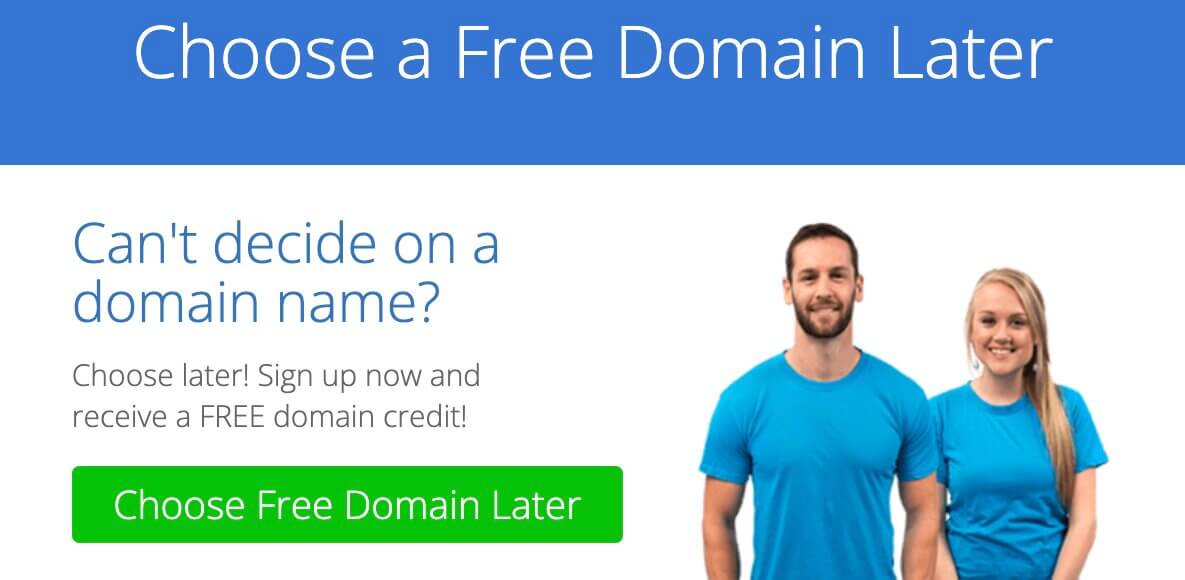
Congratulations! You’ve learned how to start a blog. You have your own domain name, hosting space and your blog is set up. Next, you will need to get familiar with the WordPress dashboard, make desired changes, start content creation, and promotion to become a successful blogger. Check out all our resources for starting a blog and learn how to blog successfully.
211 comments on “How to Start a Blog and Make Money [Guide for Beginners]”
Starting a blog and making money involves selecting a niche, creating valuable content, and monetizing through ads, affiliate marketing, or selling products/services, offering a lucrative opportunity for beginners with dedication and persistence.
These guides really help me out. I have been at this for over a year and I’m still a lost duck but I am slowly coming around. Thank you for the great in depth details. They are much appreciated.
Amazing insights for starting a blog, I’m a new blogger and this guide will definitely help me. I have started habitatmentor.com KUDOS Love ❤️ from UK
thanks for giving us this very useful article!
We’re so glad you found it useful!
Thanks for giving me information. Your article is very helpful for everyone.
Your article is very useful; the content is great. I have read a lot of articles, but for your article, it left me with a deep impression. Thank you for sharing.
We’re so glad to hear that!
I really appreciate the work you have done. You explained everything in such an amazing and simple way.
I really appreciate the work you have done, you explained everything in such an amazing and simple way.
Your post is a valuable resource for aspiring bloggers, and it has inspired me to take the plunge and start my own blog. Thank you for sharing your knowledge and expertise! Keep up the fantastic work!
Glad to hear that. Let me know if you need any help!
Thanks so much. Such an in-depth and step by step guide. Found it really helpful.
I love the itemization of the costs in step #2 so that it’s clear how much it would cost to run a blog. This info makes it helpful for setting up a budget. Thank you.
I really appreciate your effort in writing this post. You may never know how much you inspired me with this guide. I’m definitely giving blogging another shot, and I hope it works this time.
Thanks again!
That’s great news. We wish you good luck with your blogging journey and feel free to contact us in case you need anything.
Hi Anya, Thanks for the very thorough and in-depth article. There’s never been a better time to start a blog. I would add to your promotion section that you should also use Pinterest as a search engine, not just a social network, as it can be the ideal source of traffic for new blogs. Best Regards, David
Thanks David for reading our guide. We agree with you, Pinterest is indeed a very good search engine on its own. It might not be suitable for all blogging niches but is definitely worth using as an additional source of traffic.
Wow! Thanks a lot Anya. This post has been a great blessing to me. I plan to start a sports blog and I will definitely be using the information I got from you. Thanks again.
Thanks Joshua. We’re glad that you find it useful and we wish you good luck with your sports blog!
The information you’ve shared in this guide is remarkable. Thanks for sharing such quality information.
Thanks Julia!
Thank you for this great guide. I have three questions.
1. I’m hoping to start a blog that will require a lot of sports images from a major sports team. I see other local bloggers use Getty Images. Is this easy to do? Is there a cost for that?
2. Also, I want to add a message board and
3. live chat functions.
Are those expensive or hard to integrate?
Thanks very much!
We’re happy to hear that you like our guide, Daniel. Hopefully, it helps when starting your new blog. Answers to your questions: 1. You can find and use many royalty free and stock photos but if you want to up to date sports images you will need to pay. For example, Getty Images is famous for having images from every major sports event but their monthly plans can be expensive. 2 & 3. You can easily add a message board and live chat functions to your WordPress blog via plugins. It’s easy to install and set up.
Is there any other information regarding security? Like preventing people from hacking our website and things of that sort . Also , very concise and informative guide! I wish more guides were like this
Not sure what exact information about the security you are looking for, but here is the guide we have – The Beginner’s Guide to WordPress Website Security .
Thanks so much for this post – super useful. Just one thing I’m a bit confused about. If the Bluehost and WordPress are both hosting providers – what is the WordPress you are mentioning within Bluehost? Sorry if this is a bit confusing but trying to understand it properly 🙂 Thanks in advance for your feedback!
Hi Aleksandra,
Sometimes new bloggers get confused. I’ll try to put it simply for you.
1. WordPress.org is an open-source (free) software but in order to use it you need to install it on your own web hosting account. This process is covered in our guide. If you don’t have a web hosting account yet you can use Bluehost (or any other hosting company ). 2. WordPress.com is a hosted blogging solution, which means that they offer all-in-one service including hosting and domain name for premium plans. You can check this guide .
Personally, I prefer to use WordPress.org since you get more flexibility that way. But depending on your situation you can go with either option.
Hope I answered your question. Good luck.
Leave a Reply Cancel reply
Your email address will not be published. Required fields are marked *
Spring Sale: Get 15% off selected writing courses, only through April 19! Learn more »

In our view, writing should not be a popularity contest, a struggle for validation, or a competitive sport.
Instead, writing is a personal journey : an ongoing exploration, personally meaningful in ways and for reasons that are unique to each one of us, and with destinations that we ourselves choose and venture toward.
In this article, we propose a structured way of asking a simple question: Where do you want to go on your writing journey in 2020?
What is a Writing Journey?
Your writing journey is your own process of ongoing exploration and growth within your writing.
When you travel along your writing journey, you are accountable—not to someone else’s definition of success, but to exploring and growing as a writer in the ways you find meaningful and fulfilling.
The purpose of Writers.com is to support each person’s writing journey: to create a community of writers who are connecting and deepening in our writing in the ways that matter to each of us.
Make sense? Wonderful! The questions below can help you map out your own writing path, through 2020 and beyond.
Seven Questions for Your 2020 Writing Journey
Please go through each of the questions below in any way you like. You may get the most benefit if you consider each one a writing prompt—open a notebook or a blank document, and then for each question:
- Read the question, once or twice.
- Take a deep breath and try to feel into what comes up.
- Whenever you’re ready, do a short free write, either timed (1 to 5 minutes) or until you feel you’ve said what you want to say. Don’t worry too much about editing, just try to get your thoughts and feelings out.
- Move to the next question.
1. Why is writing important to me?
Start at the broadest level: what is writing to me, and what makes it an important force in my life?
Suggestions:
- Take a step back. If an easy answer pops into your mind (“Because I have a manuscript to finish!”), you may just want to sit openly for a few seconds, take a few breaths, and see if something deeper comes through.
- Most likely, your reason for writing will be something you can feel . If you write poetry to connect with the beauty and strangeness of the world around you, you can probably feel that impulse when it comes to mind. If you’re writing a memoir to record and honor your family history, you can most likely feel that too. Our deep motivations tend to be feelings, and being in touch with those feelings puts us on solid ground.
2. What are my vision and goals for my writing?
Based on my broadest motivations to write, where, overall, would I like my writing to go?
- Your vision may be more general—a feeling, like the pride of accomplishment, or the feeling you get when something you write really connects—or it may be more specific, like having a certain number of works published in a certain way.
- Your goals are “vision you can measure.” That can be almost anything—not just pages written, manuscripts submitted, and so on. Maybe you’d like to eventually complete a novel trilogy, or you’d like to be someone who writes one poem per week that you really like, or someone who journals regularly for the next five years, or who is finally brave enough to share a short story with your spouse.
- Don’t treat these goals as obligations —things you can judge yourself over or fail at—but simply as possible answers to “What, specifically, would fulfilling my overall vision for my writing journey look like?”
3. Where would I like to go in my writing journey in 2020?
Based on my overall vision and goals for my writing, where would I like to go with my writing in 2020?
- This is asking you to envision goals for your writing in 2020. Again, a goal doesn’t have to be only in terms of pages written or works completed. Maybe by the end of 2020 you’d like to feel you’ve made major progress in writing rich, three-dimensional characters. If you have a clear sense of what “major progress” would feel like, then that’s a great direction for the year!
- Rather than thinking “What should I do?” think, “What would I like to do?” and make that your goal or goals. Again, this is about visualizing a writing journey that will be fulfilling and enjoyable for you, not about judgment or obligations.
- Try to come up with realistic goals for the year: don’t plan on overcommitting yourself. Life will be busy in 2020 just like it was in 2019, at least until they finally ship us our robot butlers.
4. What commitments will I need to make in order to make this progress along my writing journey?
To explore my writing in the way I wish to in 2020, what will I need to commit to doing?
- Think broadly: the answer is probably not simply “write 500 words a day.” Maybe you need to set up a writing space in your home. Maybe you need to make sure to attend your family reunion, and to bring a notepad and a recorder. Reading regularly in the area of writing that you’d like to grow in is a great commitment to make. And so on.
- Do try to be specific, if you can, in terms of the size of these commitments. How many sci-fi novels would you like to read in the process of writing yours? Make sure that you’re not overcommitting yourself, beyond the point of your exploration being fulfilling and enjoyable to you.
5. What obstacles will I face on my writing journey?
To explore my writing in the way I wish to in 2020, what obstacles will I need to work with?
- Be honest here! Writing is full of obstacles big and small, internal and external. Looking at them openly and nonjudgmentally is a very healthy and even healing process, if we’re used to hiding from them and wishing they’d go away.
- Try to consider both practical/external and personal/internal obstacles, as most of us face both.
- To get you started: we all experience practical obstacles including limited time, competing priorities, unexpected life events, knowledge gaps to fill in (how to craft a poetry collection? how to plot out a novel? etc.), and many others. How do these play a role on your writing journey?
- For many of us, our personal obstacles are rooted in self-doubt (am I and is my work “good enough,” “talented enough,” “original enough”?) and uncertainty (“will I be read,” “am I doing this right”?). We also experience natural fluctuations in discipline, motivation, and enthusiasm. How do these and other personal challenges play a role on your writing journey?
- Don’t be hard on yourself! Looking at our obstacles is a way to open to them and to ourselves, and to work from a basis in reality— not to judge or condemn. These obstacles put you in the company of the exactly 100% of writers who are dealing with them too.
6. What will I do to work with these obstacles?
How will I plan to work with the obstacles I’ve identified as I move along my writing journey in 2020?
- The idea here is to try to have a friendly plan for your 2020 writing journey that acknowledges that things are challenging sometimes, and that has some built-in approaches for accommodating those challenges when they arise. “I will never doubt myself and my writing” would be a very bad plan to make. “When I am doubting my writing, I will relax and look for support and guidance in a community of other writers” would be a great plan to make.
7. What first step can I take now?
Given the writing journey I wish to take in 2020, what first step can I take right now?
- This part can be fun! If you want to start writing love poems this year, why not write one, without judgment? You can keep it as a milestone of your journey for the year. If you want to write a Western screenplay, why not dig out the cowboy boots from the garage and remember how they feel to walk around in? Again, this whole thing is your own journey, and even though it’s difficult at times, you should also find it fulfilling, creative, and fun.
- Along with the fun, now is a good time to put in motion steps that will help your writing journey develop momentum and structure. If you really want to read a book on character development, now might be a good time to order it, so that you’re building a chain of actions that start today and take you forward from here.
Next Steps After Asking These Questions
If you’ve gone through this exercise, you should have a lot of wonderful raw material to craft a fulfilling 2020 writing journey. You may want to go through what you’ve written down, and begin to design specific plans and commitments for the next weeks and months in any way that works for you.
Again, look for a mixture of “diving write in” with some first steps you’d enjoy taking right now, and also beginning to look ahead and build a sense of steady, enjoyable progression into your year as a whole.
Wishing You a Wonderful Writing Journey in 2020!
I hope you’ve enjoyed this exercise. Again, the main takeaway is simply to be friendly to yourself. Your writing journey is yours to travel. If you’re learning, enjoying yourself, and deepening your experience of what makes writing meaningful to you, then that is, very literally, the whole point.
If our online writing courses can help you along your journey, we’re delighted. And, as always, please contact us anytime to let us know how we can help your writing journey, in 2020 and beyond!
View Our Writing Course Calendar
Frederick Meyer
These are excellent questions for every writer no matter what stage. I’d add a quarterly review, as well.
[…] https://writers.com/seven-questions-for-your-writing-journey-in-2020#:~:text=What%20is%20a%20Writing… ; […]
Leave a Comment Cancel Reply
Save my name, email, and website in this browser for the next time I comment.
Join my monthly email! Sign up
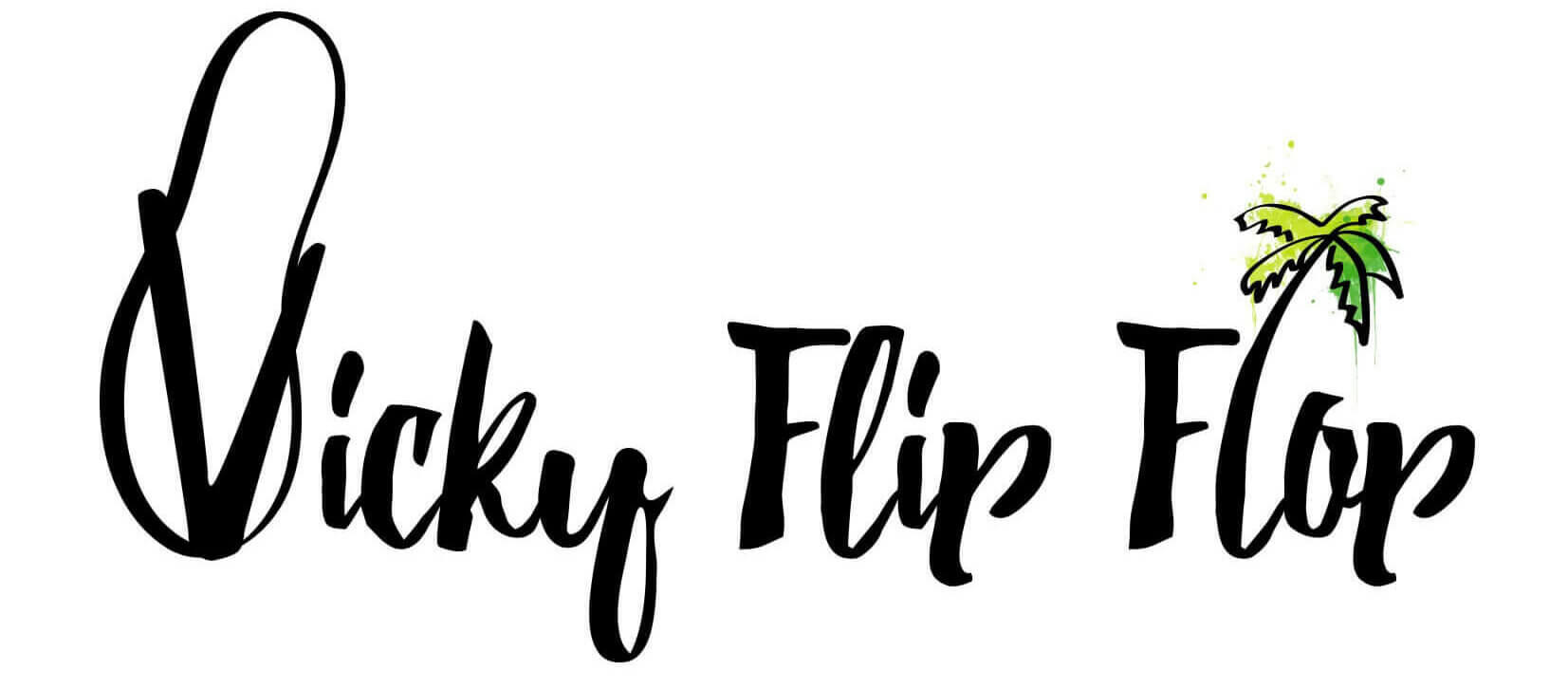
Travel Bloggers: What to Write and How to Write a Travel Blog in 2024 (50+ Tips)
“I want to start a travel blog, what do you think I should write about?”
True story.
I was a few drinks down at a London Travel Massive event and a lady unknown to me had just targeted me with the above. In fact, interrupting the conversation I was having midflow. Usually full of advice and happy to dish it out this question had me stumped, as much as her demeanour.

There’s no sugar coating it: I really think you should have at least a few ideas of what you want to write about before you start even thinking about setting up a travel blog. If not a few fully written posts so you have some material to play around with when it comes to style and design.
Since then I’ve often been asked how to write a travel blog, and think back to this night.
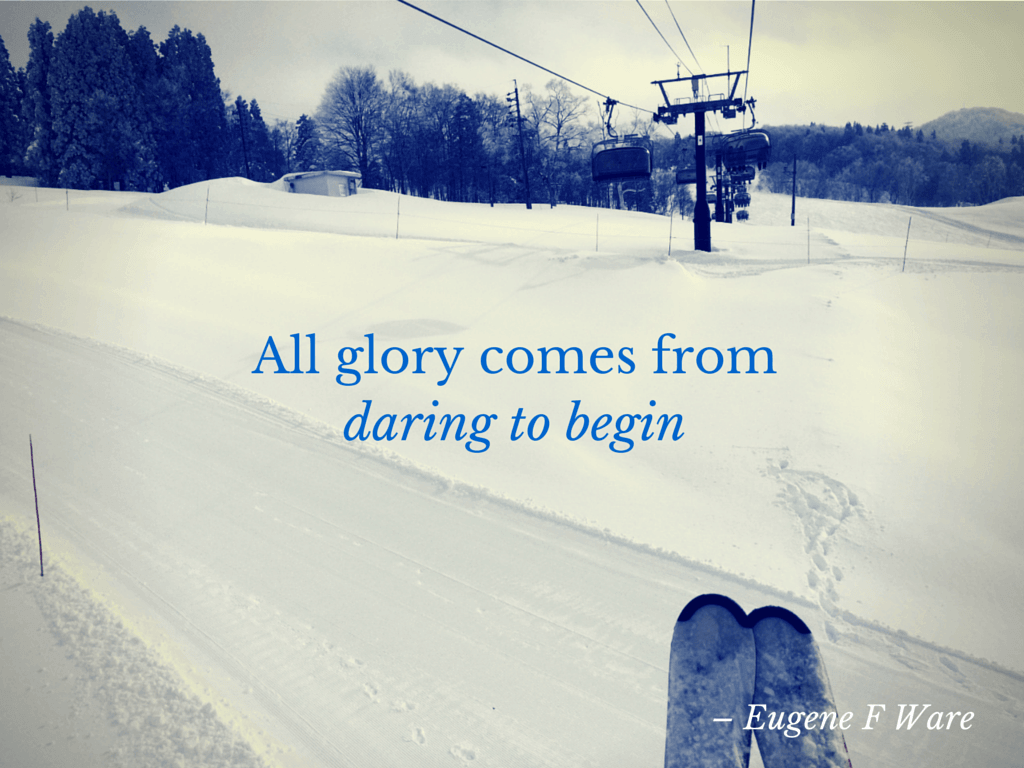
Talking about the interaction with a close fellow travel blogger the next day we established that both of us had lists of at least tens of articles we wanted to write, but seeing as we both worked full time at that point, never had the time to see them through. Though I could always rely on a professional essay writing service to help me with the writing part, that’s something that I prefer to do myself.
You can’t win.
If you’re in ‘clueless Cathy’s’ camp above, and are stuck for what to write about on your travel blog, what you need is some travel blogging inspiration.
Take a look a the ideas below on what to write in a travel blog and think about which idea appeals to you most. Then, just get started!
This is a pretty long post so if you’re all good for inspiration but need some advice on how to write travel blogs , click to go to the second half.

What to write in a travel blog: 10 ideas
If you’re trying to work out what to write in a travel blog, here are 10 ideas for you. When it comes to travel blog writing you might just need a few ideas to start you off, and then the creative juices will start to flow and travel blog ideas will be flowing out of you.
Use two or three of these to get you started writing your travel blog.
If you want to see a travel blog example, take a look around my blog, obviously – and also check out this list of the top 50 travel bloggers in the UK . If that doesn’t give you inspiration, I don’t know what will!
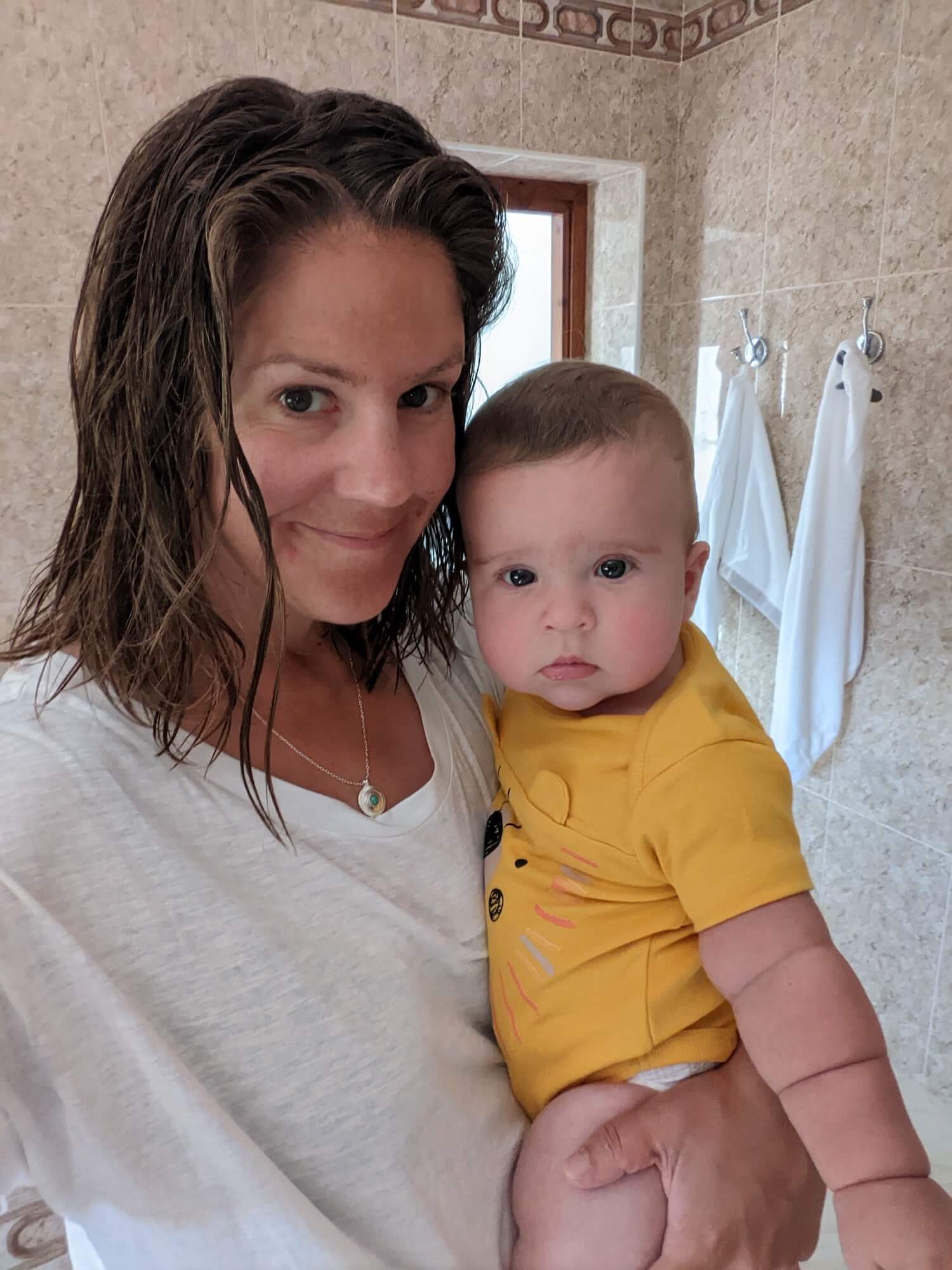
1. Write about your first holiday
This is a good way to get started in blogging about travel. Tell your readers about your memories of your first holiday – I did this when I found some Euro Disney memorabilia when I was cleaning out my room. It was my first holiday abroad and I’d kept the sugar sachets from Disney for almost 20 years! Think about describing the way it affected all your senses to get you started. Are there particular sounds, smells and sights that take you back to that moment in time?
Take my advice, first printed in Wanderlust Magazine in Could You Write a Travel Blog?
“Before you decide on a name, platform or topic, take a deep breath and close your eyes,” says travel blogger Victoria Philpott. Vicky, who blogs alongside her day job, suggests wannabe bloggers start by conjuring up their happiest travel memory and letting the story flow.”
2. Write about your locale

London is the number one travel destination in the world, if you live there you’ve got enough content to see you through for years. Find unique events, have a unique view and there you have your next article. And that’s just an example of my blogging gone wrong – I lived there for years, got to know a few neighbourhoods really well, but did I write about them? No. They’re straight on the never ending to do list.
I spent my first 18 years in a village in the Midlands called Barton-under-Needwood (pop. 5000). A quick Google search shows me that no one has written any sort of guide to things to do there. There’s a unique opportunity, especially as there are new developments in the area. This might not seem like the most exciting post if it’s covering somewhere you lived for so long but your insider knowledge is invaluable and someone, somewhere, will be interested.
You never know when world interest in any place could start to peak and you’d be all set up to be the go to person on that area.
Writing in a travel bullet journal is a great way to get started.
Subscribe on YouTube to see more of my adventures
First travel blog post
Travel blog writing doesn’t have to be about exotic, faraway places, it can easily be your own neighbourhood. In fact, I find that a lot of travel bloggers who’ve been doing it as long as I have, have come back to England and decided to concentrate on writing their travel blogs about here, as it suddenly becomes so much more appealing.
Follow me on Instagram @VickyFlipFlop for the latest.
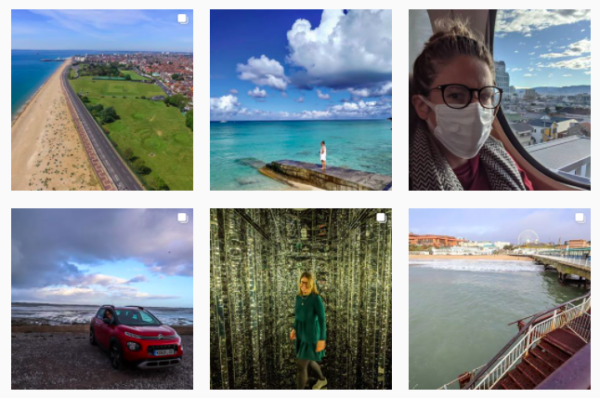
3. Where shall I go on holiday next year?
Don’t answer me by saying , answer by writing in blogging about travel. Create a blog post with all the reasons you have to advise why I should go to a certain place on holiday. Another aspect of travel blogging is persuasive writing.
There are a few destinations I’ve been to that I’ve really, really loved and I want my readers to see them too. In writing about New York , Vietnam , Porto and now Tokyo I want to persuade my readers that they should go too.
If they like my blog I know they’ll like them, and a happy reader will come back for more.
Watch this little video of what to write about for more ideas…
4. Write about you
The juiciest posts are the most personal ones. They’re the ones I like to read to get to know the blogger I’m reading about. I admire people who can be so honestly open about life, people like Toni over handling mental, health and family issues while travelling and Planet D about how their travel blog saved their marriage .
Travel blog examples like these help you to see there are real person at the end of these blog posts – real people with real problems.

I find it very difficult to write posts like this. In fact there are only two on my blog: one about why I was going travelling when my boyfriend dumped me and a dedication to my nan when she died, which I can’t read without crying as I’ve just proven to myself.
If you’re suffering from blogger’s block – bit like writer’s block – then this is the post for you.
READ MORE: 66 Positive Affirmations for Writers
5. Your thoughts on a destination
I really like writing about my impressions of a country once I’m back and have processed my thoughts, feelings and photos.
Posts like What Vietnam was Like For Me and What is Cuba Really Like? Busting the Tourist Myth may not be as instantly appealable as a quickie list post on the destination but writing them makes me happy.
I like to read back over them to remind me of how I felt when I was there as you can really use your experience and creativity in posts like this.
Pin this travel blogging guide for later?

Lists are popular for a reason – they’re easy to read and quick to do. Whole websites have been created to just feature lists although they’re usually pretty flakey.
Outlandish titles like 11 Awesome Ways to Sneak Alcohol into Festivals will usually generate a few more views too – if audience figures are one of your travel blogging goals that is. Look at other bloggers’ travel blog examples for inspiration.

When I’m in a destination I’ll look for the best things to do there and it’ll be a list I’m after, not some think piece I mention above. So give your audience what they want and write a well-researched useful to do list.
7. What’s popular?
Some of the most popular topics on my blog are Vietnam and Glastonbury. I rank well for these in Google and I can see from my analytics that my readers keep coming back for more. Once you know that you have a popular topic or post on your blog it makes sense to keep creating more valuable content around it.
Someone once said to me: “Go the extra mile, it’s less crowded there”. Meaning, put the effort in, more than anyone else, and you will be rewarded. Or something along those lines anyway.
You can link from your already popular posts and know that your readers will enjoy it. Take a look at the keywords they come in on on Google Analytics for inspiration on how to write more.
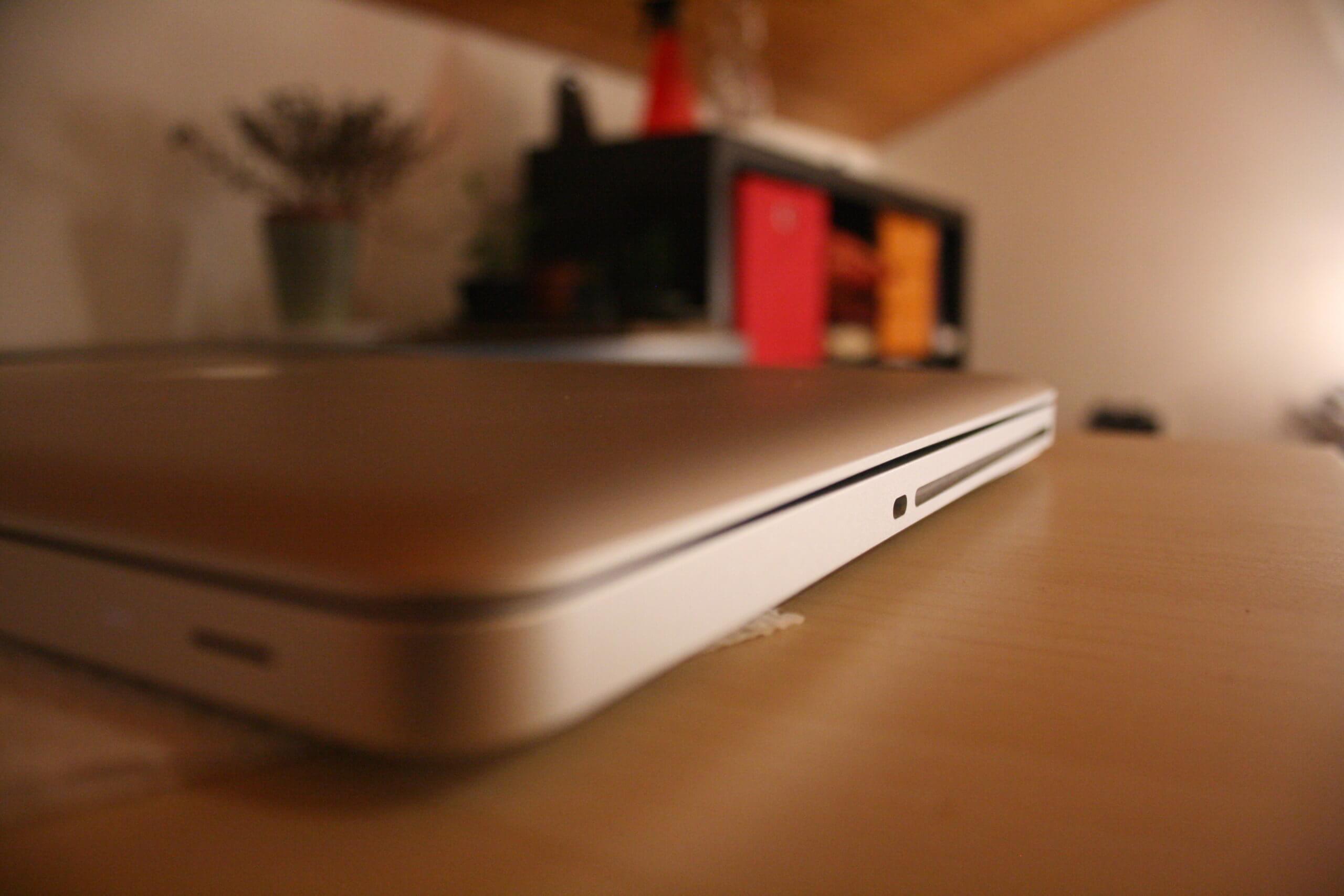
8. What do you want to read?
When you’re looking for information on a destination make sure to note the questions you have and the answers you can’t find – then you know the gaps to fill when it comes to you writing up your trip.
From my research and subsequent article on The Best Things to Do in Vietnam According to Travel Bloggers I found that no one had really done a guide to travelling around Vietnam, it was just all advice on particular aspects.

It took me ages to plan that trip so I wrote up all my findings and now my Two Weeks in Vietnam Itinerary is the second most popular post on my blog. More importantly, it’s inspired loads of people to explore Vietnam by themselves, rather than book on expensive tours.
I’ll pat myself on the back there.
9. Go niche
Sometimes the nichest of niche things work well when you’re blogging about travel, as you’ll be answering very specific questions.
Another of the most popular articles on my blog is 9-Hour Stopover in Qatar: Is it Worth Exploring? Not something an average reader would be interested in but because it’s so specific and not many people have written about it, it does well in Google search and again, I’ve helped people decide on what to do in Qatar.
Insider, actual tried and tested travel knowledge, is what makes a travel blogger stand out over the average travel company.
10. Interviews
Interviews are a great way to get started if you need some inspiration. Don’t just look to other travel bloggers though – unless you’ve got an exclusive or they’ve got a really interesting story there are already so many about.

Instead, interview people from your travels and write a profile of them rather than just a Q and A. This will help you to get more of you in there as well as them. It also means it’s not just an email exchange but a well thought out background piece.
How to write a travel blog without travelling
Learning how to write travel blogs isn’t easy, and it may take a while for you to find your style. Stick with it, it’s fun!
As you’ll have just read in those examples, you don’t actually have to be travelling to write a travel blog. Interviews, lists, you, they all work if you don’t have the time and money to be constantly on the road.
Look on the bright side – you have the opportunity to spend the time over your writing instead of rushing between destinations. If it was me, I’d pick a destination or theme, and stick steadfastly to that.
If you’re good at budgeting, you can help people plan their budget for their next trip, for example. Topics about finding cheap flights or hotels are in high demand. You can do some research and cover these types of helpful topics on your travel blog.
Having a tight niche is another way to really stand out over the many, many other travel bloggers.
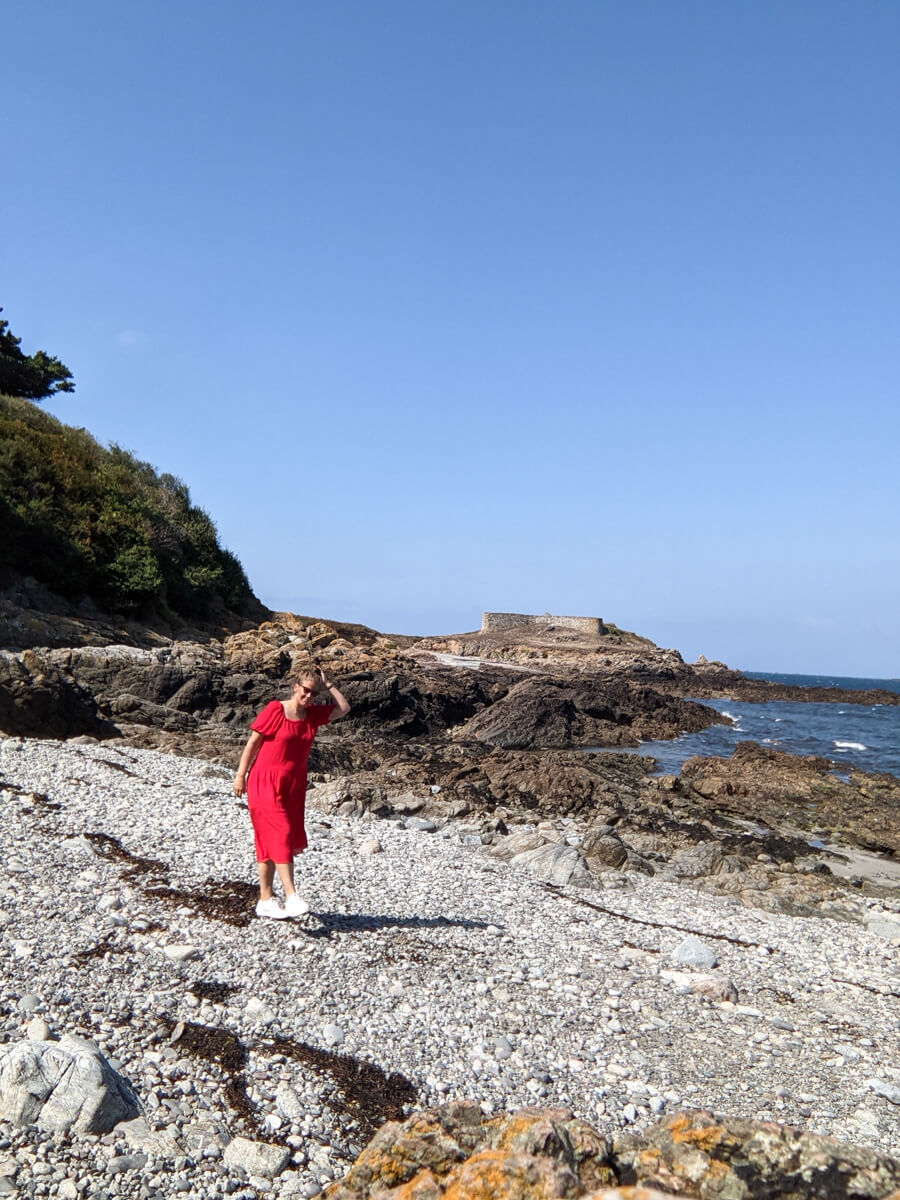
How to write a travel blog
Travel blogs examples to inspire your travel blog writing.
Once you have a few posts done and your fingertips are finding their way round that keyboard with rhythm start to think about the kind of writer you want to be. Think about how you want your travel blogging voice to develop, how you want readers to feel when they’re on your blog and what kind of topics you want to cover.
This is how you’ll start to gain a distinctive voice in the world of travel blogging – something that can be very difficult to do.
Travel blog examples
Here are a few travel bloggers, with travel blog writing examples, who really stand out to me for having been able to do this. When you’re writing for travel blogs, you can really make it your own, like these guys…
Becki Enright

Becki from bordersofadventure.com writes serious travel blog about sides of countries your average traveller wouldn’t get to see.
She’s even been on Sky News discussing tourism in North Korea and regularly produces the kind of political posts you won’t see on any other blog.
- Inside the ‘Den of Espionage’ – Getting Inside the former US Embassy in Tehran
- Visiting the West Bank in Palestine – Understanding the Conflict from Both Jewish and Arab Perspectives in Hebron
Brenna Holeman

Brenna from thisbatteredsuitcase.com creates beautifully written heartfelt stories about her life on the road.
She’s so open and powerful I enjoy reading her posts and know I can go to her site to be transported into her world.
Check out her travel blog for some major writing inspiration.
- The Last Time I Saw You: London Edition
- Being Happy with Being Content

For another distinctive voice in the travel blogging world check out Dylan’s blog at thetravelingeditor.com. At a risk of sounding like an imbecile, he uses a lot of ‘big words’. He’s an eloquent sesquipedalian . These posts are a good example of the tone and style of writing Dylan is known for.
- The palatal awakening of Mercatino del Gusto
- The thunderous convergence of Rotterdam Unlimited
How to write a unique travel blog
All three of these travel blogger examples are very different to what I aim to do on my blog. There may be some crossover in topics but the four of us have very different writing styles and I bet you could spot it if we wrote for each other.
When you’re writing a travel blog you should sound like you , be passionate about the things you’re passionate about, and relay in your own style. In that way you’ll stand out above what is now a very crowded and saturated market place.
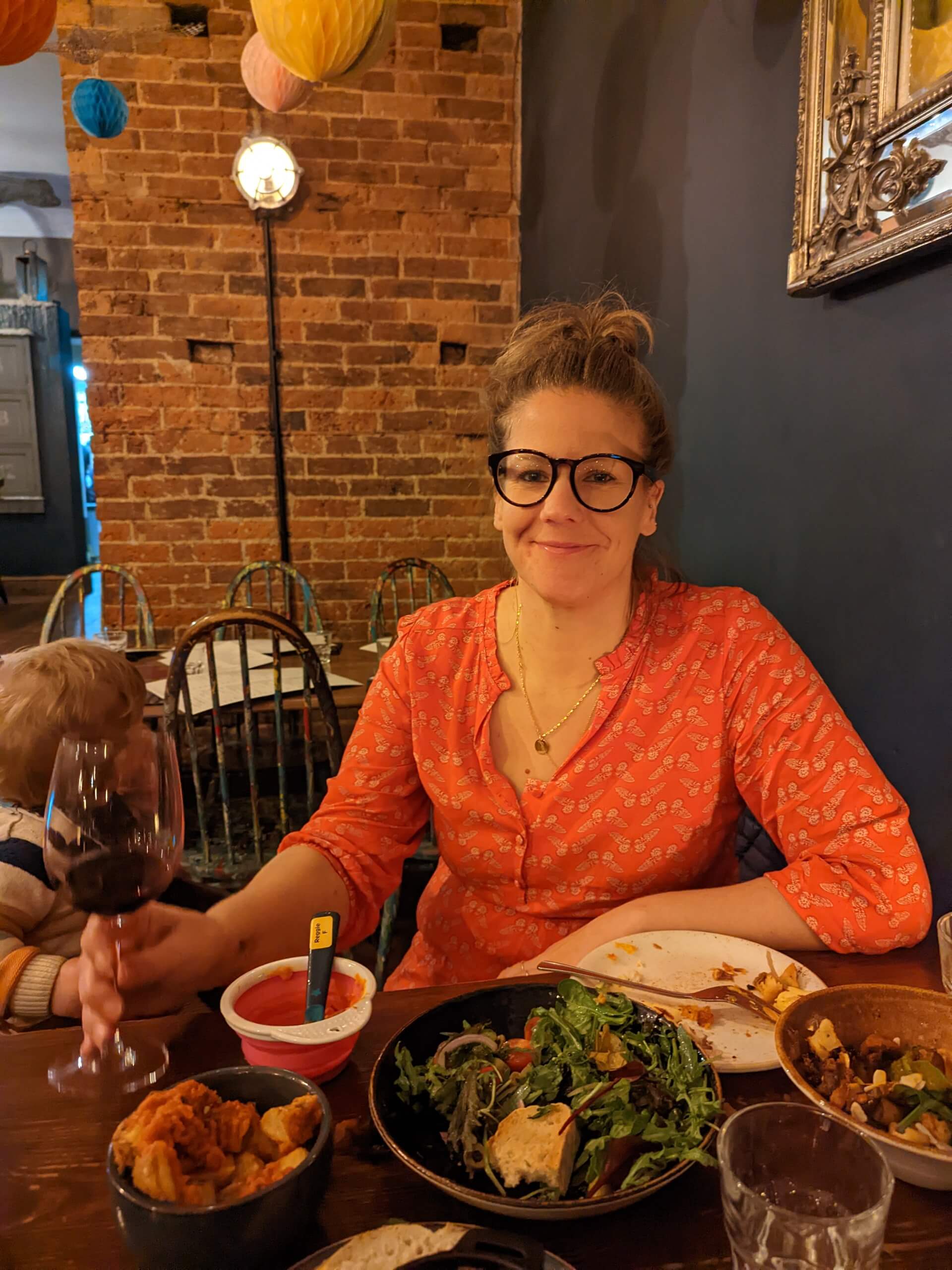
Writing my travel blog
As well as inspiring people to travel , like these guys, I also want to give practical advice on how to do it. My blog has advice on transport, money, where to stay, trip planning, itineraries and packing lists to make travelling as accessible as possible to my readers.
The best compliment people can give me about my blog is that it inspired them to travel, entertained them and made them laugh.
You don’t have to define and limit yourself straight off though when you’re writing for travel blogs. My advice would be to let your style, tone and topics instinctively evolve over time and with every post you write. You’ll soon come to find your natural writing flow and hopefully be distinctive too.
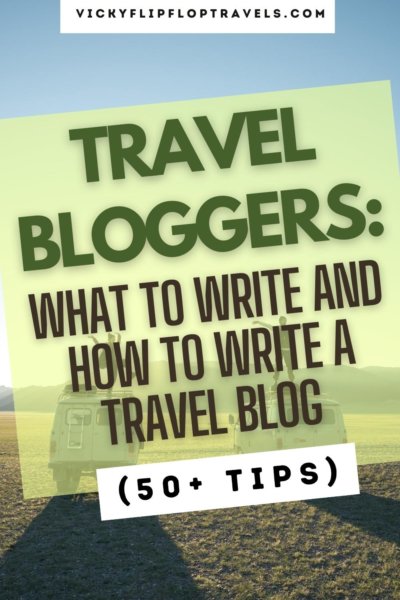
Always be yourself
When I went to the Traverse conference in Brighton everyone was excited to see Will Peach on his panel. His open, truthful and at times offensive writing on thegonzotraveller.com and the now defunct travelsexlife.com was definitely entertaining whether you loved it or hated it. When I met him he didn’t seem the same as his douchebag online persona and a few weeks later he came out with this article about his disillusion with the travel blogging industry. After that he only posted a few more blogs before he went on to focus on the brilliantly written, yet less offensive, willpeach.com.
Will’s angry voice was so distinct in the hyperbolically positive world of travel bloggers, but he wasn’t being himself. I’m glad he’s found his flow on his blog now – it’s still one of the most insightful out there.

You’ve got to be yourself in travel blogging.
That’s the number one rule about putting any creativity in the public space. This is scary. I used to worry about people reading my stuff and sometimes I look back at my past work and wonder what I was on. But, I did what was right at the time. If you start worrying what advertisers / other bloggers / your mum, thinks then you’ll lose what’s interesting about you in the first place.
I also think that when you start writing a travel blog it can be hard to portray who you really are. You may be so used to writing for school or work that writing with a blog style and flair doesn’t come easily. This can also be improved with practice. The more you read travel blogs, and write your travel blog, the more you can work on your travel blogging voice.
READ MORE: How Much Do Travel Bloggers Get Paid ?
How often should I blog?
Whenever you have something to say is always the best answer. I aim for at least twice a week but usually end up doing quite a bit more. Under promise and over deliver is my motto – even if it’s between me, myself and I.
The more you write the easier and better it will become. Worryingly I’ve seen a few resolution lists for this year where bloggers have said they want to ‘up their blogging output’, but I just think this is a dangerous goal. Set your aims too high and then travel blogging just becomes another pressure to live by, and for most people pressure is a fun killer, which ruins the whole point of travel blogging.

My writing style
I tend to write everything I want to and then fit it together. I just keep going until it’s all out and then go back and edit. Often I’ll write it on my phone when the inspiration hits then just use my laptop to edit as when I sit at my laptop I get to distracted.
I like to write into Google Sheets and then I’ll upload to WordPress and edit. It takes me AGES to write a blog post now. With all the research, writing, picture research, look at SEO and formatting, it’s at least a day.
Ideal length of a travel blog post
I like to write over 2000 words per article when I’m blogging about travel. Not all posts on my travel blog will be that long, but that’s the goal. In reading other travel blogs I think it’s hard to get your points and personality across in any less.
READ MORE: How to Make Your Travel Blogging Career Last for 10 Years+ !

How to write a travel blog post
Learning how to write a good travel blog can be quite formulaic in the way it’s set out. Of course the creativity comes when you decide which words to choose. Think about these ‘rules’ when it comes to writing your travel blog.
- Decide on a cool idea that you’re passionate to spend time writing.
- Write it, thinking in sections though. The best travel blog posts are divided by headers to make it easier for the reader.
- Think of a good headline that will draw the reader in and make them want to read more.
- Think in 500-1000 words. I know I said I do 2000, but I think that can be quite overwhelming if you’re still learning how to write travel blogs.
- If your idea is too big, then break it down into easier sections and write a few blog posts instead. You can always craft them back together again when you’ve finished, like my backpackers guide to Vietnam .
- Use photos to bring the post to life. If you know how to use Photoshop or Lightroom them brighten and edit for the best result. If not, don’t worry about it.
- Make sure you have a few H1s and H2s in there to help us readers, read the post.
- Proof read.
- Publish.
- Share! Social media is really important for travel bloggers. It might feel scary at first, to share your travel blog. I mean, I kept mine secret for at least a year. But the sooner you share the sooner you’ll get readers. And at the start your friends will help you to get word out there. Then they’ll get jealous of you travelling, but that’s future yous problem.
Once you’ve learned how to write a travel blog, you can really start to have fun with it, and learn to express yourself through your love of travel.
Travel blogging writing tips
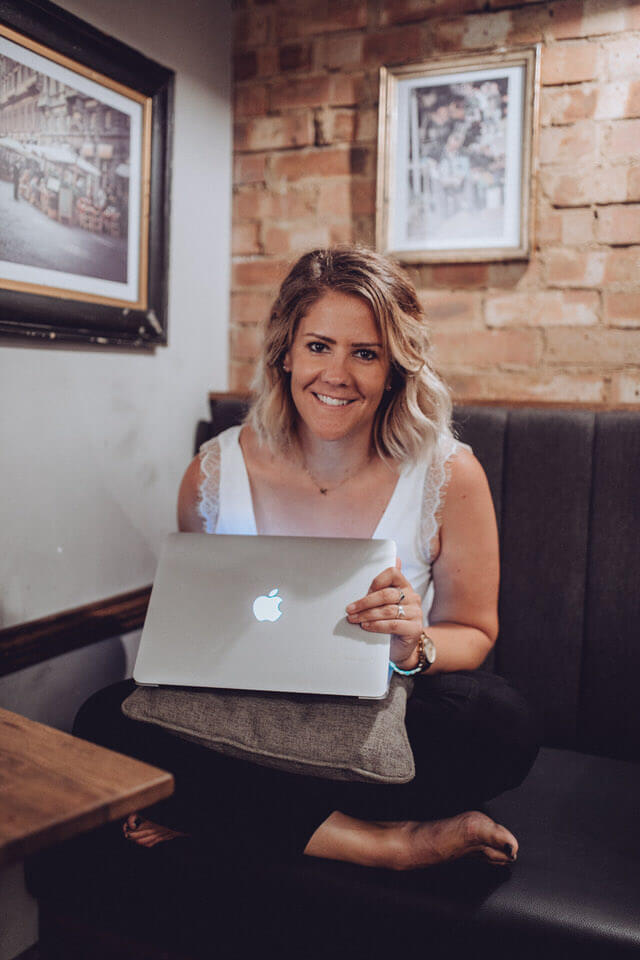
- Write whenever the feeling hits you – even if that’s in the ‘notes’ section of your phone.
- Keep practising – you don’t have to publish everything you write.
- Read other travel blogs analytically as well as for fun.
- Don’t put too much pressure on yourself.
- Write about what you want.
- Use Pinterest to see what’s popular and for inspirational titles
- Sign up to bloglovin ( follow me ) for a whole resource of inspiration. Make a note of the titles you actually click on.
- Keep a spreadsheet, or similar, of all the titles you want to write. Use when necessary.
- Keep a folder in your bookmarks of articles that have inspired you.
- Offer to write for others to create your own incentives.
On that last point I remember way back when and I pitched to Flight Centre. I got a commission for three articles. At the time it was this financial incentive and the idea that they thought I’d be able to do it that got me going. I was so proud to see my work up on their blog and it just inspired me to write more.
Once you feel confident enough, start to pitch to other websites and blogs and see if they’ll accept your ideas. Here are a few travel websites that will pay you to write for them .

More travel blog examples
If you’re looking for an example of a travel blog post, then check out a few of these, from me…
Travel blog example 1: ‘Things to Do’ listicle
Fun things to do in a destination. There’s a bit of snobbery around listicles in travel blogging, but personally I think they’re a really important and useful example of a travel blog.
You need to do them carefully though, and with heart and experience. If you want to write about traveling, listicle posts can be a good way to get started.
Check out my guide to fun things to do in Hobe Sound , or the best things to do in Levi, Finland . My guide to the best things to do in Lake Maggiore is pretty good too.

Travel blog example 2: a trip itinerary
Trip itineraries are so important, and often the backbone of any good travel blog. A tried and tested step by step trip itinerary is worth so much for people trying to plan a trip to the destinations you’re writing about.
Check out my two week itinerary for the Philippines , or my Norfolk road trip to get an idea of how to set these travel blog trip itineraries out.
Travel blog example 3: a real insight
Only you can experience a destination in the way you do – that’s why the real insights into destinations are one of the ways you can stand out from the travel blogging crowd. If you feel like you’ve had a really unique experience, or want to share exactly what you thought of a place, then these honest insights can make for a great travel blog.
Check out ‘ What is Cuba Really Like ‘, and ‘ What is Vietnam Like ‘ to see what I mean.

Travel blog example 4: personal stories
Ooo you can’t beat a personal story on a travel blog. The trouble is, you either need to really enjoy writing it, or not care if people read it or not. These personal stories are very hard to rank in Google, but they’re good to help your readers get to know you.
If you want to read some of my personal stories then check out these posts about when my boyfriend and I split up , the shock of going into lockdown, and my best moments in travel blogging.
Travel blog example 5: helpful guides
My helpful guides to what you can for for 9 hours in Qatar on a layover , how to avoid festival toilets and how to manage the overnight trains in Vietnam are some of the most popular posts on my travel blog.
If you’ve had a unique experience that will help other people who may go through the same then write about it!
Fill it with useful advice, personal anecdotes and interesting titbits to keep your readers intrigued, and Google showing it to them.
If you’re blogging about travel there’s no end to what you can write about!

How to blog about travel in a pandemic
Ok, so feeling inspired to blog about travel during a global pandemic has been difficult.
Us travel bloggers have had to rethink, reuse and try harder than ever to keep readers interested and ourselves inspired. It’s not been easy.
You can see my latest posts to see what I have managed to write a travel blog about – mainly paddleboarding in winter , my pledge to walk 1000 miles, and responsible travel tips , as well as my camping trip to the Outer Hebrides and the most fun days out in the UK .
Writing a travel blog

What you write about on your travel blog goes back to what you think a successful travel blog is . If you’re after views something like 50 reasons to travel in your 20s will do well, but if you want to flex your first hand experience a heartfelt think piece could be just your thing. I like to mix things up depending on my mood.
I really hope these travel blog writing tips have helped you see how to write a travel blog post. Writing a travel blog isn’t easy, and keeping it up is even harder. But once you settle in, and find your groove, you’ll start to enjoy it.
When it comes to your travel blog you could write about anything – so long as you have the passion for it – that’s what’s so good about being a travel blogger. Just a coffee you enjoyed somewhere unique, an interaction with someone or a whole guide to your take on a destination could make for an interesting article with the right enthusiasm, interest and execution.
How do you decide what to write about on your travel blog?
Let me know in the comments box below.
PIN HOW TO WRITE A TRAVEL BLOG TIPS FOR LATER
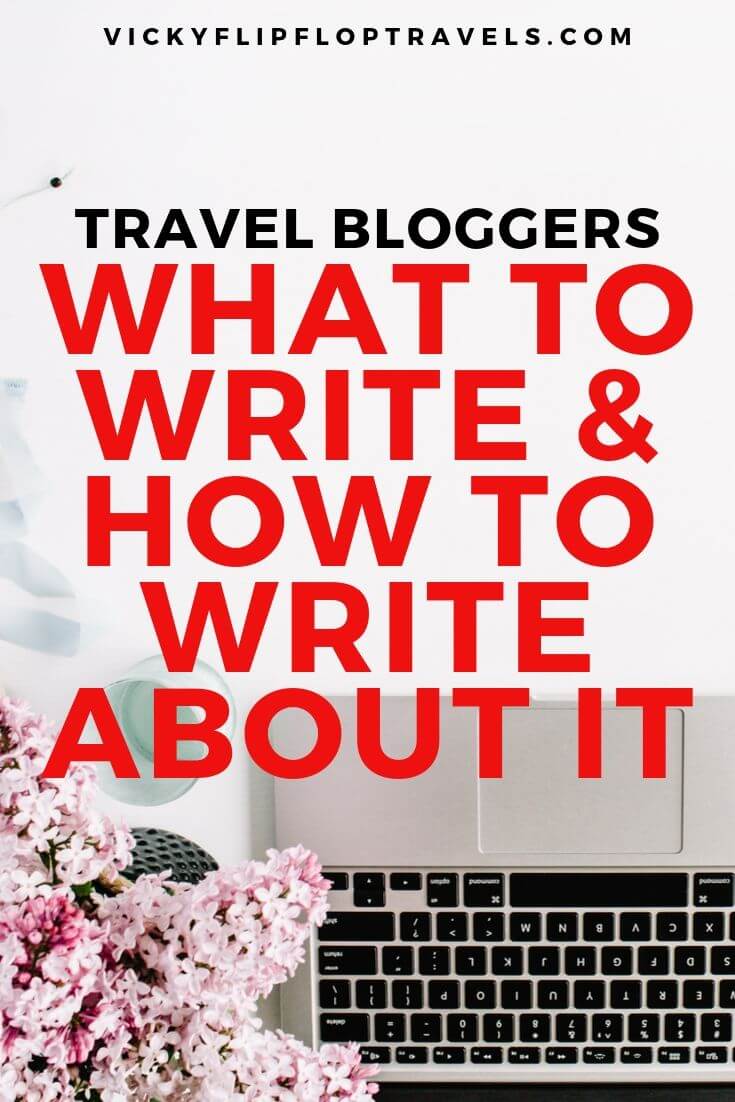
Related Posts:
- 6 Ways to Cure Crippling Blogger’s Block in 2024
- 66 Positive Affirmations for Writers, to Inspire…
- Am I Lonely, Travelling Solo?
- How to Win Travel Competitions & Get a Free Holiday!
- The Joy of ‘Blogging for Exposure’ vs What Magazines…
- 22 Top Tips for Pinterest, for Travel Bloggers
Hi, I'm Vicky! I wrote this. You can find me on all the social media @VickyFlipFlop. I love a bit of adventure, will try anything once, and have a strong passion for the local food and drink, whatever it may be. I'm here to help inspire you to travel to places a little out of your comfort zone, or at least to explore the usual destinations in a different way. Stay, have a look around, and if you have any questions – let me know below.
129 Comments
Such a lovely guide. Just what I needed. I am just starting my own travel blog. I have put it off for too long but the passion of travelling… I struggled with what to write and was already focusing on likes and audience. Your post has really inspired me and now I have about 6 topics I can write on(that’s after I figure out how to use WP properly). Thank you very much.
Thanks for this – some good advise and ideas for me. I have had my blog on hold for the past 6 months. I have quite a few posts written but everytime I go back to them the message I want to give changes as I am in a different mood! So everything remains in edit mode!! Hopefully after reading your posts I will get the confidence to post soon.
Yeah the passing of time and changing of self is a weird one. I’ve got posts on here that totally make me cringe because I don’t necessarily agree with what I was on about at the time. But, the thing is, it’s like a time capsule. It captures us and our thoughts in a moment in time which is exactly why we should publish right away. Our thoughts and opinions can have an expiry date!
Great post with some good ideas for me as I am thinking of getting on with the bog I have had in edit mode for the past 6 months! Just need that confidence to post, but find what I want to say about each idea changes depends on the mood I am in when I go back to it!! So nothing posted yet… soon, I hope.
Before it was difficult for us to get idea and find topics to write about. But what we did is to just find out what is popular and create something about it.
Yeah that totally makes sense! Good plan!
Good idea Tristan!
Points are really great and I really love them. As we all know that writing something regarding traveling without getting your audience bored is not so easy. These points would definitely help us in creating new and unique posts.
Hello, oh I’m happy I could help!
Interesting points you have here. Like it! 🙂
Thanks Julex!
This is good beginning
i didnt notice that you wrote this on your blog, what an inspirational advice for someone like me. Thank you for let me know another inspirational travel blogger. It encourages me to write more
Great news! Glad you’re enjoying my work and to hear that it’s helped. I try!
- Pingback: VickyFlipFlopTravels » Cool Festivals and Epic Holidays |Lessons I've Learned from the Top Travel Vloggers
First time I’ve seen this; have to say it’s a really great series. Best of luck with it.
Thanks for the mention too. Couldn’t have put it better myself!
Ah good, just read it again and I’m glad you didn’t find it offensive!
- Pingback: VickyFlipFlopTravels » Cool Festivals and Epic Holidays |Travel Blogger High: The Online School for Wannabe Travel Bloggers
A really long detailed insightful post which is such a help to those starting out. Liked the tips about compiling engaging titles – something I really struggle with particularly when Google insists on short titles! Many thanks for sharing your tips.
Holy Cow. I’m so unbelievably glad I found you. This is by far the best advice I have ever read. Thank you so much!!
Aw, thank you! That’s one of the nicest comments I’ve read! 🙂
Great article! I love Brenna’s blog and started writing one when in moved to London from Australia but rarely update it even though I have so many notes with adventures I have been on. I know people back home like reading what im doing but I am just lazy after I finish work.
Yeah, it can be pretty hard to get the motivation when you’ve been working all day. I know the feeling!
Another awesome post Vic! I couldn’t imagine starting a blog if I didn’t already have an idea of what to write but you handle the subject of getting started really well. Plus I remember those guest posts you referred to – you were our go to girl for great content 🙂
Thanks Jayne. Yeah nor me, but I think sometimes there’s so many options it can be hard to pick something. I remember for my A Level English coursework I could choose any two books I wanted to write about and it took me about three months to choose the book and then a week to write it. I imagine getting started can sometimes feel like that. You just need some guidelines to get down to it.
Ha, thanks!
Again a really helpful and interesting post! My travel blog is just a travel diary at the moment but I’m looking forward to expanding it and writing about more things! Your vietnam writing was how I found your blog too, and it inspired and helped me so much with booking my trip out there in November! Thanks Vicky! X
Yay, love it when people tell me that Vikki 🙂 And happy I’m helping you to think about your blog too. Thanks for reading!
Thank you so much for including me here! I’m loving all of this advice so much – this is such a great guide for both beginners and those of us who have been around for a few years. x
No worries Brenna – I love your blog!
I can’t remember where or when I read it but it went something like this: “when the student’s ready the teacher will appear” and here you are! In my quest to create a useful blog I’ve read a lot, in fact I’ve read so much I have no idea what’s right and what isn’t. I’ve had a yearning to be me “warts n all” to write in my voice but have been scared it would hold my blog back, here you are giving permission to be me. I hope one day in the future when I have an audience I can write a post that has such a profound effect as this post has for me. Thank you Vicky for writing this post.
Aw, thank you Rob. Your comment has made me really happy. I’m really enjoying helping people in Travel Blogger High, and getting all these comments. And yes, the best, most honest and most interesting person you can be is you, so go for it and have fun!
Some great tips – lots of food for thought. I’m usually in the too many ideas, not enough time camp, so I’m actually trying to focus on writing the right pieces this year, whether that’s the ones I really want to do or the ones I think will appeal to readers (both for usefulness and hits…!). Like you say, when you’re putting pressure on to hit targets, the fun goes out of it.
Some of the best ones I’ve done have been ones which really touched a nerve with me, and so with my readers too, or the ones which filled a niche as no-one else has written about them, like you mention. I slightly fell into those by accident, so the tricky bit for me is working out what other niches are waiting to be filled!
That’s a good idea to think about their usefulness. I find that I go with the one that inspires me most in that minute that I’m choosing which one to write. I guess it depends whether you want to be a bit more tactical about it, which I probably should be. Yeah, if you can find something you’re interested in that no one else has written about you’re definitely onto a winner!
I don’t really have much to add to this. I come from another niche (whoop whoop for lifestyle/food/fashion) but thoroughly enjoying the challenge of writing for the travel niche. I started out with a spreadsheet of over 100 titles for blog posts and it keeps growing. I have so much to write and there’s not enough time. Ahhhhh!!!!
I love blogging, writing, sharing and travelling – so for me, travel blogging is a real passion project.
Agree with the spreadsheet and reading blogs analytically as well as for pleasure.
Yeah that’s how I feel. Especially when you’re travelling full time as well. Every day you see new things and have new experiences you want to write about it’s really difficult to keep up! I love it too though – wouldn’t have it any other way 🙂
Leave a Reply Cancel reply
Your email address will not be published. Required fields are marked *
Sign me up for the newsletter!
VISIT THE BLOG

Travel BLOGGER + CONTENT CURATOR
12 lessons learned from my blogging journey .
- May 28, 2023
- By Christina Jane
I’m constantly reflecting on my blogging journey and how far I’ve come since starting my first blog in 2018 and being consistent with travel blogging in 2022. I always say that I love what I’m doing because, despite the lows and challenges I’ve encountered, I always want to improve and learn more.
Here are 12 lessons I’ve learned from my blogging journey with a dash of encouragement that I hope you can apply to yours.

Table of Contents
Putting Yourself Out There is Scary, but the Rewards Are Much Greater
Feeling scared to start is valid. I remember being scared to show my face in my videos and to do voiceovers because it felt like I was exposing myself.
Not even two months after “doing it scared”, a popular travel brand reached out to me to pay me to create content because they loved my style of creating reels.
Once I stopped being scared, I started to attract the opportunities I had dreamed of as a nano blogger.
I know so many people who don’t start creating content or writing blog posts because they are scared of being judged, failing, not being good enough, and having to share too much of themselves.
Do it scared anyway! I get anxious almost every time I have to post or publish a piece of content, whether a picture or a blog post.
The posts I worry the most about are usually the ones that perform the best.
Remember, you’ll never know what’s waiting for you on the other side if you don’t try.
You Will Be Ignored, Overlooked, and Dismissed, but Don’t Let That Discourage You
As I continued to grow and build my brand and platform(s), there were definitely times when I experienced feelings of being rejected by other people in my niche or like I was invisible.
When you’re just starting out, you may not get the exposure you are hoping for.
Keep showing up anyways.
One day you’ll look up, and some of your favorite creators and industry leaders within your niche will see you. It’s honestly such a small part of things.
Try not to focus too much on who is paying attention and who isn’t. It’s a distraction and so much wasted time worrying about who sees you.
Focus on the people already supporting you. Often they are the ones who will keep you going when you’re ready to give up.
View this post on Instagram A post shared by Christina Jane (@beingchristinajane)
Blogging is An Industry Where You Put in A Lot of Work for Very Little Reward Most of the Time
People see the features, the brand collaborations, and free hotel stays for me as a travel blogger but don’t understand what it takes and the work put in to get to this point.
For every sponsored experience I receive, there are probably 10-15 that came directly out of my pockets because I genuinely wanted to experience it and share my findings with my audience.
There’s a reason why many bloggers and creators say not to start for money or free stuff. It’s a very small part of this blogging thing and something that takes time to achieve.
The truth is with blogging, you may never get recognized for most things you do, and you have to be okay with that. Your love for what you share has to be greater than the “perks,” or else it won’t be sustainable.
Invest In Yourself, but Make Investments that Make Sense for Your Brand
There will come a point in your blogging journey where you have to open your wallet and financially invest in your craft to take your brand to the next level.
I was willing to invest $4,000 on my website design because this space is what I’ve cared about the most. After analyzing my personal circumstances and goals as a blogger, it made sense for me, but it may not make sense for you.
For example, buying editing software for $400 would not make sense for me as a creator whose main focus is blog writing, but it may make sense for a content creator whose primary focus is Youtube content.
Last year I invested in a blogging course to go back to the basics and learn the elements of blogging like SEO, terms and conditions, etc. that I never had exposure to.
Claim Your Title As A Blogger
I went through a stage in my blogging journey where it was so difficult to tell people that I was a blogger and a writer.
At that time, I felt like I was an imposter because I didn’t have the numbers.
I wasn’t sure if people would take me seriously or view my work as more of a hobby.
Last year I challenged myself to claim the title of being a blogger.
That meant when I introduced myself to people, having that title behind my name, reaching out to brands with that title, and just boldly claiming what I believed to be mine.
Once you begin to claim your title, your goals, and brand identity become stronger and clearer.
When you tell people who you are and what you do, they can now speak your name in rooms you may not even be in or connect you to specific opportunities.
Try Not to Compare Yourself to Others
This is a hard one because I feel like it comes with being a human. Whether or not you realize you’re doing it, at some point, we have all compared ourselves to someone else within our niche.
It’s not necessarily a bad thing, but it can be a slippery slope mentally.
When I started to create content and blog posts that aligned with more of what I wanted to do, I stopped comparing myself.
When you know your goals as a blogger, it becomes very easy to do so.
I find that sometimes we compare ourselves to people that we have no business comparing ourselves to. Your circumstances will always be different from the next person’s.
You may be feeling down because you don’t publish blogs as much as other bloggers, yet those bloggers blog full-time, and have team members that help them get blogs out faster.
Focus on identifying your goals and what’s reasonable for you right now .
Everything else will fall into place.
Connect With Others in Your Niche
Blogging can get very lonely, but it doesn’t have to be.
Be open to meeting new people and connecting with other bloggers in your niche. You shouldn’t view other bloggers as competition because what makes you different is you.
There isn’t any competition, in my opinion, when it comes to blogging because everyone has different perspectives and experiences they can contribute to the industry.
If you’ve already started blogging, you’ve probably noticed how much people don’t understand blogging as a whole.
As a travel blogger, having to beg people like my family members to take pictures and videos of me when I visit places who don’t want to can be discouraging.
Having people in your corner who understand the behind-the-scenes and are able to relate is priceless.
Give as much as you receive, build authentic relationships, vent when needed, and talk things out. There is power in numbers.
However, not everyone has the best intentions and is willing to connect.
While it’s great to connect with people, try to discern who you choose to be open to.
Allow the connections to happen naturally.
At the beginning of my blogging journey, I would get super excited when I saw someone’s work I admired and would get a bit disappointed when I found that the energy they were reciprocating was not the same in terms of being open to connecting.
This can again lead to feelings of rejection, but please keep in mind that there are so many people out there who you will be able to click with and lean on through the highs and lows of blogging.
Focus on those people.
Stay Consistent, but Make Consistency Work for You
If you ask any successful blogger for advice and/or tips on how they got to where they are today, I can guarantee that one of the responses will be to be consistent.
After seeing amazing results with my own blog this year as a result of being consistent, it really is the truth!
However, what I’ve learned the most is that consistency can look like anything. It just has to make sense for you and your lifestyle.
I once had someone tell me that I needed to post every day to grow on social media.
I remember feeling so helpless because I knew that could never be my reality with the life I live.
Now, consistency for me looks like posting on all platforms 1x/week, but ensuring that piece of content is something I am proud of.
Whether consistency for you looks like posting 3x/week or 1x/month, you know what is best for you and your audience. Trust yourself and make consistency sustainable for you.
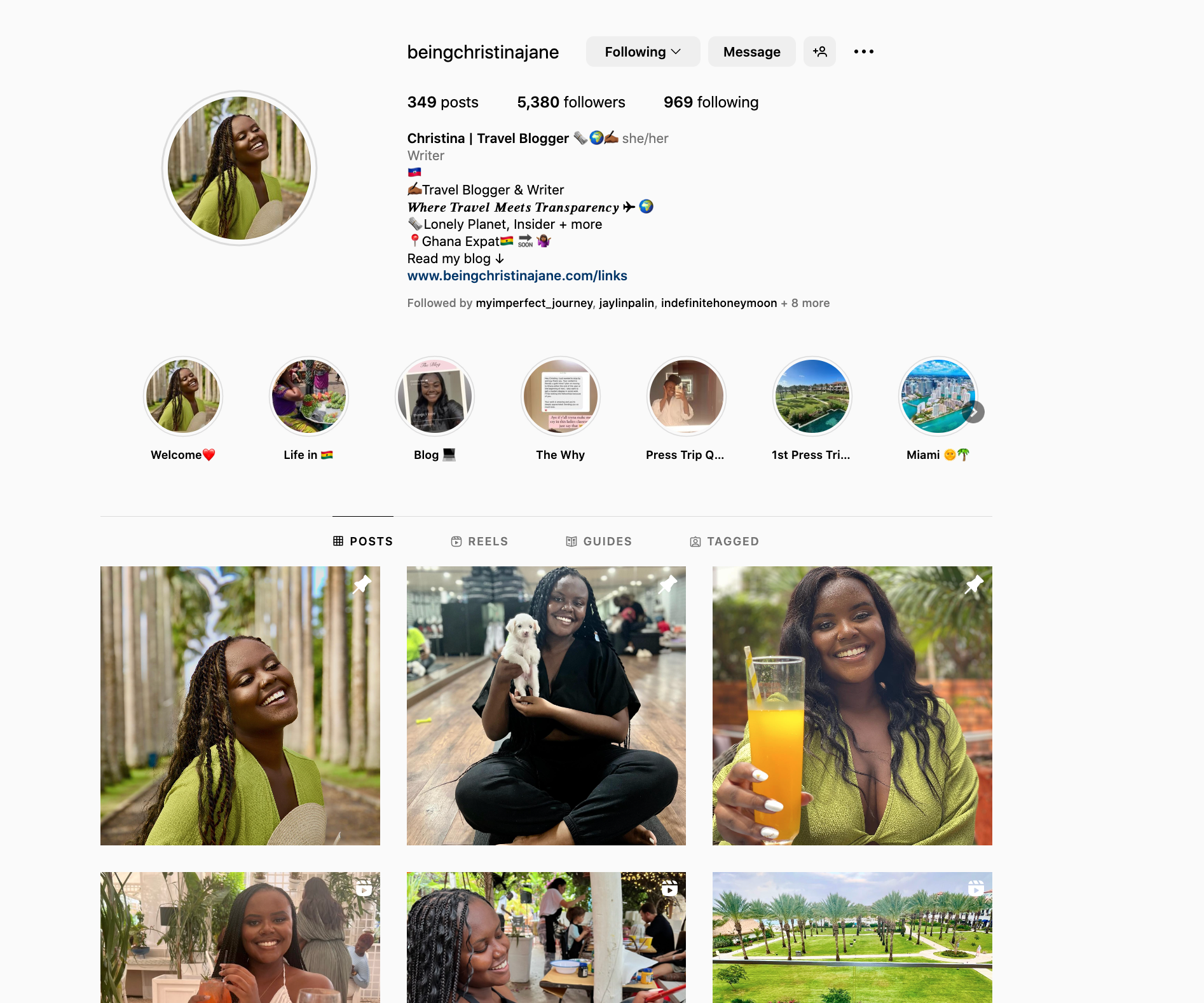
Detach Yourself from the Numbers Early On
These social media platforms do what they want to. You may get 10,000 views on one video and 600 on the next.
This is why I preach about focusing on the quality of your content and being happy with what you are producing instead of the numbers.
It can be extremely disappointing to deal with the inconsistency of social media algorithms and results.
The reality is that even when you spend hours editing one piece of content and it doesn’t perform well, you have to get up and do it over and over again.
Try not to focus too much on the numbers (although they matter to some extent) but on what you are trying to achieve as a blogger.
Take Yourself Seriously and Eventually, Others Will Too
This correlates with my point of claiming your title as a blogger/creator. As a beginner, it can be very intimidating and scary to claim a craft in an industry you are still trying to navigate.
Take it seriously. Introduce yourself as a blogger, keep posting and sharing your experiences, be able to explain what your brand is about and what you do, etc.
When you take yourself seriously, you teach people who you are, how to address you and how they can speak about you to others as it relates to your brand.
Don’t Be Afraid to Try New Things and Fail
Be bold, flexible, and adaptable. Don’t be afraid to stray away from your common content style and try something new.
You never know how it will perform or what your audience will be responsive to.
Don’t feel pressured to do what everyone is doing or to hop on a trend just because it has been successful for other creators.
On the other side of experimentation is either success or a lesson to take away for your brand.
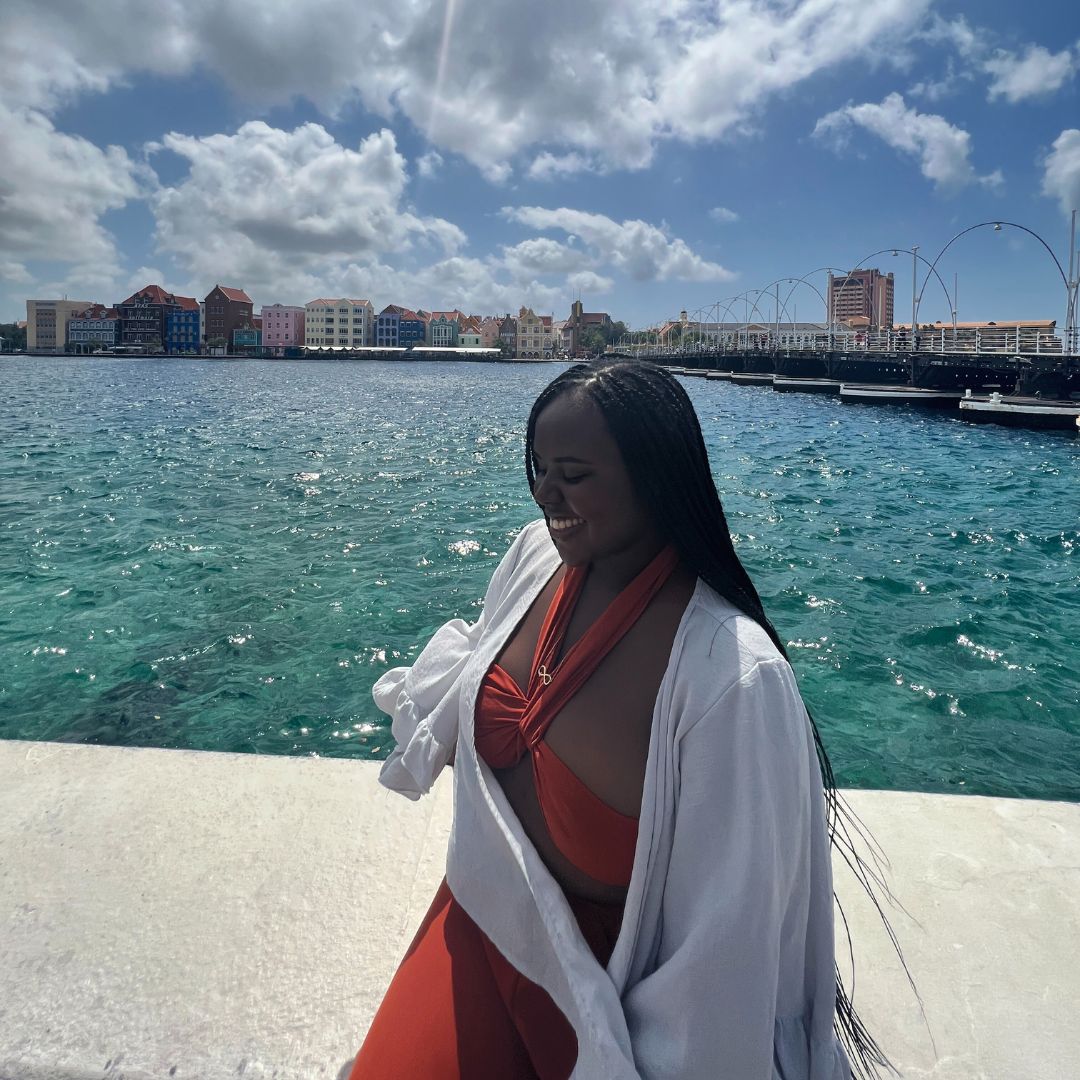
Know Your Goals
Finally, it is important to know your goals as a blogger so you can constantly keep in mind what you are aiming for.
When you know your goals, you can tailor your actions and strategies to align with them.
It will also help you avoid comparing yourself to others to an extent when you see other bloggers and creators reaching certain milestones.
Oftentimes we see other people achieving goals and feel some type of way about our own progress when in reality, those aren’t even our own goals.
Stay focused and know what you want.
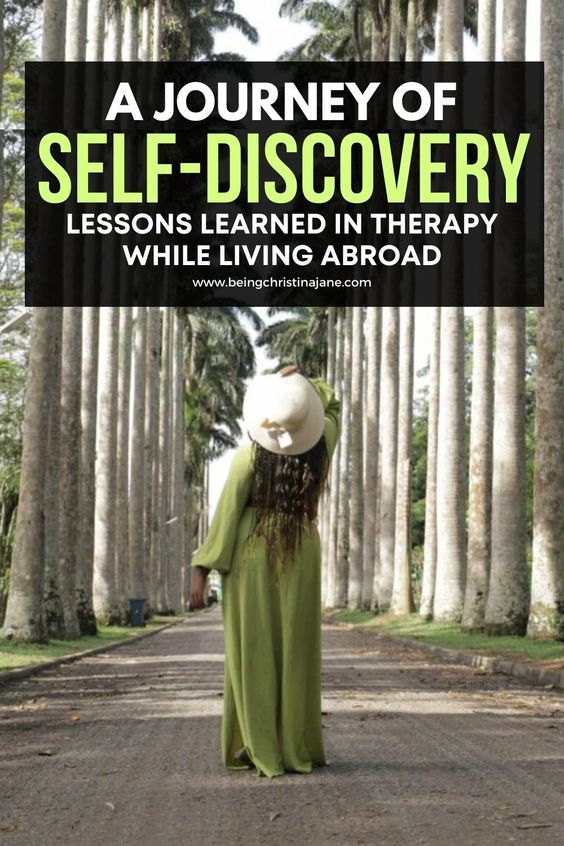
I sincerely wish you the best in continuing your blogger journey. Your perspective and opinions matter and deserve to be shared with the world.
Feel free to share a lesson you have learned on your own journey in the comments below or if there was any point mentioned in this point that resonated with you. ♥
14 Responses
Thank you Christina, this is very interesting and helpful to me. I just went live with a blog 2 weeks ago so am soaking in knowledge right now.
Hi Elizabeth! Glad to hear this was helpful! Blogging is such a rollercoaster, but is very rewarding. Feel free to send me some links to read if you’re up for it!
Hi Christina,
This is very insightful and I can relate to most of the points, as a new blogger. Thanks for sharing.
Hi Hlubi! Thank you so much for reading and being here!
Christina this was such an amazing and inspirational read! Thank you so much for being vulnerable and sharing your thoughts and feelings of your journey, SO RELATABLE!
Dommy made it to the blog! Yay lol, but it’s always a pleasure giving insight into my journey in hopes of helping others. Can’t wait to see where else you go with your brand. Loving the Europe content!
A fellow content creator recommended your page to me recently and it’s been nothing but valuable content. Thank you for sharing. And for your NEWSLETTER! It’s officially become a habit to check it even Sunday.
Aww that means so much to me, you have no idea! Glad to hear the things I’m providing are useful to other creators!
I’m so glad I came across your blog. It’s inspiring as I am about to launch my blog. I love what you say don’t be afraid to try new things and fail. Blogging was something I’ve been wanting to do for many years, but fear has been holding me back. I’m ready to step out of my comfort zone and be bold. Thank you so much for being transparent and sharing your experiences with traveling and blogging.
Aww Phildia, I can feel the tears coming! It can be so hard to take that first leap of faith but trust me when I say it is 100% worth it. I always say that I know when I really want to do something if I think about it everyday so yes be bold.
Thank you so much for being here and letting me know that my transparency is appreciated.
Come back and drop the link to your blog too, I want to read!
- Pingback: Getaway House Review: A Tiny Cabin Retreat in the Woods - Being Christina Jane
Thank you so much for sharing your wonderful insights! Love your takes on the landscape of blogging!
Hi Charles, thank you! It’s definitely been a journey but I’ve learned so much and it feels good to pass those lessons on!
- Pingback: The Journey Towards Authentic Blogging
Leave a Reply Cancel reply
Your email address will not be published. Required fields are marked *
Save my name, email, and website in this browser for the next time I comment.

About The Blogger
I’m Christina, a travel blogger and content creator from Fort Myers, Florida.
Being Christina Jane is my way of inviting you to join me on my travel ventures by sharing the knowledge gained from my adventures and experiences— both good and bad.
This travel blog is filled with helpful travel tips, information, and is a recollection of the lessons I’ve learned and experiences I’ve had while traveling.
My goal is to curate a space that interconnects my love for travel and transparency and I hope you will join me on that journey.
AS SEEN IN:

Connect With Me!

Some posts on this website may contain affiliate links. Meaning if you buy something through one of these links, I may earn a small commission. This is at no extra cost to you and may even save you money!.
Anything I ever recommend is because I genuinely enjoyed that product/service. I promise to always keep it real with you!
Also, opinions and posts expressed on this blog are of my own accord.
Learn How to Become A Virtual Assistant and Make Money from Anywhere in the World Like Me!

More Blog Posts to Check Out:

22 Things to do Near Atlanta Airport

21 Restaurants to Have Breakfast in Cape Coral
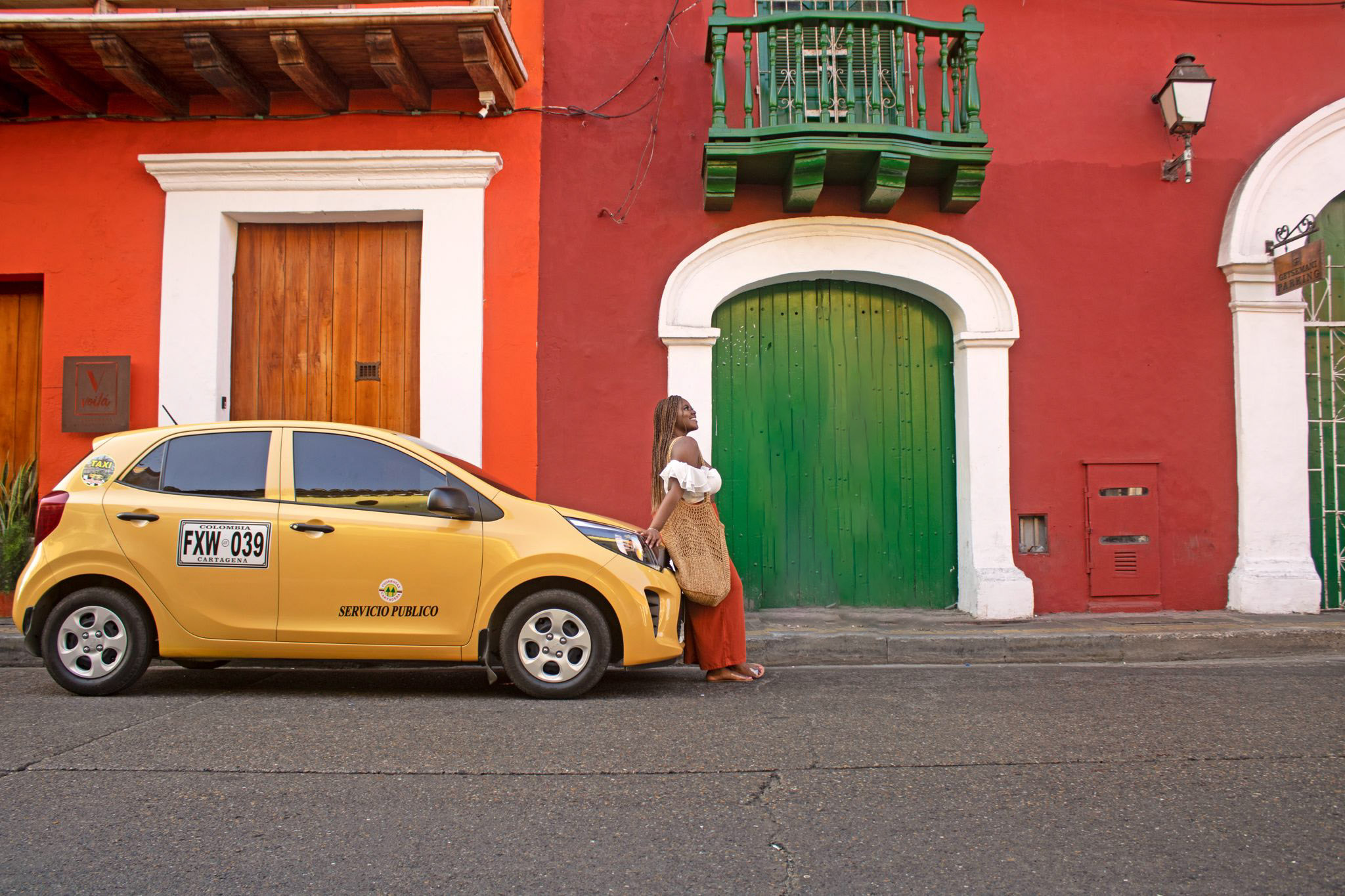
Taxis in Cartagena: Getting Around Using Taxi Cabs

A Day Spent in San Basilio de Palenque: The First Free African Town in the Americas
Subscribe to my weekly newsletter.
Receive a weekly list of travel scholarships, travel writing opportunities, travel contests, giveaways, and more!
Related Posts
In the United States, Atlanta is a major transportation hub, earning itself the title of having the busiest airport in the world, Hartsfield-Jackson Atlanta International
Cape Coral is known for its laid-back atmosphere, which means that it can sometimes be challenging to know where to go for specific activities and
Taxis in Cartagena are one of the most common transportation methods to use in the city. These bright yellow taxi cabs are hard to miss.
San Basilio de Palenque is the first free African town in the Americas. Founded by escaped enslaved people in the 16th century, San Basilio de
FOLLOW ME @BEINGCHRISTINAJANE

PRIVACY POLICY
Terms and conditions.

© 2022 Christina Jane, All Rights Reserved. Website Designed by Pinkney Creative, LLC

5 Tips on How to Write About Your Journey

Everyone wants to have a written piece about their life. It’s a priceless compilation of all your memories, personal relationships, challenges, victories, and lessons.
Perhaps you envision yourself becoming a best-selling author with a classic autobiography. Maybe you just want to finally start recording the everyday events along your journey. Whichever the case, it’s best to know how to execute the results you want, especially when you’re feeling stumped, unmotivated, confused, or discouraged during the process.
Want to know how to turn your past into a gripping story that you and everyone else would love to read? Take a look at these 5 tips on how to write about your journeys abroad.
1. Think About Your Emotions and Senses
When you’re first brainstorming ideas for the stories you want to write, acknowledge the core emotions you associate with your life as a whole. Be honest with how you feel, and don’t be afraid to bare your soul to find the authentic emotions, even if some are unfavorable. Then, regard the senses you experienced—vision, hearing, taste, smell, touch—to remember the moments that are so clear in your mind.
Do you have a keen ability to smell more than others and associate moments in time with scents? Are you a strong visual person who can recall the past from a photographic memory? Your lack of senses, such as a hearing impaired disability, could also attribute to how you portray your memories. Don’t forget that your emotions and senses strongly develop your own unique perspective, and depicting both with rawness and honesty generates a better connection with your readers.
I found this great podcast by The Expat Money Show – 033: Tim Leffel – Expat Entrepreneur Shares What He Has Learned In His 3 Decades As A Professional Travel Writer
2 . Identify Major Life Moments
Once you’ve recognized the emotions related to your life and the senses you use to remember those events, it’s time to highlight the main turning points in your journey. What were your most difficult challenges, and how did you overcome them? What were your happiest memories? What moments in your life best define you? Aside from recording your journey, the goal should also be to inspire your audience with your development and transformation process.
At this stage, forget issues with grammar, punctuation, or not-so-fond memories that are painful or otherwise shed a disgraceful light on your character. You only want to clarify the exact details of your memories. Don’t try to please people who want to be seen a certain way—even if that’s yourself—because accuracy will be the greatest component in expressing your message.
3. Write it All Down
You have to begin writing at some point, even if it starts out completely disorganized. Don’t worry about making it all appear perfect at first. In the beginning, it doesn’t necessarily matter how you arrange your writing, so long as it’s recorded on an effective method for safely storing your passion-filled words.
Use scratch paper, your favorite journal, an old notebook, your mobile device, or your most trusted computer to record your memories. Just make sure to include every detail of what you intend on having in your final copy. As you’re writing, think about the process you used for brainstorming. To make an impactful message, be sure to incorporate descriptive language, a consistent voice, and as much accuracy with settings and relationships as possible. Ideally, your writing should evoke the same powerful emotions and sensual feelings as your memory does for you.
4. Find a Theme
Memoirs are excellent mediums for new writers because they encapsulate an entire life period in a condensed way to convey a particular message. At this point, you should have at least a first draft of the stories you want finalized. Now, the editing process begins. In addition to reviewing basic spelling, grammar, and relative content, you also have to consider how you imagine everything tying together cohesively.
Upon review of all your individual stories, there should at least be one standout theme that aligns with your message. The theme to your memories could be as simple as a destination, such as the magical adventures you encountered on one of the Azores Islands . Alternatively, your theme could showcase the special moments you’ve had while retiring abroad . There is no single right or wrong theme to have for your memoir; instead, it should be specific to the individual memories and messages you wish to share from your journey.
Experience the Insider community that takes your international lifestyle to the next level. Download your FREE guide
"18 Steps to Implementing Your Plan B" instantly!
5. read other memoirs for inspiration.
If you want your writing to have any level of mainstream success, look to those who have already accomplished what you aspire to achieve. Examine their writing style, thematic elements, voice, and overall appearance of the physical or digital copy. As you notice what makes their writing so unique and poignant, try to inspire your own writing with similar elements.
Also consider their final product so that you have an idea of what it looks like once everything is complete. Out of your favorite authors who have comparable writing styles to you, what type of experts did they choose for publishing and editing? This way, you can decide whether or not you want assistance from an essay writing service list or a more established publishing firm. Keep in mind that whatever makes other popular authors successful will be useful for your writing as well.
Remember, your journey will always be a one-of-a-kind experience. Since no two stories are alike, you can be sure that using these methods will help you create an exceptional written body of work. Brainstorming with an honest lens is essential before you begin the writing process, using your editing eye can help you craft written memories that are perfect for your message, and it doesn’t hurt to look at others’ work for support and assistance. No matter what your memoir goal is, now you have the five best tips that allow you to expertly write about your journeys abroad.
I hope you enjoyed: 5 Tips on How to Write About Your Journey. Here are some additional articles that you will love!
Book Bundle
Starting a Writing Career While Living Abroad

4 Tips on How to Freelance While Traveling the World

Like Our Articles?
Then make sure to check out our Bookstore... we have titles packed full of premium offshore intel. Instant Download - Print off for your private library before the government demands we take these down!

UK Suspends Tier 1 Visa
Crossing the Andes on Horseback (Part 1): Discovering Vineyards in Mendoza, Argentina
Finding Work in Sweden
How to Become a Mexican Resident
Why Investment Advisors Hate Bitcoin
International Money Transfer Services: Your Gateway to Financial Freedom Abroad
- WordPress Hosting
- Domain Names
- Website Builder
- Create a Blog
- Professional Email
- Website Design Services
- Course Maker
- Enterprise Solutions
- WordPress Themes
- WordPress Plugins
- WordPress Patterns
- Google Apps
- WordPress.com Support
- WordPress News
- Website Building Tips
- Business Name Generator
- Discover New Posts
- Popular Tags
- Blog Search
- Daily Webinars
- Learn WordPress
- Plans & Pricing
Blog with the best.
More bloggers and independent creators choose WordPress than any other blogging tool. Tap into intuitive, flexible tools that put writers, bloggers, and creators first.
Simple, meet flexible.
Whatever you’re publishing. Whoever your audience is. WordPress.com makes it simple to get started. And easy to expand your site as your audience grows.

Customize your blog’s look and feel in a couple of clicks with beautifully designed themes. Bring your writing to life with magical drag-and-drop layouts. Or put your fingerprint on every font, color, and element on the page.
From simple and clean to glossy magazine – whatever your publishing style, the intuitive block editor adapts to you. Drag, drop, and easily swap out your menu, punch in a pull quote, or make your post pop with a beautiful gallery. Just like that.
From video to audio, stories to GIFs, bring it all together—right from where you write. And with plenty of storage for every type of media, your content’s secure, easy to reuse anywhere on your blog, and owned by you alone.

You do you.
You’ve got more on your plate than running a blog. WordPress.com meets you where you are.

The Jetpack mobile app for iOS and Android puts total control of your blog a tap and swipe away. Wherever you are at the time.
With post-scheduling, you can catch your readers at the best time for them. And for you. Write up a post, set your publish date, and then leave it to your blog to hit publish.
Skim your blog stats with an at-a-glance dashboard. Or dig into the details of exactly what’s resonating with your readers with charts, graphs, and deep-dive data, powered by Jetpack.
See and be seen.
You made it. Now it’s time to get it in front of people. With baked in SEO tools, a bustling community, one-click social links, and a bunch of easy ways to get paid, you’re all set.
Get found faster thanks to built-in search engine optimization tools. Clean URLs, automatic sitemaps, and custom titles and descriptions help put your blog at the top of the stack in search results.
Find your audience
Say hello to a huge community of bloggers, creators, and avid readers, every time you publish. WordPress.com’s built-in Reader means millions of people can easily find, follow, and share your blog.
Take it to social
Put the word out on social media with no extra work. Set up automatic social updates once. Then leave it to WordPress.com to update Facebook, Tumblr, and LinkedIn every time you hit publish.
Get paid for what you made
Let your audience support your hard work with built-in monetization tools. From shipping out merch to selling downloadable content, taking donations to offering subscriptions and memberships. Everything you need to collect payments is baked right in.
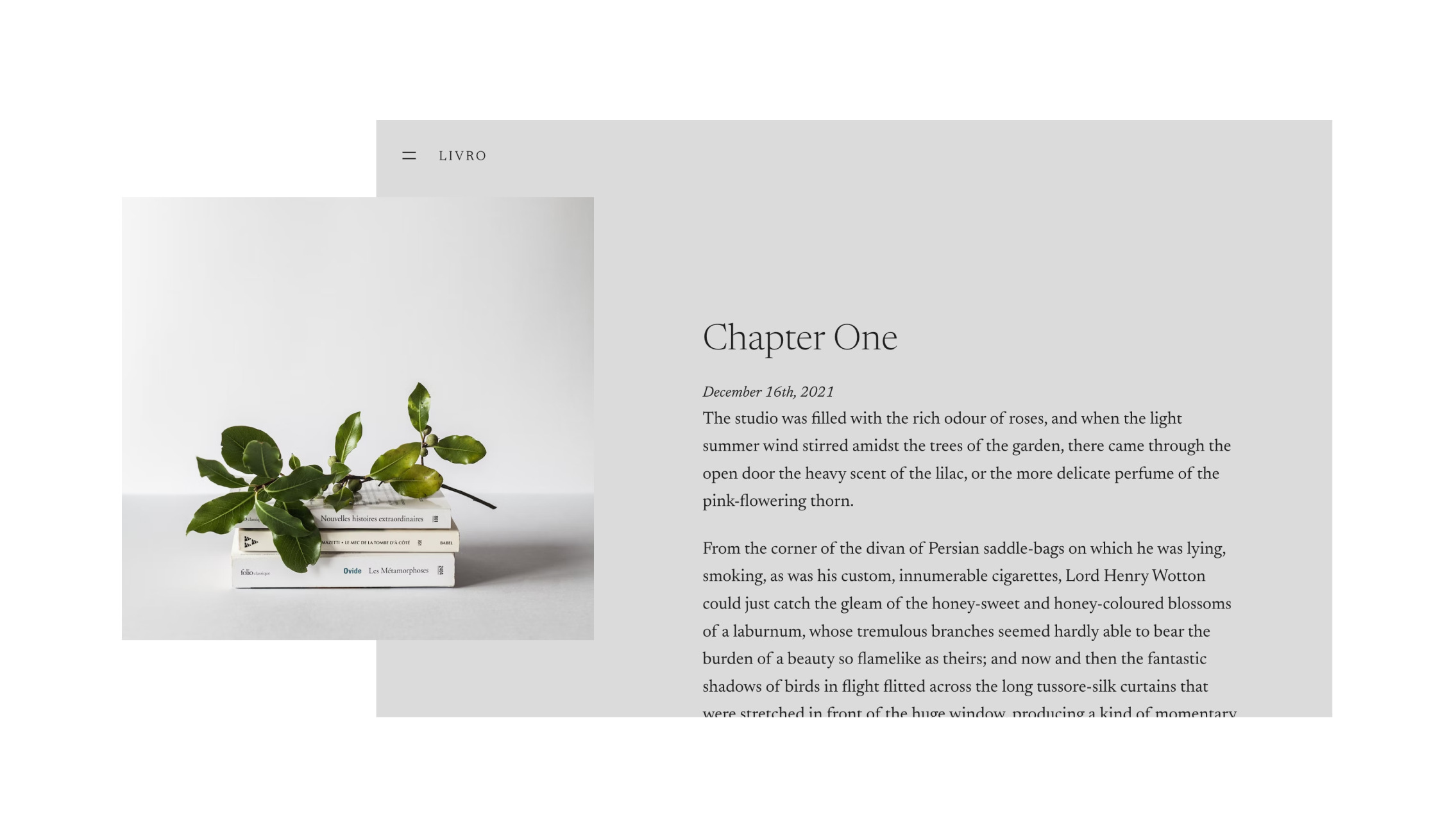
People love WordPress.com.
Over the years, I’ve acquired a gratifying number of readers and followers, with more arriving each day, and I owe much of that audience to the tools and opportunities that WordPress.com provides.
WordPress.com has allowed me to present my content in an attractive way. It’s given me a platform to reach thousands of people. It’s made people notice me and what I write… With my WordPress site, I feel like a professional.
My entire life has been invested in the written word, printing and publishing. WordPress.com is the best resource I have ever used.
You’re in control.
With WordPress.com, your content belongs to you alone. Count on us to keep your site strong, safe, and lightning fast, so you’ll never lose a site visitor.
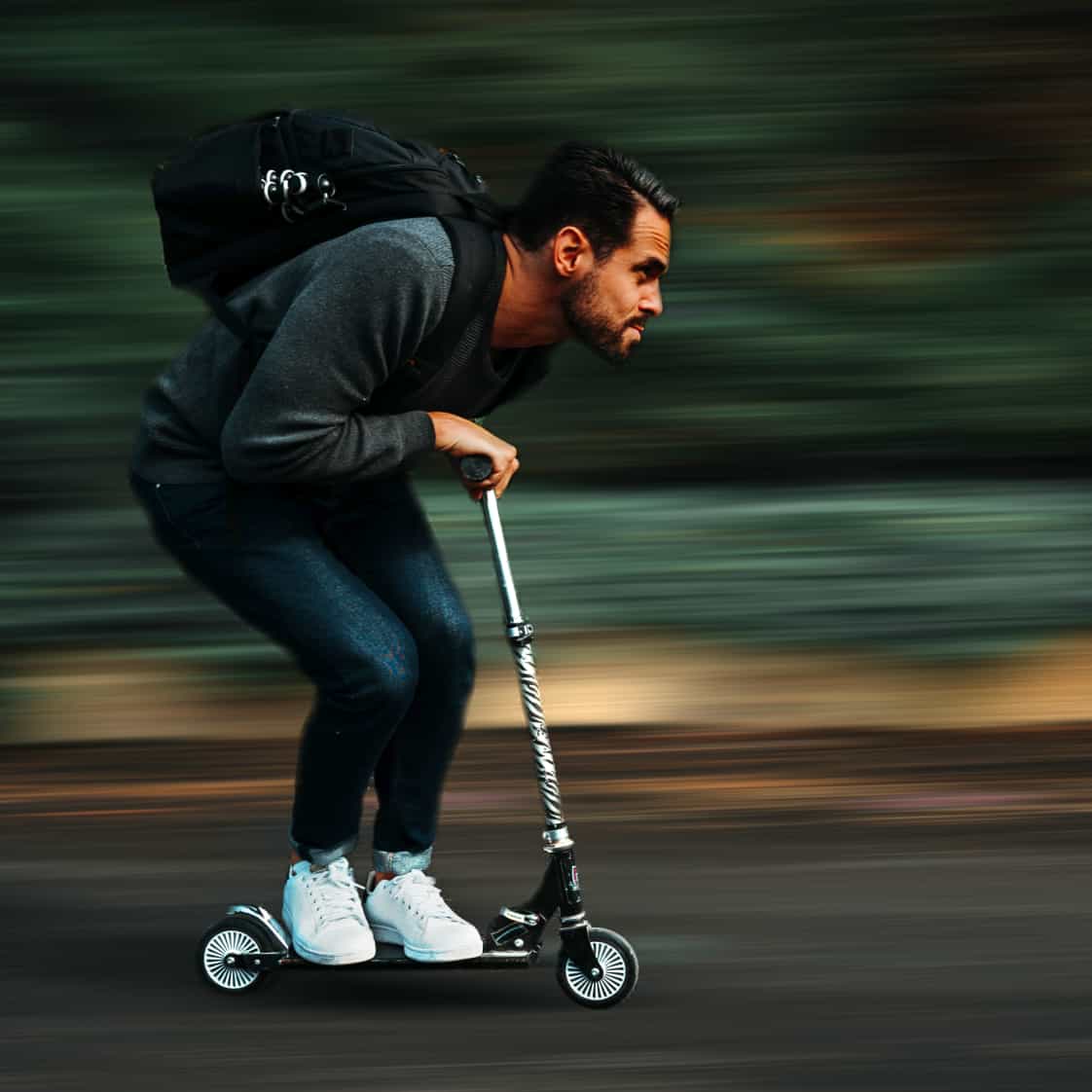
Blogs should belong to creators, not platforms. With WordPress.com, every word, every photo, and every thought you share belongs to you. And only you. That means you can easily export your entire blog and take it anywhere, at any time.
Your blog’s in safe hands. With a dedicated security team, firewalls, encryption, brute force, and DDoS protection. So when you blog with WordPress.com, security’s all in place. All by default.
WordPress.com focuses on doing only one thing really well: hosting blazing-fast WordPress sites, all over the world. So you’ll never lose a follower to a slow site or risk your blog going down with a sudden traffic spike.
Everything you need in one place.
Your WordPress.com site comes with all the most popular blogging tools—and then some.
Stats & Insights
Jetpack stats.
Monitor your site traffic and engagement from the moment you hit publish.
Google Analytics
Access in-depth data on how and why people come to your site without writing a single line of code.
Design & Editing Tools
Beautiful themes.
Kickstart your site by selecting from hundreds of pre-made, professionally-designed, customizable templates .
Block Editor
Use intuitive drag-and-drop tools to easily arrange, rearrange, and organize your content and media.
Advanced Design Tools
Customize your blog’s design with extended color schemes, typography, borders, and control over website CSS.
Pre-Built Block Patterns
Create great-looking layouts simply by inserting elegant pre-built block patterns into your pages and posts.
Upload Any Type of Media
Create designer-worthy photo galleries, embed audio, video, documents, and more—with storage space to spare.
Get found faster with powerful built-in SEO tools , and access to premium plugins including Yoast and Rank Math.
Social Media Tools
Automatically send new posts to Facebook, Tumblr, and LinkedIn and create shortlinks, social icons, and open graph tags.
Easily insert a contact, appointment, event registration, or feedback form to your site.
WordPress.com Newsletter
Automatically send your new posts out as an email newsletter.
Connect with other likeminded bloggers —who might just be your next biggest fans, through our community hub.
Custom Domain Name
Get a personalized online address that’s easy to remember and easy to share—enjoy your first year free when you choose a paid annual plan.
Monetization Tools
Collect payments.
Accept payments for just about anything—from goods and services to memberships and donations.
Earn ad revenue by connecting your site with the biggest ad publishers, including Google AdSense, and more.
Paid Content Block
Create additional, premium content exclusive to your paying subscribers.
Paid Newsletters
Email premium content to paying subscribers.
Site Management
Post by email.
Publish blog posts on-the-go with the quick send of an email.
Post Scheduling
Schedule your posts in advance.
Spam Protection with Akismet
Prevent unwanted comments to ensure that your site remains professional and trustworthy.
Jetpack Backups and Restores
Easily restore or download a backup of your site from a specific moment in time.
Related Posts
Provide automated content recommendations to visitors based on what they’ve already read.
Jetpack Search
Deliver high quality, relevant search results to your most engaged visitors.
You asked, we answered.
You can always get started blogging for free with the WordPress.com free plan, which includes our best-in-class hosting. Our various paid plans unlock additional features perfect for personal use, freelancers, small businesses, and online stores.
Find the right plan for your blogging needs.
Your free website includes a subdomain: sitename.wordpress.com
You can register a new custom domain name or transfer an existing one to your free site, but you’ll need a paid WordPress.com plan to use it as your site’s main address.
Every paid WordPress.com plan comes with a free domain for one year when paid annually.
There are a lot of ways to earn money with your blog. You can earn ad revenue, share affiliate links, sell digital goods and services, accept donations and tips, create premium content accessible only to paid subscribers, and more.
Learn more about how WordPress.com helps you monetize your blog .
On WordPress.com we use “website” and “blog” as interchangeable terms. Any site you create on WordPress.com can be formatted as a static page or a blog. Some websites dedicate a separate section to work as a blog.
Yes! WordPress.com makes it quick and easy to import your content from other blogging or website platforms including Squarespace, Wix, Blogger, and more. You can also import your content from a self-hosted WordPress site.
Find out how to import your site’s content .
Yes, we have a custom web design service called Built By WordPress.com . You tell us about the site you envision, and we’ll work closely with you to design and build your site. The end result will be fully customized for you.
Check out our learning hub with a variety of courses and webinars, articles, and support guides for tips on getting started with your blogging journey.
Join the millions of creators publishing with WordPress.com.
Build your blog—and your audience—with the same tool that powers almost half the web. Built on lightning-fast, seriously secure, hassle-free hosting. That’s WordPress.com.
WordPress.com
- WordPress Hosting
- Domain Names
- Website Builder
- Create a Blog
- Professional Email
- P2: WordPress for Teams
- Website Design Services
- Enterprise Solutions
- WordPress Themes
- WordPress Plugins
- WordPress Patterns
- Google Apps
- WordPress.com Support
- WordPress Forums
- WordPress News
- Website Building Tips
- Business Name Generator
- Logo Maker
- Discover New Posts
- Popular Tags
- Blog Search
- Daily Webinars
- Learn WordPress
- Developer Resources
- Terms of Service
- Privacy Policy
- Do Not Sell or Share My Personal Information
- Privacy Notice for California Users
Mobile Apps
- Download on the App Store
- Get it on Google Play
Social Media
- WordPress.com on Facebook
- WordPress.com on X (Twitter)
- WordPress.com on Instagram
- WordPress.com on YouTube

- Request new password
- Create a new account
Password Reset - We have updated our systems. If you are an exisitng user and have not reset your password since Dec 19, please reset your password now or create an account to access restricted resources.
Alternatively, contact us on:
- US (and territories)please call 800-818-7243
- Europe (and territories) please call +44(0)207 324 8500
Teaching With Light: Ten Lessons for Finding Wisdom, Balance, and Inspiration
Student resources, my writing journey, this is my story. my purpose in sharing it with you is to encourage you to think of yourself as a writer so you can share your ideas with others. teachers often ask me why i decided to write and publish books. as i reflect back i see that each book has its own story and reason for emerging. i never thought of myself as a writer and never imagined it as a goal. in fact, i wasn’t even sure i liked writing and sharing my ideas with other people..
My journey as a writer began when I was ten years old. My family decided to take a trip to Florida to visit my grandparents and it would take me out of school for two weeks. One week was school vacation and the other week was required school time. I was in the 4 th grade and my teacher’s name was Mrs. Orr. I can still see her standing in the front of the room saying, Carol, instead of giving you work to complete, I am going to have you keep a diary of your trip. Write each day what you did and when you get back it will be printed in our class newsletter for all the students to read.
Well, you can imagine my reaction. I would rather do the homework than write the events of my trip for my classmates. Several years ago when cleaning out my mother’s home, I found that copy of the class newspaper. At the top of the article I saw my name and the events of my trip. It brought back memories of how I struggled with what to say, and it also brought back a sense of pride to see my written words.
When I became a teacher I did the typical writing of lesson plans, units, and notes to parents. Teachers are always writing. We mostly write for our students, their parents, or for administrative reports. We don’t often have the opportunity to write our perspective. Our writing purpose is usually for others. My first real writing opportunity came when a state grant was offered for teachers to create a project that would serve students or teachers. In education we don’t often get funding to create something we think is important, so I jumped at the chance to propose an idea. I had just finished hosting a student teacher and had lots of notes about what I had done with her. I was thinking, “What’s missing?” and the idea came to me to write a guide for cooperating teachers who are hosting student teachers.
Cooperating teachers welcome beginners into their classrooms, but often don’t have the protocols or skills to observe and provide feedback to them. I decided to write a handbook and I titled it, “So You’re Going to Be a Cooperating Teacher: A Guide for Classroom Teachers.” The purpose of the guide was to create a common language for cooperating teachers in our school district so they would know how to prepare and support a student teacher. The proposal was funded. I wrote it, copied it, and distributed it widely. Teachers responded positively and this was the beginning of my journey as a writer of education books. It also shifted my love of teaching students, to a love of supporting new teachers.
I shared one of my copies with an editor from Allyn & Bacon; Simon & Schuster (Now Pearson Education) and it led to the publication of my very first book, Techniques and Strategies for Coaching Student Teachers. As I look back I remember writing this book quickly and easily. I had the original copied cooperating teacher guide as a model and I wanted this to be a practical and useful tool for classroom teachers. It just flowed! I felt a sense of urgency to get the message to them and I was inspired.
About the same time, I decided to apply to a doctoral program and focus my studies on teacher development. This led to my work in higher education in the practicum office at a city university where my new book would be used! This was so exciting. Cooperating teachers didn’t usually have a book so I felt we were offering them something tangible beyond the college handbook. I knew this would benefit the student teachers I placed with them.
During my time at the university I was invited to write a 2 nd edition for Techniques and Strategies for Coaching Student Teachers (Pearson) and a new book to be its companion, Strategies for Successful Student Teacher (Pearson). These books would both be used to benefit the education program and provide a structure and common language for both the cooperating teacher and the student teacher. Now the student teachers could guide their own development. Strategies for Successful Student Teaching is still in print, but the Techniques book for the cooperating teacher is not. I am happy to say that I will be taking the content from the cooperating teacher book and creating a free on-line course that I will share with universities and schools through my website. I still believe cooperating teachers are crucial to the development of teachers.
Both of these books had a purpose and could be used in the work I was doing. I tend to write for a reason. I continue to ask “What’s Missing?” and then I reflect on what I could contribute to this gap. So when I was also invited to collaborate on an education text Touch the Future Teach! (Pearson), I wasn’t sure if this was the project for me. It was a book that would be used in education courses but there were already books out there to do that. To be honest I wasn’t sure this was the right fit for me, but I convinced myself I could do it. So instead of trusting my gut, and sticking with my no answer, I experienced the downside of the writer’s journey. Having to write!!!! It didn’t flow like the others. Deadlines. Forced topics that I did not generate. Different perspectives. I did love and appreciate the chapters I contributed, but all in all, it was a painful and long process. So my learning from this is, just write what feels right! You don’t have to say yes to every writing request!
This fortunately did not end my writing journey. Instead it focused me back to my own personal question, What’s Missing? And the answer that came to me was a book for mentors who are working with the graduates of our program. Those very same cooperating teachers who needed guidance during the practicum, now are becoming mentors for the student teachers who are hired by their district. These teachers were asking the same questions, What do I do? What do I talk about? How do I mentor? And that is when I proposed, Mentoring in Action: A month-by-month guide for mentors and their new teachers (Pearson). It was published and used in our city program and across the country.
After the writing of this book, I changed jobs to be closer to home and my work shifted to working with two k-12 school districts. After meeting with the mentors who were using by mentoring book, they suggested I write a companion book for the novice teacher. Since I had done a student teacher book I felt I could do this and I wrote, The First Year Matters (Pearson). The purpose of this book was to allow the novice teachers to be full partners in the mentoring process. The mentor and the mentee would have the same content, only written in a different voice, so they could communicate more efficiently. The books worked well together and provided the novices with practical protocols and reflections to help them develop their practices. to provide these beginners with additional support. These mentoring companion books led me to an opportunity to collaborate with the State Department of Education to develop a state-wide hybrid mentor train the trainer program.
When this project was completed I decided to formally retire from the university, thinking my writing journey was over. That is when a group of dedicated teachers and colleagues approached me to continue to offer the mentor training I had previously offered through the state. I began writing and developing content for on-line courses. Writing continues in new ways, scripts for videos, ideas for courses, journal prompts and guides.
At about the same time I was leaving the university I enrolled in a yoga teacher training program. The integration of the yoga perspective and my teaching career merged and what I learned in yoga training was merged into my newly created business Mentoring in Action! This writing and all the videos from Project SUCCESS and TEACH! South Coast are available for free on my website http://mentoringinaction.com/
Formal retirement gave me time to consider revising the two mentoring books I had written for Pearson. With my new mindfulness lens and the videos I had produced, I knew I could create a more updated mentoring curriculum. I requested and received my copyrights back from Pearson and signed a contract with Corwin. I am pleased to say that the 2 nd editions for both Mentoring in Action: Guiding, Sharing, and Reflecting With Novice Teachers ( Corwin 2017 ) and The First Years Matter: Becoming an Effective Teacher (Corwin 2017) are bestsellers!
So I thought I was done, but as I listened to novice teachers and their mentors, they shared so much about the stress of teaching that I decided to write about mindfulness and self-care. I began to offer self-care workshops at yoga studios and also at teacher leadership and mentoring conferences. These sessions led me to self-publishing two books on Amazon; Mindful Living: Art and Affirmations to Nourish Your Soul, and Mindful Mentoring: A Guide For Mentors and Mentees. Other professions, medical, church groups, youth mentoring, university college students, and others are using the books because they are not content based for educators.
Most recently I completed the On Your Feet Guide to Mentoring Conversations (2020) a hands on document that highlights key features of the mentoring book. This quick and easy reference was fun to write because it had me look at what is most important to me in mentoring and bring it forth in a clear and concise way.
And now here I am with my latest book, Teaching With Light: Ten Lessons for Finding Wisdom, Balance, and Inspiration (Corwin, 2021). This book is a culmination of all I have learned along the education path. My stories from the beginning of my career, the authors who inspired me, and the practices I have used to maintain my balance are all here. So I guess you could say that my writing journey has been successful when I responded to my inner question of What’s Missing? And how can I write something to fill that need? Instead of writing what someone else wanted me to write.
I did not map this journey out. In some ways it came to me. If anyone ever said to me in those beginning years of teaching that I would be a published author leading my own company, I would never have believed it! Yet, here I am. As I review my career I acknowledge that writing has been instrumental to the way in which I communicate with others. It all began in 4 th grade when I had to write that diary that would be read by others. I encourage you to find your writing bone and see what you have to say. It may be a blog, a video, or a guide for your colleagues. Be creative and open to the answers that come to you. I believe teachers are leaders. We can lead from the classroom or in education related professions. Part of being a leader is sharing what we know. Reflect on your relationship with writing. Think about “What’s missing?” and how you can fill that gap with your expertise and knowledge. Begin your writing journey.
Writing Journey
Content Marketing Blog

Boost Your Content Marketing with Software Tools

How to start your own travel blog

Mexican Auto Insurance: Understanding the Basics
Diferentes formas de utilizar playeras personalizadas para tu negocio, the power of custom-made t-shirts in business branding: how your company can benefit.

Trending Now

Technological advances in the surgical field

La mejor forma de vender tu producto o servicio
Editor's picks.

Featured Posts

PetMarketing

¿Cómo mejorar la calidad de los videos?

El uso de videos para mejorar el posicionamiento web

Why is it necessary for hotel managers to know how to work with digital platforms?

El uso de videos para empresas de paquetería

Contenido de calidad para los abogados: Cosas a tomar en cuenta

How to Qualify for Tax Incentives & Rebates when Financing Solar Panels

¿Cuál es la importancia del manejo de redes sociales?

The Use Of Email Marketing For The Health Sector

Reasons Why Social Networks Are Not Everything For A Company

Ideal tools for use in inbound marketing strategies

3 Things That Should Never Be Missing In A Hotel Website

Marketing dental ¡Atrae más pacientes!

How a Commercial Cell Phone Charging Station Adds Value to Any Business Space

Is It Necessary For A Website To Have A Chat?

From Storytelling To Action

Do You Know The Importance Of Brand Marketing?

How Can I Build My Blog Focused On Seniors?

Pinterest, An Indispensable Tool For Our Company

Marketing Strategies That Should Never Be Missing In The Dental Sector

Claves para mejorar en el posicionamiento web

3 Estrategias de marketing que nunca deben de faltar en el sector turístico

How Does A Dentist Know Who His Competitors Are?
You may have missed.


IMAGES
VIDEO
COMMENTS
Welcome to the Write Your Journey blog! When I quit my university job to write full time, I planned to become a travel writer. Life's circumstances forced me to focus on a very different kind of journey: the inner journey. On my blog I write about anything to do with writing, wholehearted living, mindfulness, meditation and self-care.
22 best blog examples. Best photography blog: Zion Adventure Photog. Best interior design blog: Seasons in Colour. Best restaurant reviews blog: All the Food. Best entrepreneur blog: Bella & Bloom. Best trip-planning blog: Corlu Travels. Best lifestyle blog: Olivia + Laura. Best parenting blog: Bonsie. Best serialized blog: Brain of Brian.
Story example #2: Thinking about practicality and preparation. There are lots of must-dos for natural disasters: You should have 3 gallons of water in your car per person when evacuating for a hurricane. You should have a house evacuation plan, complete with meet-up point, in case of a house fire.
01. Choose a blogging platform. The first step in starting a blog is to select a blogging platform or Content Management System (CMS) for publishing your content. A quick Google search will show you that there are several different sites available that suit bloggers from all industries.
In this section, I'll share 18 valuable tips to start blogging - providing essential guidance for beginners entering the world of online content creation. You'll find my personal insights on how I started my blog, offering real-life experiences and learnings to inspire your own blogging journey. 1. Technical Jargon.
Blogging Quick Start - Step 1. In this first step you will choose your blog name (domain name) and buy your blog hosting. Go to Bluehost and click the Get Started Now button. Select the Basic plan. Pick your domain name and enter it into the New Domain box. Create your Bluehost account.
Step #1: Pick a niche (topic) for your blog. Step #2: Choose a blogging platform. Step #3: Choose a domain name and get blog hosting. Step #4: Start a blog by setting up WordPress. Step #5: Select a theme and design your blog. Step #6: Write and publish blog content. Step #7: Optimize your blog for search engines.
Chapter 1: Getting Started. We all have to start somewhere. With writing a book, the first phase is made up of four major parts. 1. Decide what the book is about. Good writing is always about ...
Seven Questions for Your 2020 Writing Journey. Please go through each of the questions below in any way you like. You may get the most benefit if you consider each one a writing prompt—open a notebook or a blank document, and then for each question: Read the question, once or twice. Take a deep breath and try to feel into what comes up.
Travel blog example 1: 'Things to Do' listicle. Fun things to do in a destination. There's a bit of snobbery around listicles in travel blogging, but personally I think they're a really important and useful example of a travel blog. You need to do them carefully though, and with heart and experience.
I'm constantly reflecting on my blogging journey and how far I've come since starting my first blog in 2018 and being consistent with travel blogging in 2022. I always say that I love what I'm doing because, despite the lows and challenges I've encountered, I always want to improve and learn more. Here are 12
Before we get into the ways to start writing, I'll just touch upon why you should start writing. (In just 5 little points) Writing can help you learn anything twice.You know it, write about it ...
Create your future the way you want it, hold the vision, the universe will respond and write about it within your pages. Write about what you know. Then make it all seem like it is fiction. See how you do, I think I did just great! Editor's note: Suzanne is excited to give away a free book to one random commenter. Comment within one week ...
No blog post on your site should be under 1,000 words. When you're writing for SEO your blog post should be at least 2,700 words. The average blog post on your site should be around 3,000 words and for some super detailed guides, you may even get up to 5,000-7,000 words.
1. Think About Your Emotions and Senses. When you're first brainstorming ideas for the stories you want to write, acknowledge the core emotions you associate with your life as a whole. Be honest with how you feel, and don't be afraid to bare your soul to find the authentic emotions, even if some are unfavorable.
Start writing. Pick a design first. Own your content. Blogs should belong to creators, not platforms. With WordPress.com, every word, every photo, and every thought you share belongs to you. And only you. That means you can easily export your entire blog and take it anywhere, at any time. Seriously secure.
Firstly, be sure to write about your experiences in detail. This means describing the sights, sounds, smells, and tastes of the places you visit, as well as any interesting people you meet along the way. Another important factor in creating quality content is to make your writing engaging and readable.
My journey as a writer began when I was ten years old. My family decided to take a trip to Florida to visit my grandparents and it would take me out of school for two weeks. One week was school vacation and the other week was required school time. I was in the 4 th grade and my teacher's name was Mrs. Orr.
Whether memoir, essays, blog writing—whatever form of personal narrative you choose—I want to help you experience the freedom, healing, and wholeness that comes from understanding and writing your own story and sharing it with the world. I can't wait to join you on your journey.
While AnnaMaria had a pretty traditional start to her career journey (getting an after-school job at McDonald's), her education journey was less-than-traditional. When she was set to become a junior in high school, she actually started her freshman year of college. "I moved into my first dorm when I was just 15, so I went to college early ...
Write down your thoughts, ideas, and reflections. It's your private space for self-expression. Set reminders on the days and times that are best for you to stay on top of your writing habit. Activate Jazmin AI to receive personalized writing prompts and spark your creativity. Access on all your devices, ensuring you can jot down your thoughts ...
How to start your own travel blog writing-journey June 15, 2023 If you're passionate about traveling and want to share your experiences with the world,...
Research papers rely on other people's writing as a foundation to create new ideas, but you can't just use someone else's words. That's why paraphrasing is an essential writing technique for academic writing.. Paraphrasing rewrites another person's ideas, evidence, or opinions in your own words.With proper attribution, paraphrasing helps you expand on another's work and back up ...
True wealth includes health and well-being, and to achieve that you need to take care of your physical and mental health. Stress management, proper nutrition, and regular exercise can improve your ...